Australian
and international
exploratory
performance and
media arts
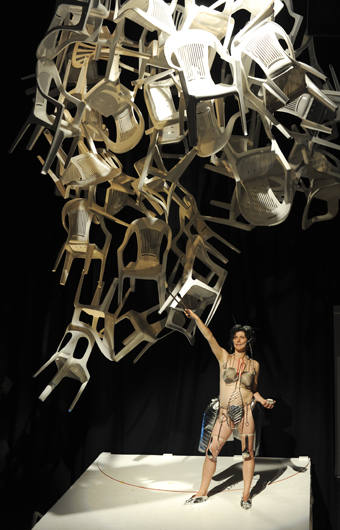
Mirabelle Wouters, Bargain Garden
photo Heidrun Löhr
Mirabelle Wouters, Bargain Garden
RECENTLY A TWO-DOLLAR SHOP APPEARED AT THE END OF MY STREET. INITIALLY I RESOLVED NOT TO ENTER THE PLACE, BUT THEN I NEEDED SOME STRIPED LAUNDRY BAGS. NOT LONG AFTER THAT I NEEDED SOME COAT HANGERS. SOON AFTER THAT…WELL, YOU SEE WHERE I’M GOING. IT’S PRECISELY THIS COMBINATION OF REPULSION, SEDUCTION AND REGRET THAT THEATRE KANTANKA, WITH THE HELP OF ENSEMBLE OFFSPRING, SET OUT TO INVESTIGATE IN THEIR LATEST PERFORMANCE PIECE, BARGAIN GARDEN.
The show begins outside Carriageworks’ Track 8, where Katia Molino delivers a poetic monologue in which she is spruiker, ringmaster and seducer all at once. When she finally permits us to pass, we find a mid-sized black box theatre with concrete walls that has been transformed into an immersive installation. Ethereal noises emanate from a number of unseen speakers, pinging left and right, front and back, luring the audience in to explore all parts of the room. To my immediate right is a ramp, which mirrors another on the other side of the room; further in, a large cube, which also serves as a screen; opposite is a raised platform, on which stand two musicians.
From here, the performance proceeds through a series of scenes that seek to evoke a mood rather than tell a story. In one scene, performer Kym Vercoe incants a list of toxic chemicals with increasingly long and complex names in a ritual that falls somewhere between spell and spelling bee. In another scene, Teik-Kim Pok embarks on an explicit monologue about his lust for white plastic chairs, the sort you see in suburban backyards, at school fetes and outdoor weddings. Here they hover above him in a striking sculptural installation that recalls Wang Zhiyuan’s Thrown to the Wind (2010, RT98) and Tara Donovan’s styrofoam cup clouds. Later, the naked cast walks through a forest of items dangling from the ceiling. Dressing themselves in dog mats that become Elizabethan collars, plastic steaks that become breastplates etc, eventually all are bedecked in a pile of trash. They finish the scene standing in the cube, like some strange royal family readying itself for the crapocalypse.
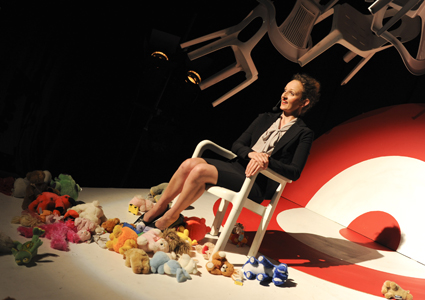
Kym Vercoe, Bargain Garden
photo Heidrun Löhr
Kym Vercoe, Bargain Garden
Sandwiched between these theatrical moments are more subdued ones where our attention turns to the screen and we watch the hypnotic images of colour, text and animals. Sometimes the screen rises to reveal a tableau. This could all be too chaotic were it not for the unifying structure of Ensemble Offspring’s soundscape. Throughout the piece, synthesised sounds rise and fall as talented instrumentalists (Claire Edwardes, Jason Noble) employ a series of toys, homemade and professional instruments, plastic dishes, whistles, keys and effects, all manipulated with sensitivity and style. But the sound is more than mere enhancement for the performance—from the cheerful opening “welcome shoppers” announcement to the haunting final chords, the music here is an equal partner with the text, actors, movement and space, weaving the elements together into an at times almost overwhelming sensory experience.
In one of the final scenes, a woman (Mirabelle Wouters) gets down and dirty with an enormous teddy bear. On the one hand, it’s a neat inversion of the Hollywood cliché where the guy wins an oversized stuffed animal for his girl at the fair (Ferris wheel scene optional). On the other hand, it seems a rather literal comment on how we’re going to be screwed by our love of crap. This could be said of the performance more broadly, but in the end it is too funny, clever and self-conscious for the complaint to hold much weight. Excess begets excess and it would be impossible to craft a performance about it without in some way capitulating to it. Indeed, it’s almost impossible to write a review without succumbing to this fever, as I discover when drafting this review, my mind full of alliterated headlines along the lines of “a tsunami of trash” and a “carousel of crap.” Bargain Garden is infectious stuff, in every sense of the word.
Performance Space: Theatre Kantaka with Ensemble Offspring, Bargain Garden, direction and original concept Carlos Gomes, performers, devisors, designers Katia Molino, Rodney Nash, Justin Shoulder, Kym Vercoe, Carlos Gomes, Mirabelle Wouters, Teik-Kim Pok, devisor (creative development) Brian Fuata, musicians Claire Edwardes, Jason Noble, musical director Damien Ricketson, film director Yana Taylor, sound engineer Bob Scott, text Katia Molino, Carlos Gomes, video photography Heidrun Lohr, video programming Nick Wishart, video documentation, editing Marin Fox, lighting Mirabelle Wouters; Performance Space, Carriageworks, Sydney, Nov 1-5, 2011
RealTime issue #107 Feb-March 2012 pg. 36
© Caroline Wake; for permission to reproduce apply to realtime@realtimearts.net
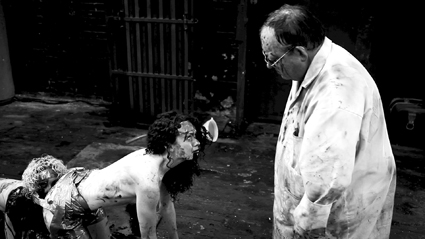
The Human Centipede II (Full Sequence)
SOMEWHERE RIGHT NOW, SOMEONE IS PERFORMING ACTS OF UNIMAGINABLE HORROR. FORTUNATELY, YOU WILL KNOW NOTHING ABOUT IT. SOMEWHERE RIGHT NOW, SOMEONE IS MAKING A FILM DEPICTING UNIMAGINABLE ACTS OF HORROR. FORTUNATELY, YOU WILL NOT EVEN KNOW WHERE IT SCREENS. AND SOMEWHERE RIGHT NOW, AN AUDIENCE IS ENJOYING AS ENTERTAINMENT A MOVIE DEPICTING ACTS OF UNIMAGINABLE HORROR. FORTUNATELY, YOU WILL NOT KNOW WHAT IT IS LIKE TO SIT WITH SUCH PEOPLE AND SEE THINGS AS THEY DO.
A film that saliently outlines these concentric rings of cinematic consumption is Tom Six’s The Human Centipede II (Full Sequence) (2011). It’s a story of a dysfunctional young guy (abused, overweight, catatonic parking attendant Martin, played by Laurence R Harvey) who slavishly re-watches a DVD of the original Human Centipede (2009) with firm intention of performing for real that film’s grotesque operation of ‘sequencing’ humans together by surgically grafting each mouth to an anus so as to produce the titular entity. Despite the film’s unforgiving literality, HC2 is an unsettling synecdoche of how action in life is replicated in movies, and where their cinematised reception leads.
But do not confuse my thesis with A Clockwork Orange-era treatises on violence, society and the media: such arguments are anthropologically engaged in a minuet for the intelligentsia’s liberal critique of failed social utopias. HC2 is unapologetically amoral in its discourse on the same: it forgoes social outcomes, aware that it is mired in the fiction of its own construction. Therein it perversely mirrors (in the true Hadean sense) the concentric rings of cinematic consumption, not to show how images ‘control’ people, but how people are imaged by their actions, plus how imagination affects action. Martin perceives that what he sees depicted in the first Human Centipede is not real, yet possible. And this despite the flagrant impossibility of such a project. Yes, HC2 is playing out an offensive joke in mocking how those of diminished intellectual capacity ‘might’ copy what they see on the screen—but is the world today not full of women who ‘copy’ the Sex and the City franchise and men who copy the The Bourne Identity franchise, each while holding down disempowering corporate jobs? Furthermore, isn’t cinema the deluded party in believing its own hype, professing to be such an all-controlling medium in the first place?
If someone right now is performing acts of unimaginable horror, where exactly are such acts not occurring? The answer is the world that cinema—as a socially responsible vehicle—validates. It is saturated with medical and forensic saviours and teams who are righting the world by evidencing the precise technicalities of how one takes care of the world. From ER through to CSI and innumerable reality shows, that second concentric ring swells with men and women depicting how unimaginable horrors can be neutralised, cauterised, anaesthetised. It’s never messy, and it’s always designed to maintain faith in such professions. Why? So you’re reassured that when you get cancer, have a miscarriage, lose a lover or parent, you’ll have someone to turn to.
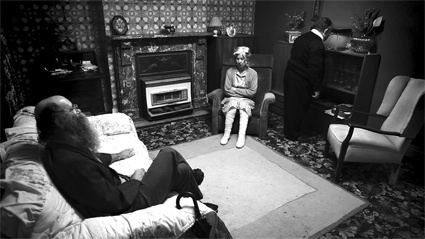
The Human Centipede II (Full Sequence)
In HC2, Martin has no-one to turn to: he is the abject embodiment of the ‘do-it-yourself’ man. It is no accident that Martin is ‘inspired’ by a doctor, and that his instruments are not from the hospital but the hardware store. Reversing the original slasher/maniac movies of the 80s, his modus operandi of box-cutter knives, staple guns and duct tape is a retrograde operation expected of someone with more limited means rather than Hollywood’s limitless resources. Serial killers in today’s ‘torture porn’ have tools sharpened beyond even the ability of master Samurai sword makers; Martin’s tools are as blunt as his methods.
Fortunately, I experienced the third concentric ring with HC2, watching it with a full audience at a preview at Melbourne’s Nova cinema, organised by the film’s distributors Monster Pictures on the eve of their resubmission of the film to the Film Classification Board (which rejected it but allowed a release subject to cuts). Crucially, the film was introduced by Laurence R Harvey; weirdly, Harvey charmed the audience. He spoke simply and eloquently, always mindful of his role as an ‘entertainer,’ and fielded questions in a disarmingly informative manner. Now everyone there knew they were in for something gross and vulgar, but their encounter with this, well, nice guy was a surprise. Even stranger, the film absolutely sides with Martin—not simply by portraying him as unbalanced due to excessive child abuse, nightmarish motherly rejection and consequent dissolute therapy, but by acutely showing his complete inability to be an agent of action in his pitiful world.
The power of HC2 lies in its imaginary projection of the powerless attaining power. Martin is effectively silent and invisible; he is neither seen nor heard. HC2 sees things as he does, and in doing so makes us hear him and see him (so long as you don’t look away). For some, cinema is empowerment Harry Potter-style, the hero waving his little-dicked wand amidst the software algorithms of hi-end VFX. For the audience at the HC2 preview, cinema is about disempowerment, as Martin wraps his little dick (yes, we saw it) with sandpaper and barbed wire as he masturbates and humps in a desperate display of sexual gratification. (Both brief scenes have been edited from the current release version in accordance with the FCB’s suggested changes. No worries: we still get Martin in all his impotency.)
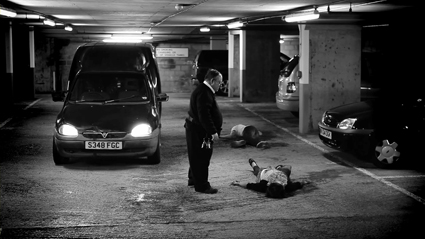
The Human Centipede II (Full Sequence)
In his infamous essay What Is It? (2006), Crispin Glover ponders why we did not see the purported self-made video statement of Eric Harris and Dylan Klebold who perpetrated the Columbine High School shootings in 1999. He laterally ponders the ramifications of such content entering into this thing we call cinema. Glover went on to realise such a dream when he co-directed with David Brothers It Is Fine. Everything Is Fine! (2007), based on cerebral palsy sufferer Steven C Stewart’s film script about his having sex with beautiful women, then strangling them all because he knows they think he’s an ugly invalid. The film stars Stewart himself, and thanks to Glover’s aim to allow the unimaginable to be imagined, Stewart gets to live out his fantasies for real in this cerebral palsy hard-core tale. HC2 is that kind of film: it grants the incapable Martin the power to do exactly what he wants with the only means available to him. Isn’t that what Steven Spielberg has been telling us to do all along?
The Human Centipede II (Full Sequence), writer-director Tom Six, Six Entertainment Company, 2011
RealTime issue #107 Feb-March 2012 pg. 26
© Philip Brophy; for permission to reproduce apply to realtime@realtimearts.net
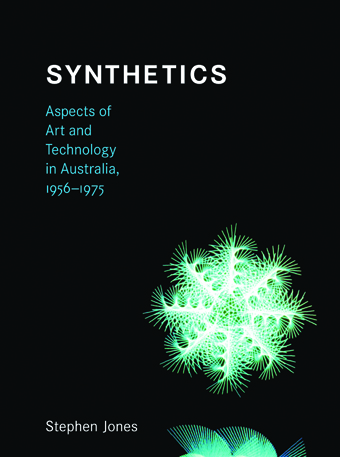
Stephen Jones, Synthetics. Aspects of Art and Technology in Australia, 1956-1975
STEPHEN JONES’ SYNTHETICS: ASPECTS OF ART AND TECHNOLOGY IN AUSTRALIA, 1956-1975 IS QUITE AN ACHIEVEMENT: 400 DENSELY PRINTED PAGES ABOUT THE EARLY LIAISONS BETWEEN ART AND TECHNOLOGY IN AUSTRALIA DURING A 20-YEAR PERIOD.
Being an archaeologically oriented researcher myself, I can imagine what an enormous amount of work, patience and self-denial it has taken just to locate all the sources, to conduct the interviews and to trace countless ephemeral tips. Painstakingly compiling such a massive patchwork of forgotten pieces of information goes against the ‘quick & easy’ spirit of the times. There is life beyond the blogosphere, fortunately.
The title modestly claims that the book presents “aspects” of its topic, but Jones has done much more: he has written a full history to complement the well-known general accounts of art and technology by Burnham, Popper and others, most of which have very little to say about Australia. Jones rolls out a seemingly endless parade of artists, engineers, devices, software and—last but not least—artworks, saving them from oblivion. Ignoring Australian achievements will no longer be possible. This also applies to Australia: Jones notes several times how the field he has reconstructed has been neglected by local art critics and the official art world alike.
Although I have worked on this field for nearly 30 years in Europe and the United States, almost everything in Synthetics is totally new to me. Another book in the Leonardo Series, White Heat Cold Logic: British Computer Art 1960–1980 (eds Paul Brown, Charlie Gere, Nicholas Lambert, and Catherine Mason, The MIT Press, 2009) serves as a comparison: it covers similar little-known developments in the UK during much the same period. However, there is a difference: White Heat is a heterogeneous collection of documents and approaches, but Jones has single-handedly produced a unified vision. Calling the book Synthetics (the name of a 1998 symposium) is well justified. Himself an electronic engineer and media artist, whose own career started just as the period his book covers was coming to a close, and now an historian, Jones is up to the Herculean task he has undertaken.
Synthetics covers “art that in some manner utilizes technological (and especially electronic) means in its realization.” This includes a huge array of things: computer graphics and animation, kinetic art, technologically enhanced dance, video art, (early) interactive art and even comments on artist-designed posters. Jones chronicles his topic in meticulous detail, to the extent that some readers might find his discourse at times exhausting. However, in this context such meticulousness can be justified, not only because so much has been missing from the history books, but also because the various cultural forms the book discusses were often linked with each other.
Jones has tried to take anything essential into consideration, starting from the general cultural atmosphere within which his chronicle unfolds. It is a story of relative isolation, breached by the arrival of immigrants, travels abroad, occasional exhibitions of foreign works, international art magazines and the enlightened visions of a few perceptive critics, most notably Donald Brook. Thanks to such openings, small but effective, the Australian development unfolded parallel to those in other countries, albeit with occasional asynchronicities that can be explained by local circumstances.
The story that emerges is one of collaboration, between artists and engineers, but also between the artists themselves, who formed influential groups like Optronic Kinetics (formed at the Fine Arts Workshop, aka The Tin Sheds of the University of Sydney) and Bush Video (which Jones himself joined). Alongside such collectives there were staunch individuals pushing ahead despite a lack of widespread public recognition or support. Jones draws impressive profiles of interesting creators like the maverick light artist Stan Ostoja-Kotkowski, an immigrant from Poland.
For a foreign reader the book raises a question about the originality of the Australian contribution: was there something truly extraordinary, something that deserves a special place in the general annals of the field? Jones rarely makes such claims, leaving it to the knowledgeable reader to draw the conclusions. Of course, quite a number of Australian artists have been active internationally on the field of art and technology, but most of them rose to prominence after the period the book covers ended. For example Stelarc, one of the most celebrated international figures using “technological means” in his art, is mentioned in the book only briefly, because he was still at an early stage of his formidable career.
While much of the activity discussed by Jones parallels and often reflects international developments, there are features that stand out. One of them is the frequent use of the Theremin, a pioneering musical instrument, as an interface device in early interactive art projects. Ostoja-Kotkowski was one of the artists who made interesting experiments with it, but perhaps even more intriguing is the work of the dancer Philippa Cullen (1950-75), whose very short career (she died at the age of 25) was packed with intense activity, experimentation and collaboration.
Cullen was determined to reverse the dancer’s normal subordination to music, and turn bodily movements into a source and trigger for sounds (and in some cases, electronic images). This led her to experiment with theremins, pressure-sensitive floors and biofeedback. A grant from the Australia Council for the Arts allowed Cullen to travel abroad, collaborating with Karlheinz Stockhausen in Germany and learning ethnic dance from a major international figure, although, as Jones indicates, it is uncertain which direction her work might have taken: further toward art and technology or toward community activism.
In the era of Facebook and blogging Jones’ book may be a bit much for some readers to digest. But this should not be considered a problem. It can be read in smaller portions as well. In fact, it contains several intriguing mini-histories, such as the account of the origins of digital computing in Australia (chapter 3). In a way this is a book that had to be written, and it had to be written in meticulous detail. Jones has accomplished the task with exact and balanced discourse, which is totally alien to prohibitive jargon. Even the many discussions of the technology the artists and engineers experimented with are understandable without expert knowledge; for some readers this may be the best part.
All in all, Stephen Jones should be congratulated for what he has achieved. He has written a substantial book that is both one and many. It will no doubt become the standard work about its topic. Now it is up to others to draw the links with later Australian developments and to continue the discussion about parallel developments, connections and communications.
Stephen Jones, Synthetics. Aspects of Art and Technology in Australia, 1956-1975, Cambridge, MA: The MIT Press, 2011
RealTime issue #107 Feb-March 2012 pg. 27
© Erkki Huhtamo; for permission to reproduce apply to realtime@realtimearts.net
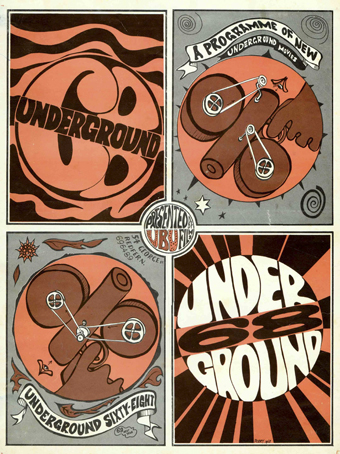
Ubu Films Poster, 1968
“FOR THE AVERAGE FAN, AN EVENING IN THE COMPANY OF EXPERIMENTAL SHORTS HAS TRADITIONALLY CONJURED VISIONS OF DENTAL SURGERY,” OBSERVED PAUL ARTHUR IN CINEASTE IN 2006. HAPPILY, THE SUCCESS OF THE LAST SEVEN YEARS OR SO OF THE “UNPRECEDENTED OUTPOURING” OF WHAT ARTHUR CALLS “ABSOLUTELY ESSENTIAL NON-MAINSTREAM WORK,” HAS PROVEN THAT THERE ARE AS MANY EAGER NON-AVERAGE FANS AS THERE ARE EMINENTLY WATCHABLE EXPERIMENTAL CINEMA RELEASES.
Beautiful DVD box sets detailing the work of avant-garde film luminaries like Guy Sherwin and John Smith, for instance, have proven that commercial publication need not, in Arthur’s words, “maim experiences of fragile art in the process of making it more available.”
Two very welcome Australian newcomers to this field of “exotic yet user-friendly DVDs” are Sydney Underground Movies: Ubu Films 1965-1970, and The Experimental Films of Garry Shead, published in 2011 by Melbourne-based commercial outfit Contemporary Arts Media (Artfilms). Both DVDs are timely additions to the field of Australian screen history, performing a vital dual function of promotion and archiving for the little-seen world of Australian avant-garde visual culture. Albie Thoms, David Perry, Aggy Read and John Clark formed the Ubu Films collective in 1965 in Sydney, operating as a co-operative that not only made, but distributed and exhibited films throughout the 1960s international circuit of avant-garde film. The DVD provides an efficient survey of work carried out in the collective, ranging from their early burlesques and parodies (Blunderball, 1966; The Tribulations of Mr Dupont Nomore, 1967), through kaleidoscopic handmade ‘cameraless’ animations (Bluto and Moon Virility, both 1967) to complex experimental meditations on friendship (David Perry, 1968 and Album, 1970), pregnancy (A Sketch on Abigayl’s Belly, 1968), underground culture (Infinity Girl, 1968) and Thoms’ major opus, the feature-length Marinetti (1969).
Sydney artist Garry Shead was a member of the extended Ubu clan who also made a series of shorts throughout the early 1960s. The films on the Shead DVD naturally cross over with the Ubu films in many ways: key personnel are shared and there is the same joyful use of film as a medium to inscribe countercultural lifestyle in films whose plots are essentially alibis for diaristic work, such as Ding a Ding Day (1961-1966) and the effervescent group effort The Film (1966-67; also included on the Ubu disc). But there are key differences here; where Ubu’s films lean towards the bawdy and abstract, Shead’s films cleave more to his figurative, expressionist inclinations. Less psychedelic than they are psychological, the works on this DVD collectively reveal the shadowy vein of eros that Shead biographer Sasha Griffin has identified as a constant motif across the artist’s oeuvre.
The release of these DVDs could perhaps be seen as symptomatic of what rock writer Simon Reynolds has called the ‘retromania’ of our contemporary era, whereby an embarrassment of high-tech riches is manifesting, paradoxically, as we are increasingly mesmerised by our analogue past. There are, undoubtedly, some marked contrasts between the context of the vibrant Sydney scene in which Ubu and Shead’s films were made, and the ‘historical turn’ of the information age. These films are the product of an era suspicious of the past (as in Jerry Rubin’s famous ‘never trust anyone over 30’ remark), a period that sought to dismantle backwards-looking traditions and instate in their place a ‘counterculture.’ They were made at a time—almost unimaginable now—where access to the means of audiovisual production and dissemination were mostly outside the hands of everyday people. And, unlike feature films—demographics-tested, continuity-scripted, produced under Fordist divisions of labour for maximum efficiency—these films were often improvised, created with whatever means were available, with the chief aim of contributing to a community ethos of radical alternative entertainment.
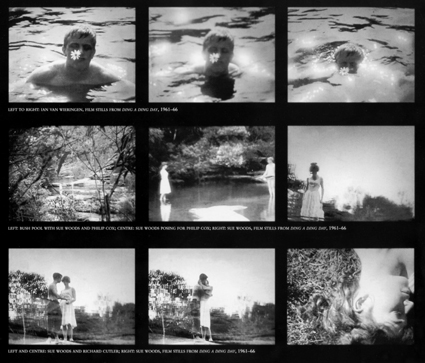
Ding A Ding Day, Garry Shead
For some, there is likely be a certain unease with the films’ capture by the digital—congealing spontaneous moments like so many specimens of a wilder, freer bygone era. On the other hand, along with the vital preservation function, the release of these films on DVD offers us an opportunity to revisit and reconsider the issue of historical consciousness in the art of the 1960s. Garry Shead’s work as a ‘paint’ artist is clearly informed by historical modes (his DH Lawrence paintings, the Royalty series), evident in his film art on this DVD, which draws on the tropes of silent cinema (Four Eyes The Fastest Gun, 1967) and on Australian outback mythology grafted onto the outlaw iconography of classic Westerns (The Stringybark Massacre, 1967). And Ubu, of course, had as their matrix Artaud’s Theatre of Cruelty, to say nothing of their self-consciously atavistic invocation of proto-surrealist Alfred Jarry, from whose 1896 play Ubu Roi they drew their name and pataphysical inspiration.
Perhaps a more compelling explanation than yet more ‘retromania’ for the emergence of these releases, here and now, lies in the reconfigured economic and structural imperatives that have resulted in the lowest ever costs for digital (re)production and sales. As Artfilm’s Kriszta Doczy explained in RT106, recent developments in online selling technology have rendered DVD retail more possible than ever before. While the telecining of the images is not noticeably improved in quality from the much-loved Ubu VHS that was in circulation in the 2000s, this DVD release has the complex advantage of a newly digital existence.
As the bitter international battles between commercial exploitation/intellectual property rights and the internet’s intransigent gift culture continue, two points about peer-to-peer sharing now seem incontrovertible. Firstly, that online interaction and contribution activities are an ineradicable feature of any realistic prediction about the future of media; and secondly, that these practices result not just in the theft of intellectual property, but in the creation of actual economic and cultural value under informational capitalism. The advantage for Artfilms is that, thanks to the new media elision of the distinction between producer/distributor/exhibitor, they are able to distribute these digital publications either as hard copies or streamed online with educational licenses—a major advance as education increasingly moves online. And for the legacy of Ubu—whose collaborative production and exhibition in live, often radical or underground settings infuses the works with the spirit of resistance to commodification—there is something fitting in the thought that these previously unavailable 16mm films are being newly converted to data, which may now be sought and shared by the growing band of people who are discovering the curious appeal of experimental film via the internet.
As any music fan knows, in the era of download culture there is a growing awareness that the gift/theft and commercial models are no longer entirely discrete economic spheres. When we can get films (or music) nearly instantaneously, the purchase of the artefact needs to be motivated by other factors: the object itself needs to impress, a fact London’s Lux have cottoned onto brilliantly with their gorgeously covetable boxsets. The Artfilm releases are attractively but not luxuriously produced, their design taking full advantage of the aesthetics of their respective subjects. The Shead package is dark and brooding, replete with dreamlike film stills that perfectly cue the viewer’s expectation of what’s to come. And, appropriately, the Ubu DVD fairly vibrates with the eye-gouging day-glo aesthetics of David Perry’s poster design, its lurid aqua cover opening to a violently yellow gatefold, an Ubu poster that invites the viewer to “Turn on With Ubu Films.” But with lean extras relying mostly on existing information about the artists, and standard shiny cardboard housing for the DVDs, these releases aren’t trying to attract the packaging fetishist. Their no-nonsense foldout design will, evidently, store easily on library shelves, and, lacking myriad liner notes, booklets and other custom inserts that elevate new bespoke music and film collectors’ editions, are far more likely to be able to be borrowed (and returned) intact by waves of film, new media, art and communications students around the world. For the releases are squarely—and sensibly—aimed at acquisitions officers in public institutions the world over (as Artfilms puts it, they are “primarily a website for academic and public libraries, teachers and students”). Given the paucity of access to this work for students and teachers, the pragmatic targeting of the Artfilm releases is laudable, an ideal opening up of what Paul Arthur terms the “terra incognita” of avant-garde film history to the next generation of inquiring minds.
Sydney Underground Movies: Ubu Films 1965-1970; The Experimental Films of Garry Shead, published by Contemporary Arts Media; http://artfilms-digital.com
RealTime issue #107 Feb-March 2012 pg. 28
© Danni Zuvela; for permission to reproduce apply to realtime@realtimearts.net
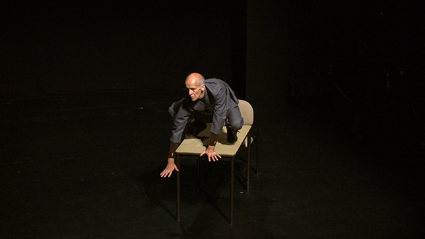
Peter Fraser
photo David Sheehy
Peter Fraser
IF SPINOZA IS RIGHT, THAT WE DON’T KNOW WHAT A BODY CAN DO, THEN THE IMAGE MAY HELP. NOT AS THE SOLUTION, THE RIGHTEOUS PATHWAY, BUT AS A PROVOCATION—TO BECOME OTHERWISE. THE IMAGE LURES THE BODY, OFFERING THOUGHTS BEYOND THE KEN OF THE PERFORMER. IN THIS CONTEXT, THOUGHT IS LESS A PROPERTY OF CONSCIOUSNESS THAN SOMETHING EMBEDDED WITHIN THE BODY. BODY AND THOUGHT GO TOGETHER. THE IMAGE IS A MEANS OF EXPERIMENTATION, ITS COALESCENCE. THE IMAGE EXCEEDS US.
the image is historical
Peter Eckersall (Associate Professor in Theatre Studies in the School of Culture and Communication, University of Melbourne) has a cultural, historical understanding of Tatsumi Hijikata’s performative corporeality, articulated through the experimental medium of film. Film is a manner of experimentation, especially so in 1960s Japan. Temporalities clash: tradition and modernity collide in the emergent chaosmos of Butoh. Much later—now in fact—there are generations of Butoh inspired performers not yet born in the 1960s, nor born in Japan, but for whom Butoh is nonetheless a performative trope.
The performance-symposium, Where the Image Meets the Body, Performing Images in Butoh and Other Dance Forms, emerges from this younger generation. Not that there aren’t genealogies spanning from Hijikata through Min Tanaka, Kasuo Ohno and others. What makes a work Butoh is a complex question of authenticity, corporeal transmission and bodily discipline. It is an issue upon which I have no authority whatsoever. But I can say the following. I witnessed a debate in one of the symposium breaks, between two views: a more historically informed perspective and a freer attitude, less concerned with authenticity, discipline, than inspiration, fun even. The issue leads to the question: can any performance practice call itself Butoh? What is at stake in the name, articulated across the Pacific, over decades? Would a performance work have the same resonance were it not to call itself Butoh? Given my ignorance, I must remain agnostic, save to raise the question of role tradition and transmission within corporeal art, even with respect to an avant-garde art form such as Butoh. By imaginatively exploring Min Tanaka’s visit to Dehli, Saumya Liyanage (University of the Visual and Performing Arts, Colombo, Sri Lanka) looked at issues of intercultural transmission, through phenomenology’s lived body, including Liyanage’s own performative body.
Peter Eckersall‘s turn of phrase, “militant alterity”, combines politics and culture in Hijikata’s corporeal becoming. Eckersall speaks of activating instability as a means to produce difference within performance. The performer is not in control. If the militant arises from a specific historical milieu (in 1960s Japan), what kind of possibilities for radical otherness exist today? If a radical otherness is a possibility, it will perforce be different. Hence, the notion of the image for this symposium, as a strategic device to produce difference within performance.
the image is a strategy
Three dance papers look at the image in strategic terms, apart from the influence of Butoh. Oldest in origin is the Buddhist trope of the elements. Kim Sargent-Wishart (a movement artist, educator and researcher working on a Practice-Based PhD in Performance at Victoria University) looks at the five elements (earth, water, fire, air/wind and space) as metaphysical modes of transformation which were utilised in the studio in the manner of research-creation (as promoted by Erin Manning and Brian Massumi). Sargent-Wishart worked with a number of dancers at an embodied level, to give the body an opportunity to lead investigation. Elizabeth Dempster (Lecturer, Performance Studies, Victoria University) referred to Mabel Todd’s seminal work on the image which first found expression in The Thinking Body and ultimately founded ideokinesis. Dempster noted the importance of the way the image is introduced—as always becoming, active, never finished. It is a gerund, an event which becomes in the body. My own paper referred to Nietzsche’s critique of subjectivity (as habit) and the way in which the image may be used to strategically overcome the tendency towards habit. Alexander Technique offers an illustration of the way in which direction, as image, is used to inhibit/overcome habit. In all three papers, the image, whether anatomical or elemental or directional, invites a kind of becoming in the body.
the image in performance
Where the Image Meets the Body combined performance and spoken word, Peter Snow (Professor and Director of the Centre for Theatre and Performance, Monash University) took the domain of performance as his object of investigation, speaking as an observer of images, as one who investigates the activity of performance, its intensity, fragility, its relation to culture. Snow does not enclose performance but rather looks to its specificity, its relation to the flicker of memory. The actress Billie Whitelaw is cited in close proximity to Samuel Beckett’s work. She speaks of performance in the mode of being “not I.” I am reminded of Beckett’s Film, where the protagonist scuttles evasively so as to avoid being caught. As if the film-image would immobilise the butterfly-subject, sticking it in a frame for all time.
The image in this context is more mutable than that. It is a figure of transformation and transmutation. Several performers spoke of their relationship to their own work and the function of the image. In many cases, the work is seen to offer something beyond the performer’s understanding. Choreographer and performer Frances Barbe spoke of her performance as not quite her own, as offering a kind of displacement or decentring. Indeed, Barbe’s movement suggested a degree of alterity within, a commitment to quality as intensity. Alice Cummins (dance artist, Body-Mind Centering® Practitioner and movement educator) evokes the multiplicity of relations that lie beyond the performer’s distinct being. Body Weather-trained performer Linda Luke allows the image to inaugurate a series of questions, openings. And performer Helen Smith orients her performance to the several Japanese masters with whom she trained, orienting different moments through the seasons. Choreographer Sarah Neville works with new media, remaining open to improvising, to the vicissitudes of performance, allowing technology to open up new possibilities.
Coming to perform, Body Weather-trained Peter Fraser flickered between a kind of becoming-animal and becoming-human. The lizard is our ontogenetic ancestor. Sinuous homolateral slitherings eke out the lizard’s progress. But the lizard becomes human through courtly gesture, within a space pre-determined by the Renaissance grid. Man is a cultural being yet animal still, occupying a liminal space between the two. The lizard perches on a desk, like anthropologist Mary Douglas’ matter out of place. Performer Nikki Heywood also worked with the animal-human nexus, playing with a fabricated head made for the theatre. Heywood’s combination of formal attire and dead animal parts is disturbing. It disturbs the identity of the performer and makes me uneasy, sad for the spectre of the animal head.
The solos of Linda Luke and Alice Cummins both made visible the performer’s effort to create difference, to do more than repeat the familiar. Luke spoke of the image as a means of overcoming. Her fine work had an intensity, a dedication in movement. Cummins’ piece was a dark intensity, in contrast to the luminosity of film, images of Cummins from another time and place. The work flickered, recalling Snow’s discussion of fragility as the risk inherent in all live performance. Robert Lewis (Lecturer in Voice and Movement, Academy of the Arts, University of Tasmania) presented two committed performers, Laura Bishop and Chris Jackson, grappling live with the demands of the moment. Finally, Helen Smith, with A Dance for All Seasons, presented the affect of time, taken through the seasons and the inflexions of her multiple Butoh masters—an appropriate way to end the performance component of the afternoon.
Thanks to convenors Stuart Grant and Ellen Rijs, whose positive energy extended throughout. While I am probably no clearer on what is an image, I have seen a little of what an image can do. And that’s what counts.
Where the Image Meets the Body, Performing Images in Butoh and Other Dance Forms, Centre for Theatre and Performance, Monash University, Melbourne, Nov 3-4, 2011
RealTime issue #107 Feb-March 2012 pg. 30
© Philipa Rothfield; for permission to reproduce apply to realtime@realtimearts.net
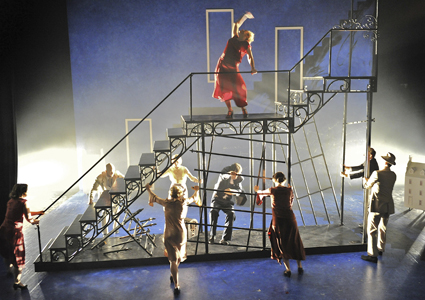
Septimus and Clarissa, Ripe Time
photo Richard Finkelstein
Septimus and Clarissa, Ripe Time
LONDON, JUNE 13, 1923: A WOMAN IS ROUSED FROM SLEEP. THE GREAT, VIBRANT, TEEMING CITY HAS NOT BEEN SHATTERED BY THE GREAT WAR—IS IT REALLY OVER?—BUT SHE AND HER CITY HAVE BECOME FRAGILE, SHAKEN. OUTSIDE HER WINDOW, FRAGRANT FLOWERS STILL BLOOM; SLEEK CARS GLIDE. INSIDE, HER SERVANTS HAVE ALREADY BEGUN PREPARATIONS FOR HER PARTY.
Mrs Dalloway is what some writers call Virginia Woolf’s take on James Joyce’s Ulysees—a short stream of consciousness novel with an upper class housewife and young war veteran in place of Joyce’s protagonists. Whilst there are definite actions in the novel—the party to be prepared for, soldiers back from the war, businessmen from the colonies—the underlying structure of the work is like a weaving between conscious and unconscious worlds, between history and memories, missed moments, excitements and enervations. The narrative is like a psychic geology, formed out of sensations and insinuations. In between the comings and goings of her self, her husband, ex-lover and others, it weaves from the surface of Clarissa Dalloway’s psyche through to the beauty, mystery and terror of the sub-terrain.
At the same time, it is also the story of Septimus Smith, a shell-shocked veteran five years’ returned from a war most can’t mention. The narrative folds through layers of his hyper-calibrating consciousness as well.
New York troupe Ripe Time arranges this narrative of two parallel lives in an intertwining of bodies, voice, sound and space with such finesse that it reminds me: theatre matters. We participate, body to body, mind to mind in a 3D space that revolves within and before us. We feel this process remorselessly as the actors’ insides turn out, thoughts playing in muscles and along their skins. As in the greatest of physical theatre practices—from Le Coq to Theatre de Complicite to Les Ballets C de la B—we are brushed against, and bruised by their energetic proximity.
A rotating right-angled triangular scaffold, with stairs running up the hypotenuse, defines the space, with Clarissa’s bedroom and commanding sentry-point at the top of the stairs, dining and ballrooms below, streetscape just beyond. Septimus’ enclosed tenement beneath is an apt metaphor for his caved-in mind. The structure is also the hillside where Septimus and his soldier-friend, Evans, killed by mortar shell, once shared poetry, and where Evans’ ghost, a spider-poltergeist, now chases Septimus down its incline. It is both a scaffold for memory and a monkey-bar for tormented clambering.
This adaptation is a ‘period’ piece, yet the company’s stated drive is to represent the effects of Post Traumatic Stress Disorder on contemporary soldiers returned from the recent Iraq and Afghanistan wars. The psychologists Woolf portrays with lacerating scepticism are depicted here, one as a blustering man of straw, the other a suffocatingly self-assured roly-poly at the top of his professional tree. Septimus is like a red hot bowling ball amongst them; ironically only Clarissa, from a distance, not witnessing but only hearing about his death, begins to understand. Scenes which include Septimus’ wife depict a frightened dove fluttering between immutable monoliths, amongst chaos. She tries to wrap Septimus with her words and hands, but he cannot access her comfort. Finally, he races up the stairs to escape the doctors and throws himself from the balcony. The frozen moment of his leap out at the audience burns with his agony.
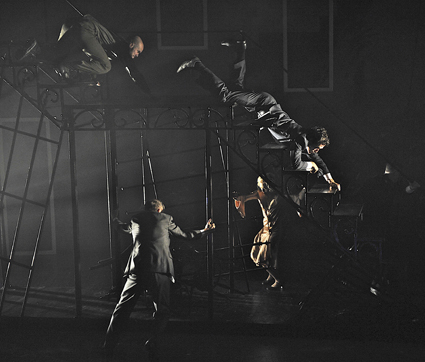
Septimus and Clarissa, Ripe Time
photo Richard Finkelstein
Septimus and Clarissa, Ripe Time
The socialite Clarissa’s softer world also harbours the winds of doubt and agitation. While for Septimus, nature whispers urgings through his nerves, for Clarissa the colour of flowers, the patterns of the street, the doubts and missed moments in her relationships also paint questions in her mind. What is most moving in this stage adaptation is that the workings of consciousness become so deftly rendered in the actors’ mellifluous physical work, in Ellen McLaughlin’s script and Gina Leishman’s piano score, that we recognise the intertwining of mind and matter as a human trait shared by all. Septimus and Clarissa share a continuum—although Clarissa’s shell is thicker, and fate has dealt her a safer reality.
New York Live Arts was founded in 2011 by a merger of the Bill T Jones/Arnie Zane Dance Company with the Dance Theater Workshop—two companies with rich histories. October’s curated Dancer Crush stirred the great postmodern dance archive, revisiting and reforming some classic works alongside new work in development. It was fascinating to watch great dancers working through, with and against some of their legacy. A few pieces in particular worked some sharp edges.
Ishmael Houston-Jones, a strong, squarish man of nearly 60, is in the hot seat whilethree 20-somethings sit in chairs directing his actions with three single-word commands. Houston-Jones is caused to move, speak or freeze, and often left hanging. Whereas Septimus and Clarissa [and Woolf] tease the question, “How am I shaped by things?”, Houston-Jones’ question seems to be, “how does this information change how I give shape to things?”
The piece is a simple construction but he shows the depth of his experience and his comfort with edges. Caught hanging on one leg, he quips: “I’ll be the one to subvert the rules/I can stop payments on their cheques any time.” To his audience: “The last person who sat there on Saturday was terribly embarrassed.” To another, caught very close, sotto voce: “You have lovely eyes.”
Bill T Jones insists “the intellect is always present in the act of performing movement.” Leah Cox re-creates Jones’ solo Floating the Tongue, a piece which requires the dancer to quote the phrases (of speech and movement) of several choreographic giants, whilst weaving a continuous dance and running commentary. Cox’s interpolations show an ability to inflect homage and repetition with a sparkling, teasing wit, lifting quotation into brilliance. It is as if, mid-contest, Davida emerges from behind Goliath, drops her rock and gleams.
Finally, a sad clown crowns them all. David Neumann‘s hapless, suited man enters, then falls over his only prop (a chair) while the Voice of God gives a running commentary on how inept he is. The man keeps trying to right the wrong but only fails the commands. The voice is a projection of the inner voice, provoking, judging, measuring him. The man takes his own pulse; nothing helps. This is like a Joycean day which just won’t end well. But the postmodern condition is one of knowing it will end, that the stage is just a stage. The strong, canny body laughs, darts and exits. The joke, cheerfully, ends on us.
Ripe Time, Septimus and Clarissa, adapted from Mrs Dalloway by Virginia Woolf, writer Ellen McLaughlin, direction, development Rachel Dickstein, music Gina Leishman, design Susan Zeeman Rogers, costumes Oana Botez-Ban, lighting Keith Parham, sound Jane Shaw; Baruch Center for Performing Arts Sept 7-Oct 8; Dancer Crush, curators Carla Peterson with Annie-B Parson. New York Live Arts, Oct 8, 2011. The event also included works scored by Merce Cunningham, Trisha Brown, Yvonne Meier, Tere O’Connor.
RealTime issue #107 Feb-March 2012 pg. 31
© Zsuzsanna Soboslay; for permission to reproduce apply to realtime@realtimearts.net
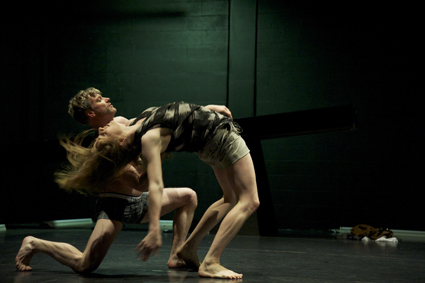
Gerard Van Dyck, Jacqui Claus, Shiver
photo Ashley de Prazer
Gerard Van Dyck, Jacqui Claus, Shiver
“IF NINE SPOKEN-WORD PIECES OUT OF 10 WILL BE IMPROVED BY THE ADDITION OF MOVEMENT SKILLS,” MELBOURNE DANCE CRITIC CHRIS BOYD WROTE AT THE CONCLUSION OF THE 2008 MELBOURNE INTERNATIONAL ARTS FESTIVAL, THEN “NINE MOVEMENT PIECES OUT OF 10 WILL BE TURNED TO STONE BY THE INCLUSION OF THE SPOKEN WORD.”
Boyd’s Law, as I came to think of it, served as the opening salvo in his critique of the festival’s patchy dance theatre line-up, which that year included below average work by Chunky Move, Lucy Guerin Inc and KAGE. Wendy Houstoun’s Happy Hour and Desert Island Dances were the most accomplished shows in the increasingly ubiquitous category, but even they wound up proving the first and second clauses respectively of the critic’s dictum.
The thrill that one gets from finding the one-in-10 exception to the latter of those clauses is directly proportionate to how often one does so. It almost goes without saying that the thrill is very great indeed.
Danielle Micich’s Shiver doesn’t quite provide it. The independent choreographer’s latest work, which spent much of its five-year development biting its tongue, hasn’t exactly been turned to stone now that it has learned to speak. But it is nevertheless less nimble on its feet than it might previously have been, more fragmentary and choppy, with a lengthy monologue towards the end, in particular, damming the natural flow of the piece. Worse, both the monologue and earlier instances of speech, such as that in which the dancers enter and start filling out personal questionnaires, reading the pop-psychological questions aloud and laughing at one another’s answers, render the themes of the piece too explicit. The problem with speech acts of this kind is not that they lessen the amount of movement in a piece, but that they reduce the potential meanings that movement might take on. The dancers’ bodies are denied their contradictions, their nuances and their possibilities, and the audience is denied the right to interpret any of the above.
Admittedly, much of the movement in the piece is explicit, too, tending rather more towards figuration than abstraction. And it wouldn’t be a stretch to describe the movement as a kind of physical narration. Performers Gerard Van Dyck, Leanne Mason, Jacqui Claus and Lewis Kilpatrick enter one at a time via conveyor belt. Naked but for their underwear and standing upright, they remind one of the awkward looking family of four replicated ad infinitum in the animated opening credit sequence of Monty Python’s Meaning of Life: “Or are we just simply spiralling coils of self-replicating DNA-A-A-A?” The performers proceed to dress in the clothes provided and to fill out the questionnaires, which ask them about the times they were most happy, sad, scared and so on. Their memories now jogging, they begin to move too. Indeed, Shiver is more than anything a kind of memory play: even when the choreography is more joyous than tortured, as when Van Dyck and Mason engage in a slow, highly emotional pas de deux, the sense one gets is less of watching a bridal waltz than of the echo of one. Only during Claus and Kilpatrick’s lusty duet towards the beginning of the work is there any sense of immediacy or of watching something unfold in the present.
As that last sentence suggests, the relationships between the characters do occasionally shift and change, but in general the age and gender breakdown of the performers evokes a nuclear family, and the aforementioned monologue ensures that this reading remains dominant. Delivered with great restraint by Mason, her role as mother confirmed beyond doubt, the monologue in question tells the story of a day at the beach, during which a child is accidentally killed. Emotionally moving and thematically relevant, it is also overkill. Kilpatrick’s character dies more or less concurrently and the ritual by which the performers prepare his prostrate body in death is more mysterious and affecting than the words preceding it.
The performers return Kilpatrick to the conveyor belt: the end of the factory line now becomes the mouth of the crematorium furnace. Moments later, Kilpatrick returns, standing upright again. At first I was not so sure about this denouement, feeling that the theme of loss would be better served by the performer’s palpable absence. The more I’ve thought about it, however, the more his understated return feels appropriate. As with Van Dyck and Mason’s memory of romance, Kilpatrick’s passing, like the monologue, is a recollection: he’s already dead.
The others may well be dead too, in which case this belt-fed room is a purgatory in which memories reconstitute themselves for a moment: courtship, companionship, family, loss. These memories all have one thing in common: they are born exclusively of love. Indeed, if Shiver could have done without the spoken word, then this review could have done with fewer written ones. It could and probably should have consisted solely of Philip Larkin’s assertion: “Our almost-instinct almost true: What will survive of us is love.”
Shiver, director Danielle Micich, performers Jacki Claus, Lewis Fitzpatrick, Leanne Mason, Gerard van Dyck, sound Kingsley Reeve, lighting Joseph Mercurio, producer Performing Lines WA, Dolphin Theatre, University of Western Australia, Perth, Nov 17-19, 2011
RealTime issue #107 Feb-March 2012 pg. 32
© Matthew Clayfield; for permission to reproduce apply to realtime@realtimearts.net
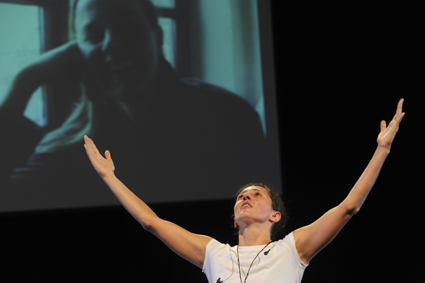
Christiane Hommelsheim (via Skype), Nadia Cusimano, The Runner, Return to Sender
photo Heidrun Löhr
Christiane Hommelsheim (via Skype), Nadia Cusimano, The Runner, Return to Sender
IN THE COLLECTION OF PERFORMANCES, RETURN TO SENDER, CURATORS PAUL GAZZOLA AND JEFF KHAN INVITED EIGHT AUSTRALIAN DANCE-MAKERS TO CHOOSE, REDESIGN AND PERFORM A SPECIFIC WORK MADE PREVIOUSLY BY AN INTERNATIONAL PEER. THIS PROVOCATION FORCED THE DANCE-ARTISTS TO ENGAGE WITH THEIR OWN PRACTICE VIA THE FORENSIC EXAMINATION OF THE WORK OF ANOTHER. FOR GAZZOLA, THE OVERSEAS EXPERIENCES OF AUSTRALIAN ARTISTS AND THE INFLUENCES ON THEM SHOULD BE OF VITAL INTEREST TO A DOMESTIC AUDIENCE RARELY EXPOSED TO MORE OBSCURE WORK.
A booklet was also produced in which each dancer and curator examined their process via a “self-interview” which for the audience was a welcome adjunct to the business of bodies in space. The task was realised in a variety of ways but all the work had a tangible atmosphere informed by notions of absence, sometimes subtle, sometimes emblazoned as a central theme.
Jane McKernan’s Double Act for instance contained only her writing—other performers voiced it each night. McKernan is an original dancer who, as one third of the trio Fondue Set, has demonstrated a flair for comic timing and caustic parody. Double Act showed that she can equally apply these talents to the written word in a piece that mimicked the style of mentor/collaborator, Wendy Houstoun. The roles of her split-psyche discussion (each night performed by a different duo) were voiced on the night I attended by Agatha Gothe Snape and Lizzie Thompson who after synchronising their iPods repeated aloud what they heard. I enjoyed the McKernan mischief in this piece as script directions were projected behind the performers, highlighting her physical distance (she was overseas at the time). This was a dialogue that created some exquisite opportunities to poke fun at the inherent narcissism of the dancer and the perpetual self-reflection of the art-maker.
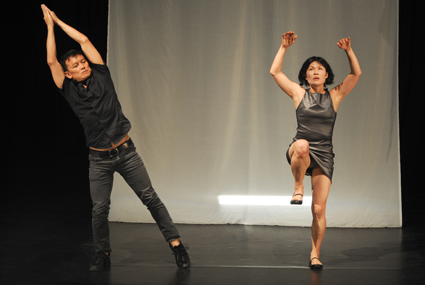
Tony Yap, Yumi Umiumare, ZeroZero, Return to Sender
photo Heidrun Löhr
Tony Yap, Yumi Umiumare, ZeroZero, Return to Sender
I found the booklet useful for understanding the perceptions of the artists: after the performances it was interesting to discover the dichotomies between intention and outcome. There was little evidence of the light and humorous tone of Yumi Umiumare’s self-interview in the earnestness of her ZeroZero performance—an ongoing project with Tony Yap and performed as a duet. Its charter was to explore the possibility for emptiness (as Buddhists might identify it). Matthew Day’s work was also part of an ongoing collaboration with the absent Noha Ramadan (Amsterdam), echoing a Cindy Sherman photo in its opening image. Each moved with an incredibly tensile agility as body memories, in the case of Umiumare and Yap referencing their respective Japanese and Malaysian ancestries, were teased out from thought to action.
The third co-editor of the booklet and the performer of Name To Be Given By The Spectator was Atlanta Eke. She stepped into the performance space inviting us to load up our ears with our iPods. She excused herself to put on her costume and stepped to one side to remove her warm-up outfit. She checked her mobile and entered the space naked, phone in hand. What followed was a series of recognisable ball-change, tap and split-leap sequences common to any conventional dance. Reproducing a solo originally made and performed by Swedish dancer Emma Kim Hagdalh, Eke’s version also explored the inescapable, multiple references the trained dancer-body contains within every attempt at original movement. This was done by immersing herself in repetitive and clichéd sequences of movement style and interrupting them by constantly checking her phone. It seemed like instructions were being sent by text for each segment she performed. Here, the banality of the movement cleverly displaced voyeurism, focusing attention on the anatomical energy of dancing—the confrontation of the revealed body replacing the titillation of an uncovered one.
Displacement and absence took on the appearance of surveillance in the evening’s opening piece, The Runner by Christiane Hommelsheim and Nadia Cusimano. A Skype image of Hommelsheim from Germany was projected onto a large screen above Cusimano’s dancing/singing form in Carriageworks’ Bay 20. The patchy clarity of the internet connection provided some fascinating commentaries and juxtapositions from above: “I saw this interview with…er…Deborah Hay,” the break-up in signal subverting her discourse. “She says ‘in this I/there’s so many things that enter the Second Amendment they make you crazy’ …”. I felt sure that the live-feed interventions arrested Cusimano’s choreographic flow and that her focal point became the exploration of the tuneful and discordant sounds of her singing. “Go!” Hommelsheim commanded a couple of times from Europe, “what if that whole foul knock moment was placed to notice,” the machine said, transforming her voice into a Hawking-esque staccato. And as linguistics were mangled by distance, visceral patterns also disintegrated and trajectories dissolved. But as Cusimano wrote, “The Runner is the performance of a practice not the performance of a dance.” Fair enough.
Alison Currie’s work utilised audience participation and great humour to reinterpret the choreography of New York dancer Pere Faura, while Latai Taumoepeau remembered with grace the spirits and cultural practices of her Tongan ancestors. This was a fascinating night with a powerful curatorial agenda addressing the perennial issue of Australia’s distance from so many centres of the world’s arts practices.
Performance Space, Return To Sender, curators Paul Gazzola, Jeff Khan; Carriageworks, Sydney, Nov 23-26, 2011
RealTime issue #107 Feb-March 2012 pg. 32
© Tony Osborne; for permission to reproduce apply to realtime@realtimearts.net
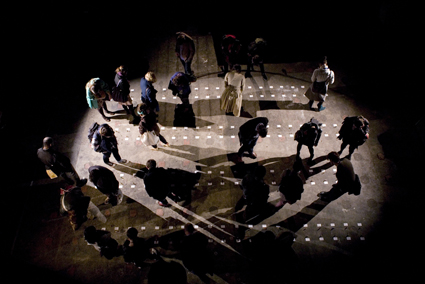
Zilla!, producer Andy Field
photo Ludovic Des Cognets
Zilla!, producer Andy Field
“WHEN JOHN CAGE CREATED 4’33 HE DID SO NOT BECAUSE HE WANTED PEOPLE TO LISTEN TO FOUR MINUTES AND 33 SECONDS OF SILENCE, BUT BECAUSE HE WANTED THEM TO LISTEN TO THE WORLD WITH THE KIND OF CONCENTRATION THEY NORMALLY RESERVE FOR ART. A GOOD SPACE FOR ART IS A SPACE THAT, LIKE CAGE, IS SENSITIVE TO THE KIND OF ATTENTIVENESS THAT IT GENERATES; THE WAY IT IS INVITING PEOPLE TO LOOK.” ANDY FIELD
I first came across Andy Field through his writing. His succinct, poetic observations and rocking passion for art, artists, spaces and people connected with me, as did the assertion in his biography: “I am a giddy over-enthusiast and unashamedly so.” Conversations with Field are infused with political astuteness, intense curiosity, beautiful stories and a passion for innovation as cyclical, best informed by an historically broad perspective.
In August, I observed one component of his diverse practice first-hand, at Forest Fringe: the hot, passionate wild child within the Edinburgh Festival cacophony, which Andy Field curates, directs and produces in partnership with Canadian practitioner, Deborah Pearson.
“My practice—in whatever guise it manifests itself—is to create contexts that bring people together to produce a different experience of the world. That’s the only way I can account for running a festival, organisation and venue—and making my own work. I understand them to be fundamentally the same thing; the constantly unfolding experiment that is running and curating Forest Fringe is a form of creative practice, and the ways in which we go about that are as meaningful a kind of artmaking as the more explicit ‘shows’ that I make as an artist.” Such sentiments resonate with those of another renowned UK producer, Helen Cole, who notes, “a festival is as precarious as any artwork” (see interview RT101).
Says Field, “There is a creative resourcefulness to having to navigate your way through finance and money, that is an integral part of your art. And if you don’t appreciate that your art is being made within a given economic framework, then you’re failing at art, I think. Art is a way of doing things, not the things we have produced. And if you try and divorce the two, one from each other—the context and the process—then you’re not doing it right.
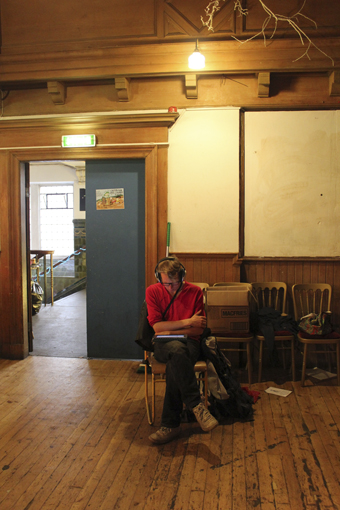
Andy Field, Edgelands Flash Conference
photo Hannah Nicklin
Andy Field, Edgelands Flash Conference
“On the other hand, making work for free, trying to resist the financial imperatives; I often think this has a real radicality to it, that has a real value. I once wrote this kind of glib thing called The Gift Manifesto, which was the idea of radical giving as a significant political gesture—interesting examples being YouTube or street art or musicians who offer downloads of their work for free. I think this has a really special kind of power. It explains why some people get so angry with Forest Fringe—they say we’re devaluing the work by making it all free. And sometimes I think: well too fucking right, let’s devalue the work! Let’s take any economic value out of the work, and understand it on entirely different terms, as a means of social and political shift. You wouldn’t expect to be paid to go on a protest, why should you expect to be paid to do art?”
Field’s practice is informed partly by the theories and practice of John Cage, Allan Kaprow, Robert Smithson and Robert Morris via a current PhD researching 1960s and 70s New York as it relates to contemporary UK performance. But just as important is the education in play (not plays) he received as a child. “I never went to the theatre when I was growing up. Our village was a safe enough environment that the whole place could become a playground; and we gathered together to produce different readings or theatricalisations of that environment as a group—which is a very intellectual way of talking about dicking around in your own village! It’s that direct unconsidered relationship with the real fabric of place that has always been really important, rather than the intellectual distance that comes from the relationship between an audience and something happening on stage. I’ve always been far more interested in the idea that art is the experience of something that is happening to you, rather than something that is happening over there within some circumscribed space—that you are just left to watch and consider.”
Field says that most interesting artistic moments are the product or generation of a particular community. “I think what’s happening in the UK now is that there is enough interesting and interested artists making work that is both similar and different enough. Different people arguing in the same language; coming at the same questions from a variety of different languages; and making work in a bunch of very different ways whilst still being in dialogue with each other. And that’s really exciting. People like Chris Goode, Ant Hampton, Melanie Wilson, Stoke Newington International Airport; curators like Harun Morrison and Laura McDermott at Fierce Festival, David Jubb and David Micklem at BAC, Kate McGrath and Louise Blackwell at Fuel Theatre.”
Participating in Field’s Edgelands flash conference in August, I can attest to the cut, thrust and vibrancy of that dialogue, and Field’s unique ability to gather a diverse yet focused set of minds around a very big question. Field says, “It feels like there is a discourse taking place here, and a sense that artists are trying for the first time in a generation to step up to the plate, and understand and interpret the major economic, political, social and environmental shifts that are going on in our country. You’ve now got a generation of artists in their 20s and early 30s who aren’t old enough to remember Thatcherism; so for the first time, we can think about and reinterpret the ways we negotiate with power, with institutions, and the civic role of art. And out of that, we are seeing really good conversations—and some really good art.”
Andy Field writes regularly for The Guardian and The Stage, and also on his blog: www.lookingforastronauts.wordpress.com. See also www.forestfringe.co.uk
RealTime issue #107 Feb-March 2012 pg. 33
© Emily Sexton; for permission to reproduce apply to realtime@realtimearts.net
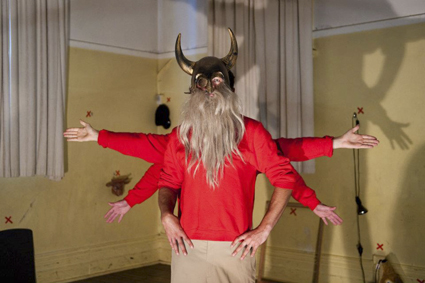
Conor Gallacher, James Deeth, Marcus McKenzie, The Economist, MKA
photo Sarah Walker
Conor Gallacher, James Deeth, Marcus McKenzie, The Economist, MKA
SOME OF THE MOST COMPELLING DIALOGUES I ENCOUNTERED LAST YEAR—WHETHER IN PERSON, ON STAGE OR WRITTEN—CENTRED ON ISSUES OF AGENCY AND AUTHORITY IN ARTISTIC PRACTICE. WHO HAS THE RIGHT TO TELL A STORY THAT ISN’T THEIRS, AND TO WHAT RESPONSIBILITIES MUST THEY ATTEND? CAN A GROUP OR INDIVIDUAL OWN AN EVENT, OR IS ALL EXPERIENCE BORROWED? CAN A SENSITIVE, COMPASSIONATE ARTICULATION OF ANOTHER’S VOICE ENACT ANOTHER FORM OF SILENCING?
mka theatre, the economist
The most public of these conversations stemmed from MKA Theatre’s final production for 2011, The Economist. Before the work had even premiered, a slew of outrage arrived from Melbourne’s Herald-Sun newspaper and carried over onto talkback radio. Calls were made to prevent the piece from opening, and its makers were afforded any number of unenviable descriptors in angry letters to the editor. The play, it was alleged, extended sympathy to Norwegian mass murderer Anders Behring Breivik, and drew comparisons between the killer and various right-wing Australian politicians and commentators. It all apparently highlighted the key problem with the arts in Australia, where lefty bureaucrats are happy to throw money at ‘depraved’ artists if their shock tactics further the anti-conservative agenda.
Of course, it was all a media beat-up, and anyone who saw The Economist quickly realised how skewed the commentary had been. Indeed, the piece subsequently received almost universal praise, though this may have been the result of theatre critics’ own sinister position as fifth columnists. But the work was an intelligent and considered piece of theatre, self-conscious of its own tinderbox nature and employing a range of techniques to prevent anyone from interpreting it as anything close to an apologist screed.
The play is largely a faithful biography of Breivik, with little if any editorialising on the part of the playwright. If his motives or mentality bear some correspondence to members of Australian society, it’s mostly left for the viewer to decide. Indeed, the restraint displayed here by writer Tobias Manderson-Galvin—already known for pushing the envelope of taste—is more than admirable, especially given the tendency for much theatre in Melbourne to explain how a particular production is supposed to be interpreted.
Again, though, there’s no sympathy for the devil here. In sticking to the facts, The Economist indicates how Breivik’s story is pathetic, in the vulgar sense, while utterly lacking in pathos. It’s a clinical exploration of the way social rejection is institutionally acceptable, and how an obviously angry, alienated and potentially sociopathic individual can still be accommodated by gun-club camaraderie, videogame violence and the phobic outpourings of likeminded souls in the online fora.
Van Badham’s direction gives the piece the theatrical nuance it really requires, drawing on a raft of post-Brechtian devices to prevent any restrictive readings. The casting is mostly cross-gender, musical numbers interrupt without warning, and the pacing and delivery never allow the work to fall into the trenches of Tragedy or Comedy. It’s essential that this occurs, since The Economist’s proximity to the real events that inspired it means that it would be all too easy to produce something with a mythologising effect. I don’t know that I’d recommend the production to someone with an immediate connection to the recent horrors it addresses, but it does no violence of its own.
strands
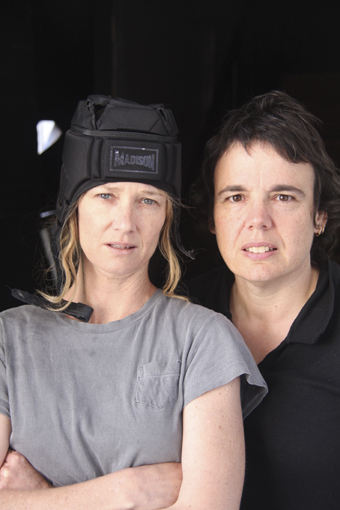
Peta Brady, Wilhelmina Stracke, Strands
photo Guido Stracke
Peta Brady, Wilhelmina Stracke, Strands
Peta Brady’s Strands presents a different conundrum. The story traces somewhat familiar ground—two sisters negotiate their relationship after the death of their mother, upon whom one sister was emotionally and physically dependent. Their respective futures must be determined—one’s supposed freedom will mean the other is placed in a care facility, but the relinquishing of responsibility may itself be a kind of psychic imprisonment eternally re-enacted by the daughter unable to resolve her estrangement from her parents.
It’s a two-hander featuring a character with an intellectual disability. Given the abundance of outstanding actors with perceived disabilities in Australia today, is it problematic to cast an abled actor in the role and risk denying employment to someone whose opportunities on the stage are already unfairly limited? I think so, with qualifications. Brady is clearly sensitive to the tricky territory she navigates here, and there is never a sense of privilege co-opting the marginalised for the sake of drama. This is no Forrest Gump or Rain Man. More importantly, disability isn’t merely gestured to here; whatever the reality behind the production, its fictional world produces sincere insights into the complexities of living with a disability, while working this into a narrative that is never itself defined by that disability. It’s not patronising, and the excellence of the production itself goes some way to alleviating concern. But, for me, it’s not an entirely comfortable work.
ilbijerri theatre, coranderrk
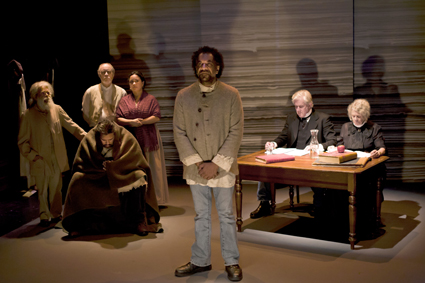
Coranderrk: We Will Show the Country, Ilbijerri Theatre Company
photo Steven Rhall
Coranderrk: We Will Show the Country, Ilbijerri Theatre Company
Ilbijerri Theatre’s Coranderrk: We Will Show the Country tackles a debt of yet another kind—that of the contemporary theatre maker to real figures whose names are inscribed on the historical ledger. The solution seems an austere one: the text of the play is entirely sourced from the minutes of a court case in the 1880s, which might sound tiresome but in fact proves an elegant and engaging strategy. As popular culture so often reminds us, a pared-back version of a legal case follows a classic narrative structure, at first introducing characters and a central problem, moving through arguments and counter-arguments, introducing new twists and complications and eventually reaching a conclusion of some sort.
Coranderrk’s story centres on the 19th century Aboriginal reserve of the same name, at which displaced peoples from all over the country were welcomed and which had established itself as a self-supporting community with the help of a white preacher, John Green. Local authorities sought to gain control of the reserve for their own purposes, however; Coranderrk’s inhabitants eventually took the case to parliament and an official inquiry commenced.
While the script carefully follows the historical record, the production itself ingeniously builds upon its verbatim style. The performances shift between strictly realist and a more heightened style, and the lighting design often switches register into a dreamlike, meditative state. The ultimate effect is far from polemic, but provides an intriguing window on a past we share but from which we are also estranged.
taxi
Patricia Cornelius’ Taxi, directed by Susie Dee, offers an angle on the tiny tales which occur all around us but into which we’re rarely given an intimate view. Its audience of three is positioned in the back seat of a cab, which then travels across various suburbs picking up and delivering a broad array of characters. From the moment the first passenger hails the car, the world outside transforms such that any random passerby may potentially become the focus of the next segment of story, and for this reason each person on the street suddenly becomes a locus of narrative possibility.
Each passenger offers a riveting glimpse into the unsettling reality taxi drivers face daily— from a jovial bloke who does a runner to the silent Vietnamese woman carrying the empty baby blanket to the partygoer too drunk to get out of the car, the driver’s role is at once counsellor, guardian, police officer, confessor, servant and potential threat. While there are official rules in place to handle these scenarios, the lived reality proves far more complicated.
It was wonderful fortune to realise that one of my fellow audience members was a cab driver himself, and when the piece was finished and we were deposited back at our initial launching point, I asked him for his own thoughts on the experience. He was quick to note where our driver had broken protocol, explaining which story moments could never have occurred in actuality, but these criticisms were delivered with great professional pride. They didn’t detract from the work at all, but allowed him to assume an authority rarely permitted during his own working day. In the end, he said, the show was a creative response to his lived reality and, beaming, it was clear how much he appreciated the chance to see that reality from a comfortable back seat perspective.
MKA Theatre, The Economist, writer Tobias Manderson-Galvin, director Van Badham, performers Marcus Mckenzie, Zoey Dawson, James Deeth, Conor Gallacher, Sarah Walker, Peter Paltos, designer David Samuel, sound design Nick McCorriston, lighting Julia Knibbs; MKA Pop-Up Theatre, Nov 29-Dec 16; Strands, writer Peta Brady, director Sue Jone, performers Wilhelmina Stracke, Peta Brady, designer Belinda Wiltshire, La Mama Theatre, Dec 1-18; Ilbijerri Theatre Company, Coranderrk: We Will Show the Country, written and adapted by Andrea James, Giordano Nanni, director Isaac Drandic, performers Syd Brisbane, Jack Charles, Jim Daly, Peter Finlay, Greg Fryer, Liz Jones, Tom Long, Melodie Reynolds, Glenn Shea, La Mama at the Courthouse. Nov 16–27; D & Associates/Big West Festival, Taxi, writer Patricia Cornelius, director Susie Dee, performers Rodney Afif, Angus Cerini, Ananth Gopal, HaiHa Le, Amanda Ma, Nicci Wilks and special guests, visual media Tamsin Sharp, composer Ian Moorhead, Bluestone Performance Hub, Footscray, Melbourne, Nov 16 – 26, 2011
RealTime issue #107 Feb-March 2012 pg. 34-35
© John Bailey; for permission to reproduce apply to realtime@realtimearts.net
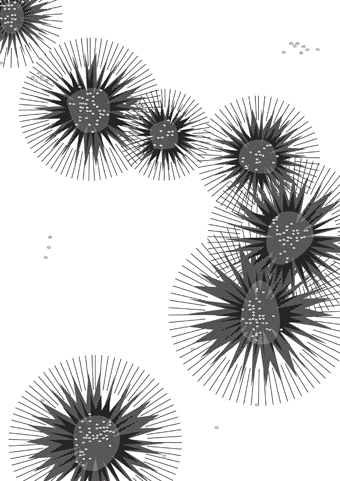
Benjamin Foster, Postulating the Accumulation of Meaning Through the Constantly Becoming Constellation of Signs (detail), 2011
ALL WRITING BEGINS SOMEWHERE. ONCE UPON A TIME. LET US GO THEN YOU AND I. LET ME TELL YOU A STORY. THE STORY I WANT TO TELL HERE, WHICH IS A STORY ABOUT WRITING TODAY, BEGINS WITH A QUALIFICATION. IN THE AGE OF PHYSICAL PRESENCE IT USED TO GO SOMETHING LIKE THIS: “BEFORE I START I HAVE TO DECLARE A CONFLICT OF INTEREST.” AS AN INVITED PANELLIST TO THE CTRL-Z SYMPOSIUM I AM FACED WITH AN OLD SCHOOL NECESSITY OF HAVING TO FESS UP THAT I WAS A PART OF THE EVENT I AM WRITING ABOUT AS A REVIEWER/COMMENTATOR (I MUST DECLARE MY SPEAKING POSITION IN 80S ARGOT).
Nothing controversial there. However in the age of that increasingly anachronistic chimera ‘new media,’ I must foreground my ‘embedded-ness.’ The Gulf Wars weren’t the first military conflicts to physically place journalists on the ground amongst the combat, however they did give the lexicon of media theory a new label for journos who plied their trade under precarious and unstable conditions of mobility.
How do writers work under these rapidly moving and changing conditions, these vectors of marks? This was the provocation thrown down to participants by symposium convenors Niall Lucy and Robert Briggs from Curtin University’s Centre for Culture & Technology: “In the age of personal computers, mobile phones, Facebook, Twitter, word, Photoshop, SMS, email and e-publishing… who—or what—is a writer?” The identity of the writer and of writing under such proliferating and increasingly atomised channels of distribution was the ostensible theme of Ctrl-Z and it was complemented by a prudently curated selection of artworks, video and ephemera of the scribbler’s craft. Perth-based artist Benjamin Forster’s mixed media installation The Accumulation of Sediment, presented a series of striking monochrome generative images, each unique and eminently collectible. It explores the relations between text and writing, hand drawing and digital imaging and the ways in which they “come to claim,” as Lucy and Briggs note in their catalogue essay, “priority over subjects and objects. Not textual representations of the world, but textual markings as world. Signs as signage—orienting rather than communicating, receding into a background hum rather than interrupting a prior silence.”
Speaking on the theme of moral panics in the media about the impact of new media, Catharine Lumby, via Skype, regrettably fell victim to that curse of all writing, but particularly electronically mediated writing—noise. Despite the good efforts of symposium organisers to resolve the “technical difficulties,” Lumby’s presentation resembled a performance art piece inspired by Francis Bacon and Charles Dodge (Suvendi Perera, Robert Briggs and Tama Leaver fared better by virtue of not being virtual). While this distortion was clearly a technical artefact, an unwanted “ambiviolence” (as Stephen Heath would have it), it was in its own weird way a didactic lesson: while forever letting us down (especially at conferences devoted to new media), new media reveals more about writing than we may think.
Gregory L Ulmer’s pre-recorded Skype talk from Florida was much more revealing than Lumby’s tessellated and fragmented live feed that mediated presence, no matter how convincing and live it may seem, is always a delay, an act of writing. Apart from discoursing in his charismatic way about the changing paradigms of literacy and electracy (of which his asynchronous video presence was a cipher), Ulmer demonstrated with panache that when it comes to eating a sandwich as a punch-line, nobody does it better.
The new “affordances” of media streams such as Twitter, Digg, Facebook and blogs, which make Duchampian writers of us all, were not simply accepted as utopian givens on the day, but subjected to lively critique by panellists and Symposium attendees alike. Indeed Mark Amerika’s numerous invocations to Marcel Duchamp’s famous 1957 lecture “The Creative Act” gestured to the often forgotten relations between an artist, an artist’s work and the spectator. As a “mediumistic being”, the artist is largely defined as such by the spectator, not out of any intrinsic qualities of artist-ness (to dramatise the point Amerika performed a remix of Duchamp’s text from his hybrid remixthebook project, which seemed a fitting talisman for the relational, socially-networked encounters with writers and writing, artists and art that were up for grabs on the day, see page 22). But when the spark of being a writer fades, when the work of writing in any and in-between all media is confused with the instant cred of #I’m being a writer today (You and 1 million other people like this!), such media merely carry the inconsequential weight of pixels, letters, marks on a white field. This is why Amerika’s passionate advocacy of exploring the capacity of evolving publishing platforms for the age of electracy (of which his Alt-X Press initiative in 1993 is but one), was a timely reminder that this work continues apace. Everyone may not be a writer, but may become one.
A final word on incarceration, death and ghosts. The venue for Ctrl-Z is reputedly the most haunted building in the Southern Hemisphere. I’m told by my hosts that wherever Pentonville-style panoptical prisons were built in the colonies the asylums soon followed. No doubt something to do with the pervasiveness of the gaze, this unforeseen consequence of Jeremy Bentham’s mediated and pervasive form of discipline unwittingly anticipated various histories that would emerge in the 19th century that equated the origins of media with the spectral. Amid the talk among delegates of apparitions, literate or otherwise, said to trouble the halls of the Fremantle Arts Centre, something of this mordant theme did in fact travel West that weekend. Or perhaps it was already there. Media theorist Friedrich Kittler died in Berlin the previous month. His purported last words, “Alle apparate auschalten,” (All Instruments off!) gesture to the indelible, taken for granted dependence of the psyche on technology in the age of the post-human that he explored in his writings.
When the passion for inventing new modes of writing and the means of distributing it wanes, it will indeed be time to switch off all apparatuses.
Ctrl-Z is conceived as an ongoing series of symposia to be held in Australia and overseas. Its proceedings, along with other special issues devoted to new media philosophy, will be published in the Ctrl-Z Journal.
Ctrl-Z Symposium, Writing in the Age of New Media, presented by the Centre for Culture & Technology, Curtin University & Fremantle Arts Centre, Nov 19, 2011
RealTime issue #107 Feb-March 2012 pg. 25
© Darren Tofts; for permission to reproduce apply to realtime@realtimearts.net
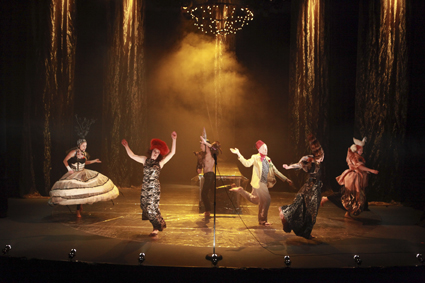
Cordelia, Little Dove Theatre
photo Col Bennets
Cordelia, Little Dove Theatre
SHAKESPEARE’S KING LEAR IS A PLAY ABOUT BEGETTING. LEAR AND HIS WIFE BEGET THREE DAUGHTERS; HIS PREFERENTIAL TREATMENT OF THEM BEGETS JEALOUSY AND DECEIT AND DISTORTS ALL THE FAMILY’S RELATIONSHIPS. THE PLAY’S OPENING SCENE, WHERE THE AGING LEAR DEMANDS TESTAMENTS OF LOYALTY AND DIVIDES HIS LANDS ACCORDINGLY, IS DRIVEN BY NARCISSISM AND RIDDEN WITH INJUSTICE.
The young Canberra company Little Dove use this scenario as the starting point for their explorations into family and ‘love,’ working backwards from it in a series of scenes exploring the clan’s history and rivalries. The King of France introduces the play with a sense of aloof whimsy, asserting that he fell for the youngest daughter, Cordelia, for her laugh and her ability to resist conforming with her father’s court. It is a confused role for the narrator/scene setter: asserting his own character (which is a secondary one, at best), inadequately contextualising Shakespeare’s play for those who don’t know it, and trying to set the scene for what follows.
A series of scenes unfold, tracing Cordelia’s violent birth (which killed her mother) through to sibling jealousies and the girls’ play-acting of their relationships to the truculent father. There are several serious disjunctions between text and scene-making, between an idea and its illustration or fulfilment on stage. These are elements working at odds. The performance lifts when middle sister Regan (Peta Ward), atop the regal dining table, play-acts her father, demanding his daughter’s love.
The success of this scene is in part attributable to Ward’s fine skills as an actor: her gradation of emotion and vocal quality, her subtle understanding of drives, objectives and subtexts are excellent. As a piece of direction and design, too, the scene works: this tripod of daughters with their conflicting emotions threatens to balance or unbalance the whole family structure.
Mostly, however, a burning fury takes each scene by the throat, strangling most emotions that are not rage. The characters appear as locked into their patterns as they are locked into certain repetitive, jabbing dance moves (which I take it are meant to show the conformity of the court but which dull when so prolonged).
That said, the penultimate scene, where performers relentlessly jump on the spot, is strong because something has to break—their breath, their bodies, their collective conscience. But the dramaturgy is weak. The final scene, potentially the greatest, instead reveals the inherent coldness of the production overall.
The scene is an ironic inversion of the source. In King Lear, the old king staggers from backstage, carrying the dead weight of his daughter’s body. He recognises her death as the direct result of his greed and power-mongering. His grief and guilt are deeply felt, hot-blooded. In Little Dove’s production, we see Cordelia carry the body of her mother from back to front stage. But this Mother is hard to care about: throughout, she has been a remote figure, detachedly (or drunkenly?) watching scenes unfold, stumbling in high-heels, concerned with the raunchiness of her voice but consistently ignoring her children. So the high point is the low point: who is this woman (and energy) here eulogised?
This production remains a play about pain and hatred, about palace “dance parties” (and perhaps conformist dance moves) that sublimate tragedies and tensions, but is not about ‘love’—as the director insists—or the vulnerabilities and wounds against love which lead to violence and violation.
Undoubtedly there are some strong elements at play. There is the mellifluous work of the Imp or Fool (Davie), who unfolds, appears and disappears like the smoke of someone’s conscience. The sound design by Kimmo Vennonen is eerily provocative. There is tremendous force and potential in the costume and set design by Imogen Keen, which I sense are both underutilised. But Field (Goneril) and Rotem (as Cordelia) are, sadly, strong forces directed at relentless pitch, something that diminishes the power of the performances.
Draining the play’s force severely is the structure of the second half. It proceeds through a sequence of popular songs (This Mortal Coil? Split Enz? and others not easy to identify) to which the cast essentially perform karaoke mime. It makes for a long 45 minutes, and, to my mind, it is a very serious issue for half a production to rely on, and presume to build its own emotional power out of works by uncited artists.
Critical reviews of Little Dove’s previous, outdoor performance piece, Six Women Standing In Front Of A White Wall (see RT Studio), noted its clarity of ideas and inter-relationships. Cordelia warrants similar breath and thoughtfulness to harness its forces.
Little Dove Theatre, Cordelia—tell me how you love me, director Chenoeh Miller, performers Rowan Davie, Erica Field, Hadley, Noa Rotem, Peta Ward, Janine Watson, design Imogen Keen, lighting Hartley TA Kemp, choreographer Cristina de Mello, poetry Jenny Morris, sound Kimmo Vennonen, producer Dave Sleswick/Motherboard Productions; Street Theatre, Canberra, Nov 3-5, 2011
RealTime issue #107 Feb-March 2012 pg. 37
© Zsuzsanna Soboslay; for permission to reproduce apply to realtime@realtimearts.net
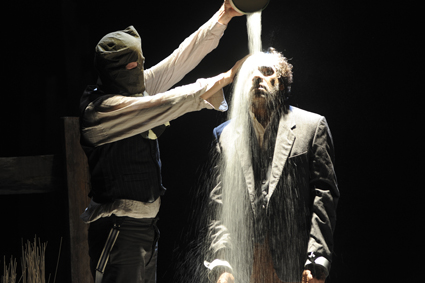
Sam Routledge, LeRoy Parsons, Posts in the Paddock
photo Heidrun Löhr
Sam Routledge, LeRoy Parsons, Posts in the Paddock
THE NOW NOTORIOUS HISTORY OF ABORIGINAL ‘BUSHRANGER’ JIMMY GOVERNOR FIRST ENTERED POPULAR IMAGINATION WITH THOMAS KENEALLY’S 1972 NOVEL THE CHANT OF JIMMIE BLACKSMITH, WHICH FORMED THE BASIS OF FRED SCHEPISI’S 1978 FILM OF THE SAME NAME.
In the novel, Governor the character narrates his world of dismal dispossession in a literary move that Keneally admits he wouldn’t repeat today: what perspective could a white writer possibly bring to the histories of brutality lived by one Aboriginal man, and sedimented in a near century of half-spoken myths, amnesias, wounds and falsifications laid down by colonial Australia? Whose eyes or voice might be able to speak to this history with the mindfulness that it demands?
My Darling Patricia’s depiction of this same history in Posts in the Paddock does not try to speak on behalf of anyone, excepting perhaps the untouchable nature of time itself. Posts in the Paddock brings theatre to a history that was lived and then lived-as-silence, and in doing so, brings audience bodies into breathing, sensate contact with its remains. These remains are both literal and figural as we learn, through its restrained curation of textual, visual and sonic remnants—many of which trace from testimony, object, archive or material site—that both Clare Britton (as Ethel, Jimmy’s wife) and LeRoy Parsons (as Jimmy) are direct descendants of the families whose fates were so forcefully interpolated on one day in 1900, when Governor murdered a pregnant mother and her son in a fit of rage.
Britton, co-director of My Darling Patricia, is an O’Brien, and writes in her essay accompanying the work that the murder of Elizabeth and James O’Brien at the hands of Governor has produced “a generation of Australians who were too close to the shame, the guilt and the sadness of this story.” Britton’s uncle explains that the land called Poggy on which the murders occurred has been held by generations of their family since 1889. It is now witness, as Britton explains, to “all that remains…the vertical hardwood posts of the hut, standing in the paddock like ghosts.” This land and its imagined ghosts form the basis of a work that holds a history in its starkly brutal images, in its idiomatic register and in the quiet intimacy of a shared landscape and loss that connects bloodlines, genealogies, and now audiences.
Posts in the Paddock begins as an installation. What first appear as charred tree stumps stand waiting in a pile of rubbery ash. They are the leftovers of a time brought into the present with a choir of voices that chitter-chatter and interrupt. Words are indeterminate, histories intersect and are lost. We tread carefully looking at others who are listening. Our ears and bodies are being trained, however “synthetic” this stage imprint of a real landscape may seem. Then we are out, cool in the concrete foyer, sitting in the pause between this and the next beginning.
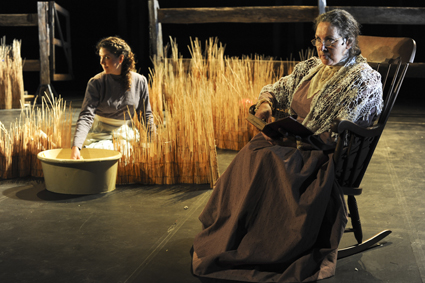
Aunty Rhonda Dixon Grovenor, Posts in the Paddock,
photo Heidrun Löhr
Aunty Rhonda Dixon Grovenor, Posts in the Paddock,
Next we are seated looking down into the landscape we have just inhabited. Those stumps—once close, now distant—have been brought into focus by the unsuspecting connect between our bodily tactility and theirs. They are the aftermath, the scene of the crime, the wood that has stood while all else has fallen away. We watch a history unfold. Jimmy is there, installing a fence, flirting with Ethel. They rarely speak, but actions are followed. These are illustrative but also cutting: Jimmy chained to the fence, Ethel reprimanding—teasing with a bowl of food that looks like it’s for the pig trough. A dingo puppet appears (Sam Routledge as puppeteer), and in a contest with a lawnmower, the dog is ominously hanged.
These small scenarios are built to form a kind of dumbshow prologue that ends in painful climax. Jimmy and Ethel love each other and “just want to be together all the time.” Aunty Rhonda Dixon Grovenor strums their happiness with a rendition of Hank Williams’ “Hey Good Looking, What You Got Cooking?” on a ukelele. The pair marry and have a child, but looming shadows soon empty the space of warmth as Ethel desperately kneads rounds of dough. A pastoral woman strums the Christian child’s prayer “Jesus Loves the Little Children” with zealous irony. Their world becomes impossible as landowners cut them dry: “You black rubbish, you oughta be shot for marrying a white woman.” Ethel screams with anguish, “You can’t eat the air, he better come home with something.” Reeds glow, plates are smashed against police shields and balloons stretch to popping. An electric guitar wails, underscoring the parochial, the colonial and the murderous.
These early images fold out from one another, as if to infuse history with myth, fact with imagination. Their textual and visual dramaturgy interlaces nursery rhymes, letters and diaries, prayers, puppetry and animation. The Poggy posts transform into fence posts and finally glowing embers against a backdrop of what feel like 3D projections on the scrim, making Governor’s world ominously cavernous and inescapable. Throughout there is a piercing sense of disquiet broken only by momentary relief, in a slapstick ‘loony tunes’ type chase sequence, for instance. Jimmy’s inevitable execution is theatrically envisaged in the form of a drum of sugar that is poured over his head, an image reminiscent of the mournful ecstasy one might find in a Bill Viola work; his features become tremulous, almost transluscent. We see Ethel watching his ghost walk away.
The second half of Posts in the Paddock includes Britton and Parsons recounting the research and development phases of the work. The personal here is important, as much for what it factually narrates as for how it positions the makers in relation to the history in which they imagine themselves. Author Chris Healy writes that the “intercultural space of Aboriginality” in Australia is “constituted by strange and transient patterns of remembering and forgetting” (Forgetting Aborigines, UNSW Press, 2008). In this respect, something of the past remains in Britton and Parsons, whose very bodies charge an uncanny sense of repetition and return as they work to acknowledge both the tracks of remembering and forgetting that circulate this history. This is rare theatre: part remembrance, part conjecture, part mourning, part apology and part reckoning.
Performance Space: My Darling Patricia in Association with Moogahlin Performing Arts, Posts in the Paddock, artists and participants Bryony Anderson, Katie Beckett, Jenn Blake, Michelle Blakeney, Clare Britton, Nadeena Dixon, Aunty Rhonda Dixon Grovenor, Bridget Dolan, Phil Downing, Fiona Foley, Marley Grovenor, Sam James, Declan Kelly, Halcyon Macleod, Kirk Page, LeRoy Parsons, Sam Routledge, Chris Ryan, Lily Shearer, Jade Sims, Chris Twyman, Performance Space, Carriageworks, Nov 9-19, 2011
RealTime issue #107 Feb-March 2012 pg. 38
© Bryoni Trezise; for permission to reproduce apply to realtime@realtimearts.net
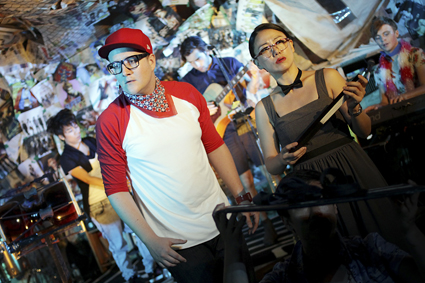
Thom Browning, Lee Chunnam, Underground
photos Fen Lan Chuang
Thom Browning, Lee Chunnam, Underground
UNDERGROUND IS A PRODUCTION WHICH INEVITABLY OVERWHELMS ITS AUDIENCE. THE FINAL INSTALMENT OF METRO ARTS’ 2011 THE INDEPENDENTS IS IMMERSIVE TO SUCH A DEGREE THAT YOU FIND YOURSELF COMPLETELY FORGETTING ABOUT THE WORLD OUTSIDE THE VENUE. THE BASIC NARRATIVE OF THE PIECE CONCERNS THE FANTASTICAL AND HEARTBREAKING LIFE STORY OF HOYOUNG, PROPRIETOR OF SEOUL’S SHAMBOLIC UNDERGROUND BAR, AS TOLD BY THE VARIOUS STAFF AND PERFORMERS OF HIS ESTABLISHMENT.
The audience is invited into the seedy, celebratory Underground Bar. Motherboard Productions have spared no expense in bringing the experience to life. Production designer McK McKeague has transformed the entire Metro Arts’ Basement space into an astonishingly visceral and stunningly detailed approximation of a Korean speakeasy, complete with a fully functioning bar and a colourful array of characters and staff.
Stepping into the venue, you’re immediately flooded with all the apprehension, fear and excitement inherent in being thrust into an alien culture unprepared. This is Underground’s greatest achievement. Director Jeremy Neideck and ensemble afford their audiences an entire world to inhabit and explore over the course of the performance. It’s actually somewhat disappointing that the bar is only a fantasy.
The more overtly theatrical components of the work are less successful. The bar serves merely as a platform for the fairy-tale story of proprietor Hoyoung which, among other things, involves being a princess, losing a friend to a whale and a having a homosexual relationship with a wandering sailor. While the telling of the tale is rife with exceptional moments both poignant and comedic, its overall implementation is quite awkward.
Throughout, the ambition to combine aspects of both eastern and western performance traditions is evident—the nature of the narrative is perhaps the most obvious signifier. Writers Neideck and Nathan Stoneham employ western contemporary performance tropes within a colloquially eastern context—and, despite the undeniable cleverness of such a tactic, it’s here where complications arise.
Too often, elements of the narrative seem to jar against the backdrop of its telling. For example, a key scene involves Hoyoung’s character (performed by Neideck in the guise of bar worker Jules) experiencing the loss of his closest friend, stolen by a whale. Hoyoung’s grief is communicated through a tableau involving a vast cardboard model whale, precise physical performance and a truly gorgeous musical number performed en masse by the bar’s staff members.
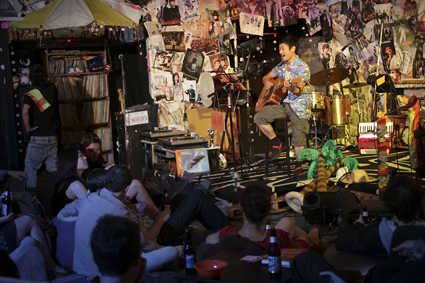
Tak Hoyoung, Underground
photo Fen Lan Chuang
Tak Hoyoung, Underground
Make no mistake; it’s a stunning sequence. It haunts the rest of the production. However, its grandiose, complicated presentation immediately yanks the audience out of that exciting bar in Korea and drops them roughly back in that basement in Brisbane—and there are simply too many such moments for the narrative not to prove frustrating. Though often enjoyable, they just don’t work in the world Neideck and his ensemble have created.
The musical aspects of the production are often the most frustrating in this regard. Hoyoung’s narrative is punctuated by several original song-and-dance numbers of varying sophistication but the majority of them are too polished (in composition and execution) to not seem contrived against their consciously rough-hewn backdrop.
The relationship which develops between Hoyoung’s character and the wandering sailor is another example. While it’s not entirely bereft of pathos, Neideck largely opts to play the courtship for broad comedy. In addition to jarring with the bohemian spirit of the venue in which the production is supposedly being performed, it robs the relationship of the dramatic significance it requires to drive the plot.
There are other issues—Neideck doesn’t fully convince as Jules and the narrative tends towards a patchwork of ideas. However the show’s shortcomings sometimes make a bizarre kind of sense within the world of Underground. Like the gloriously chaotic and immersive design, they suggest the spontaneous and roughshod environment of a Korean speakeasy. It’s ironically only when matters seem a little too sophisticated or over-rehearsed that flaws become truly pronounced.
Nevertheless, such flaws are far from fatal. While marred by imperfections, Underground is at no point an uninteresting theatrical experience. For the most part, it remains remarkable. This is still bold, adventurous, inspirational performance-making. One only hopes that the ensemble will be given an opportunity to unearth the masterpiece so evident just beneath the surface.
Underground, director Jeremy Neideck, designer, assistant director McK McKeague, co-writers Jeremy Neideck, Nathan Stoneham, performers Tak Hoyoung, Park Younghee, Lee Chunnam, Thom Browning, Jeremy Neideck, Nathan Stoneham, Abe Mitchell, lighting Hamish Clift, costumes Noni Harrison, producer Dave Sleswick; The Independents, Metro Arts, Brisbane, Nov 9-26
RealTime issue #107 Feb-March 2012 pg. 39
© Matthew O’Neill; for permission to reproduce apply to realtime@realtimearts.net
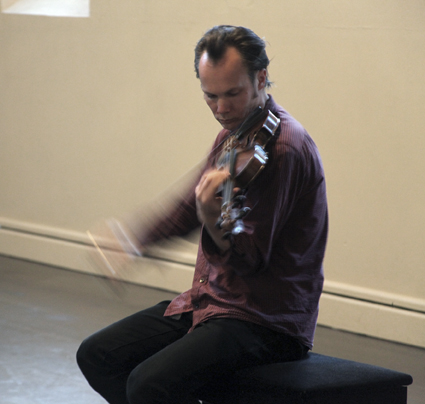
Erkki Veltheim
photo Sabina Masell
Erkki Veltheim
PRESENTED UNDER THE AUSPICES OF THE ASTRA CHAMBER CHOIR, ERKKI VELTHEIM’S SOLO VIOLIN RECITAL CONTINUED ASTRA’S TRADITION OF EXPLORING THE DRAMATURGY OF MUSICAL PERFORMANCE. THE VIOLINIST APPEARED TO DISREGARD THE CONVENTIONS AND RITUALS USUALLY ASSOCIATED WITH CONCERT PERFORMANCE.
This was obvious from the outset when, in a T-shirt, Veltheim entered the 11th Hour Theatre moments before performance time, unpacked his instrument on stage and immediately began to tune. As the audience continued to chatter, Veltheim’s notes evolved into wider intervals, seemingly testing instrument and acoustic. As this process became more elaborate, Veltheim drew attention away from the conversations in the room, which inevitably petered out, to the improvisation that ensued.
Veltheim’s improvising—far from mere noodling—provoked intense interest. It not only allowed a different route into the performance, but one that bypassed arcane rituals of entrance and applause. The improvisation allowed Veltheim to establish a rapport with the audience and to carve out a space that the first piece of the program, Chaconne from Partita in D minor by JS Bach, could inhabit.
In a more typical setting, Bach’s Chaconne would be used as a means for a player and audience to become more attuned to a space and its acoustic. However, here this end had already been achieved. Continuing in the spirit of improvisation, the performance of the Bach conveyed a sense of spontaneity and exploration, executed with extreme finesse.
Chaconne was followed with more improvisations, which developed uniquely and idiosyncratically. Without restraints, moments of intensity and climax could be measured and gradually worked towards with an ever present and intense energy which delivered a succession of musical statements of remarkable strength and clarity.
Veltheim’s improvisational language is very much reflected in the two works on the program by John Rodgers, also a violinist and improviser of immense ability and a former mentor of Veltheim. Solo for Violin and 1/1/94 both demand what seems to be an unprecedented level of virtuosity and were handled in this performance (the premiere of these works by a violinist other than Rodgers) with breathtaking clarity and focus.
The deliberate avoidance of a traditional concert setting put all focus squarely on the performer, without a shred of pretence to hide behind. There was a brutal honesty in the performance presenting the music in its most essential form.
The stark reality of this performance took a more surreal turn when Veltheim was joined by members of the Astra improvising choir, situated behind the audience and around the perimeter of the room. This ensemble of six singers contributed short gestures of guttural sounds and extended vocal techniques. Having spent the first and greater part of the program listening only to the sound of a solo violin, hearing sounds travel from various locations throughout the space had a refreshing effect.
It is hard to think of any musical organisation in Australia presenting work in the way Astra does. Now in their 60th season, there is a characteristic rigour and integrity in every program, managing to integrate new and innovative work with older repertoire, rather than pandering to a particular taste.
Both Solo for Violin and 1/1/94 are on John Rodger’s excellent recording A Rose is a Rose (XLTD-007 CD 2000;
www.xtr.com/catalog/XLTD-007).
Violin Ekki Veltheim, Astra improvising choir, Joan Pollock (artistic coordinator), Louisa Billeter, Laila Engle, Susannah Provan, Katie Richardson and Sarah Whitteron, musical director John McCaughey, 11th Hour Theatre, Melbourne, Nov 6, 2011
RealTime issue #107 Feb-March 2012 pg. 40
© Simon Charles; for permission to reproduce apply to realtime@realtimearts.net
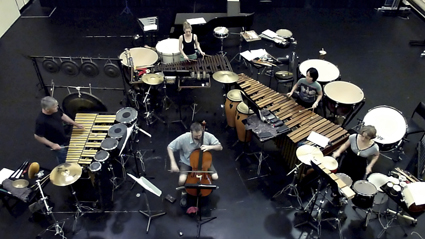
Michael Askill, John Addison, Rebecca Lloyd-Jones, Nozomi Omote, Vanessa Tomlinson
photo Sharka Bosakova
Michael Askill, John Addison, Rebecca Lloyd-Jones, Nozomi Omote, Vanessa Tomlinson
THE TRILLING WIRE. FIRST CONCERT. BRISBANE, EARLY NOVEMBER 2011. ON THE STREETS PEOPLE BUY PUMPKINS, POTATOES—WHATEVER THEY WANT. UPSTAIRS, ABOVE A HARSH AND RUTHLESS RETAIL SECTOR, SOUNDSTREAM COLLECTIVE PLAYS HANNA KULENTY’S CIRCLE SERIES. BIG EMOTION EURO-MINIMALISM FOR SMALL ENSEMBLE.
Gabriella Smart solo on piano with bell-like chords transforming into harmonic clumps bashed hard and fast. The piece builds intensity then…Sudden-Dramatic-Stop…and it all goes relaxed, post-coital, in what turns out to be a structural device common across the whole series.
On to the second number, and again with the flat-out hand-destroying smashes on the piano. But there is also cello, sliding around and about in the way some classical Indian singing glides into the pitch from above and below. The balance between the instruments is great, and stays great across all the performances. Another compositional structure emerges—lines and fragments are repeated then shifted up and down in register, emotional tension mapped into gradual pitch increase and decrease—drama from very simple means. Finishes with solo cello playing small variations on a single figure—lovely and subtle.
(Aside: Smart’s hands take some insane punishment in these pieces, or at least it looks like that to me. There is not a lot of literature on problems resulting from the force pianists hit the keys with; most of the medical literature seems to focus on the standard keyboard being too large for the standard hand, said mismatch giving rise to stats like “91% of piano teachers report playing through pain.” For the aspiring guitarist there are no end of ‘signature’ model guitars based around whichever guitar hero one worships or whichever guitar player has similar hand size or tonal preference. For piano this is not quite so simple; although smaller keyboards have recently become available, the Franz Liszt model for a big guy with big hands dominates the showrooms.)
Like many Australians of my age I lived through the James Galway outbreaks of the 1970s and 80s so I approach Kulenty’s Fifth Circle for solo flute with a certain preparatory body armouring. The flute starts deep, works around the theme, explores timbre without getting into obvious extended technique—subtlety much appreciated. A delay unit clicks in—low volume, not too many repeats, clichés avoided. Again with the straight up rhythm and short chromatic runs bracketed with flourishes. Phrases shifting register as a block, two steps forward, one step back, provide momentum as with the previous works.
The final, Sixth Circle, starts with a sharp, long blast from the trumpet against a piano that is all romantic arpeggios. The two instruments blend seamlessly, the sound richer and fuller than one would think from just two instruments. I get the feeling of The Last Post, but from someone who can only use a single note to articulate an heroic struggle. End of Circle series.
Second Concert. Brisbane, later in November. In the cafes, corporate types desperately look for the cream of society only to discover it is themselves. Meanwhile, in the shabby concrete leftover shopfront bit of the Judith Wright Centre, Early Warning System stand amongst a floor of percussion—vibes, chimes, gongs and their familiars. Huge drums carved from the trunks of a single tree. In this small space I’m thinking, why do I always forget protection for my ears, the left one is down a few dB already? (Ends up of no concern.)
Erik Griswold’s “a leaf falls” for cello and percussion begins the night. Lower casing the title fits nicely with Griswold’s music and public persona (strengths as far as I’m concerned). The cello plays a sad figure against folksy ambient percussion—taps and tinkles, gentle plops of rain on metal, the flap of venetians against an open window frame. Different sections develop—fast and low, bouncy and percussive, call and response, sly and sneaky, classic Griswold off-kilter blues. A fabulous rushing, a wind-like buzz, two snares simultaneously pitched at different tensions. Finish with a reprise of the first section, cello still sad but playing much longer phrases, the accompaniment stronger and more involved.
Michael Askill gives an intro lecture to Free Radicals. We are to hear a piece written for a Graeme Murphy dance work using a 345543 (expand and contract) beat structure. It goes like this: section 1, big log drums and awesomeness; section 2, add wood blocks and little drums and shakers and further awesomeness; repeat for further sections increasing awesomeness for each section. Finishes with an extended foray into hard fast up-tempo woot and groove. Great piece and, as is so often the case, the performers are exceptional. Askill calm and senior, Rebecca Lloyd-Jones precise and classical, Mudford completely different and doing a slow whole of body in-the-rhythm thing. But all of them perfect.
“… and bells remembered” supports John Luther Adams’ rep as a ‘landscape composer.’ Slow chords on metallophones have me uneasy at the start, thinking maybe the acoustics of the room will work against a gentle piece. But the layers of vibes, tubular bells and xylophone build beautifully into a rich harmonic texture that somehow acts as an overlay through which one approaches landscape—that of Alaska where Adams lives, but perhaps also of other spaces that draw the mind out and away from the body.
Finally to Tan Dun’s Snow in June, which disappoints. Nice in parts, but it loses momentum and becomes bitsy and chaotic and overwrought with fairly hackneyed emotion. The whole piece is build-ups, a flourish, then drop-offs one after the other.
Gets a little tedious/predictable/undifferentiated. (Unlike, say, Kulenty’s earlier Circle Series.) But I love the way the performers continually catch each other’s eyes to synchronise their performances.
Once again Clocked Out present an interesting program, superbly performed against Brisbane’s relentless normative push.
The Trilling Wire Series: Soundstream Collective (piano Gabriella Smart, cello John Addison, alto flute Kathleen Gallagher, trumpet Martin Phillipson), Nov 3, 2011; Early Warning System (Michael Askill, Vanessa Tomlinson, Cameron Kennedy, Rebecca Lloyd-Jones, Stephanie Mudford with Nozomi Omote, John Addison), Judith Wright Centre, Nov 23, 2011; presented by Clocked Out & Judith Wright Centre, Brisbane
RealTime issue #107 Feb-March 2012 pg. 42
© Greg Hooper; for permission to reproduce apply to realtime@realtimearts.net
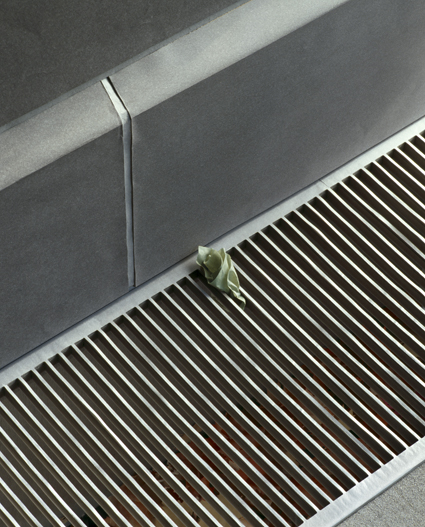
Thomas Demand, Daily #7, 2008
© Thomas Demand, VG Bild-Kunst, Bonn/Viscopy, Sydney, Courtesy Matthew Marks Gallery New York, Esther Schipper, Gallery Berlin and Sprueth Magers Berlin
Thomas Demand, Daily #7, 2008
IN BERLIN IN 2009 I ENCOUNTERED THE WORK OF AN ARTIST NEW TO ME, BERLIN-BASED THOMAS DEMAND. THE WHOLE GROUND FLOOR OF THE NEUE NATIONALGALERIE IN POTSDAMER PLATZ WAS OCCUPIED OR, RATHER, TRANSFORMED BY AN EXHIBITION CURIOUSLY TITLED NATIONALGALERIE.
Hanging against ceiling to floor curtaining chosen by Demand, large, framed artworks were at first glance puzzling. Were they paintings or photographs? Photographs. But of actual objects or meticulously constructed artefacts as small folds and creases slowly registered? Timber and glass cases exhibited open copies of the book that was part of the exhibition, revealing enigmatic texts created by writer Botho Strauss and enhancing the sense of mystery and perceptual misdirection inherent in the exhibition.
Demand’s photographs, often inspired by found images (he keeps an archive of them), reproduce the everyday (houses, garages, bathrooms, kitchen implements, lawns, buildings, a pipe organ even) as life-size sculptures in paper and card, eerily stripped of surplus detail and commercial branding, getting down to some kind of worrying essence. But these images (transmuted from 2D photograph to 3D sculpture and then to photograph again) are not without their connotations. Some, as reviews and essays about the work reveal, are historical evocations with political intent. The image of a wrecked room reproduces the site of the attempted assassination of Adolf Hitler; another recalls the damage wrought in an office by former East Germans attempting to seize their Stasi records. In a 2004 work Demand reproduced the kitchen of the house in which Saddam Hussein had hidden. In 2008 he was commissioned by the New York Times to make a suite of five images of the White House Oval Office.
Humans do not appear in these artworks, but what they make and their effects are strongly felt. In another work (Grotte, 2007), Demand has precisely reproduced nature—an enormous limestone cave using 36 tons of grey cardboard. Demand showed photographs, drawings and plans from the two-year making process but never displayed the finished model which was, as ever with his constructions, destroyed once photographed.
In Sydney, courtesy of the Kaldor Public Art Project, Demand will exhibit The Dailies, a site-specific installation using the accommodation suites that constitute the first floor of the historic Commercial Travellers’ Association in the MLC Building, designed by Harry Seidler, in Martin Place. The public will be able to visit this part of the building for the first time to view Demand’s installation from March 23 to April 22. It will be fascinating to see what Demand makes of this space within an iconic modernist building with its mushroom-like shape. I recently conducted an email interview with the artist.
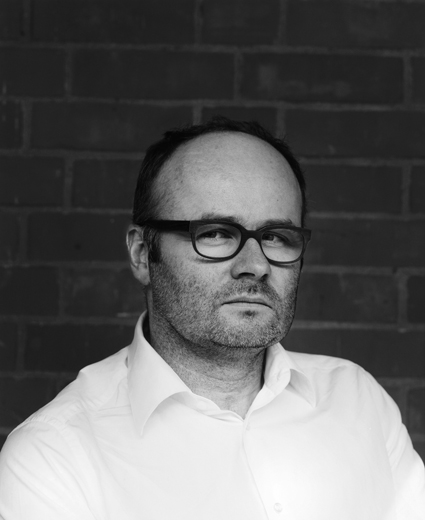
Thomas Demand
photo Albrect Fuchs
Thomas Demand
When I first saw your work it surprised me, like most viewers, serially. First I thought I was seeing large neo-realist paintings suggestive of photography. I then realised I was looking at photographs of actual objects and spaces, but looking again I sensed a certain abstraction—objects and places were shorn of apparently extraneous detail. Then I noticed that the quality of the surfaces suggested card and paper and folding. I knew then I was looking at and relishing a construction. How did you arrive at this approach that plays with audience perception in such an engaging but disturbing way? What drove you to it?
I started doing these small sculptures out of the cheapest and most ephemeral material I could think of: paper, card and plastic foils. I was at the time surrounded by co-students who would do bronze and plastic sculptures, very time consuming, pricey in the making and this didn’t seem right to me as a beginner who had penty of ideas, too little time and being not so concerned about the afterlife of my efforts.
So after being occupied for a couple of years with making those objects and dumping them when I ran out of storage space at the Academy (in Dusseldorf) my professor pointed out that I had no record of what I did, and I did a lot. So I tried to document them, but not surprisingly without any training in photography it was disappointing not to recognise what I liked about the object I made in the first place: its minimal vocabulary, its fragility and timelessness. I knew that was a basic problem, but nevertheless I wanted to solve it. So I was looking for the most common way of displaying an object in daily life and that seemed to be catalogues, or cheapish adverts. Also I wanted geometry in my reproduction which would be less distorting, more how you would draw something. At that point I didn’t have a clue about technical view cameras, tilts and swings or any other fine tricks. So I made two objects, one as an object and one secondary which would compensate for the unwanted effects the photography had on my effort. Both—the catalogue look and the sculpting—were leading away from what someone else would consider a documentation.
Your work traverses and integrates a number of forms: architecture, sculpture, photography, but in the end the photograph appears to take precedence. However, you have described yourself not as a photographer but as a conceptual artist. But what is it about photography that it finally constitutes the artwork? [Not only that but your commitment to certain photographic processes as with dye transfer.]
I think photography is mainly interesting as a great commonplace. It’s in fact a global agreement how to recognise the world in a representation. Everyone knows how it works, how the apparati produce an image and thus it’s a pretty important part of our experience and understanding what’s around us. So in that way it doesn’t matter if it’s dye transfer, polaroid or digital. More importantly though, with the social aspects of the internet coming into more importance, we also learned to ask ourselves who is sending us the image, who is the author, and we do that to a much greater extent than say 10 years ago (all this is pretty new anyway, only in late 1995 the net was capable of sending images, we tend to forget what a major development that was—just 16 years ago). So for an artist, this is an important field for studies, like the world outside was for the Romantic landscape painters of the 18th century or the city was for expressionism. And to come back to your question: only at US-immigration and in interviews I have to define whether I am a photographer or not. I consider myself an artist.
I gather that once you’ve photographed your sculptural creations you destroy them. It’s a potent gesture (storage issues aside). Why destroy such painstaking work, which I assume you enjoy creating? Is there a particular pleasure in the act of destruction over and above an aesthetic and possibly political motivation?
No, no particular pleasure, but it is a relief to have an open empty space, it’s more inspiring than having a cluttered, stuffed studio with lots of unresolved leftovers—at least for me.
Your motivation in Nationalgalerie appears to be at times political, if not literally, although, unlike me, a German viewer would doubtless recognise the significance of certain images more often. What is it that triggers your desire to create a particular image? Is there a variety of impulses?
I guess many, but frankly if I would know what makes a good image, I would probably stop looking for them. It’s sometimes themes, conceptual questions I chew on for years or I simply recognise something I wanted to do since long ago in an image which I would have never dreamt of.
You build three-dimensional models of things you have seen, including events recorded in photographs. Why life-size? I read somewhere that you said you hate building maquettes, that you don’t have the patience, so I was interested to see that for Nottingham Contemporary this year you’ve photographed 12 architectural models of buildings by the great Los Angeles architect John Lautner. What was the appeal?
It’s a study project and I didn’t build the models, so my hate for the diminished scale is still intact. They are still paper, still models, I still photograph them, but in this case they aren’t mine. Also, it enabled me to ponder elements I haven’t employed in my previous work, such as decay, writing, damage and materiality. But they are leaning towards abstract painting much more than they celebrate John Lautner. You wouldn’t be able to recognize one single building from the images.
After wandering about Nationalgalerie for more than an hour I became increasingly alert to the staging of the exhibition, that the way the photographs were hung against curtains (in a wall-less gallery space), the maze-like effect of travelling through the show, and the museum-like placement in timber and glass cabinets of the open pages of the catalogue bearing Botho Strauss’ text as they related to a nearby photograph, all had a dramaturgical impact. I was inside an installation. So it’s very interesting that The Dailies, it seems, will be even more palpably an installation, a site-specific one responsive to the Commercial Travellers’ Association in the MLC building in Sydney’s Martin Place. How did this come about?
Like you I was wandering around in Sydney and came by that rather quirky building. I asked myself what’s inside and no one really could tell me, so I smuggled myself in and saw the circular layout, which immediately won me over. The arching is done with nervi [the reinforced concrete designs pioneered by engineer and architect Pier Luigi Nervi who collaborated with Seidler. Eds] and the repetitiveness of the rooms is great for a show like this. So with a few subtle adjustments and the invitation to Mr Begley and Ms Prada to make this more complex than art in a hotel, I do hope it will become a rather special experience.
I read in an interview that you like working alone, however your work is significantly collaborative—whether with Botho Strauss or the architect Caruso St John or the curator of Nationalgalerie, or in The Dailies in Sydney with Miuccia Prada, who will create a scent for the installation, and US writer Louis Begley, who will provide a short story. How do you choose and work with your collaborators?
Just intuition. I looked outside the window and saw a Prada shop, so I thought it would be nice if this hotel, literally kept without changes since 1974, would smell like a Prada shop. And then you take it from there (by the way they don’t have a scent in those shops, as the leather smells so strong it’s not necessary). And Begley, I just knew he was a very, very successful and important lawyer as much as an unforgettable writer, so I thought this place might resonate well with him.
Without wishing to pre-empt the audience experience of The Dailies, what is it that you wish to achieve by engaging with this Australian modernist space?
You tell me. I made the art already.
Kaldor Public Art Projects, Thomas Demand, The Dailies, Commercial Travellers’ Association?MLC Centre, Martin Place, Sydney, March 23- April 22
Special Public Lectures: Sydney – Domain Theatre AGNSW, March 23, 6pm; Melbourne – Clemenger BBDO Auditorium, NGV, March 24, 3pm
RealTime issue #107 Feb-March 2012 pg. 44-45
© Keith Gallasch; for permission to reproduce apply to realtime@realtimearts.net
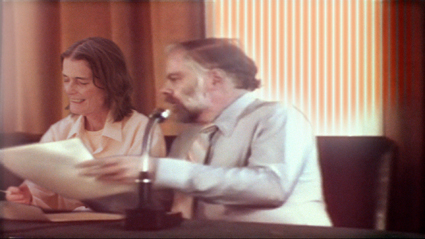
Ms&Mr, Xerox Missive 1977/2011, (video stills), multi-channel video installation
courtesy the artists
Ms&Mr, Xerox Missive 1977/2011, (video stills), multi-channel video installation
“I DID NOT THINK THAT I SHOULD TELL FAT THAT I THOUGHT HIS ENCOUNTER WITH GOD WAS IN FACT AN ENCOUNTER WITH HIMSELF FROM THE FAR FUTURE…FAT HAD REMEMBERED BACK TO THE STARS, AND HAD ENCOUNTERED A BEING READY TO RETURN THE STARS, AND SEVERAL BEINGS ALONG THE WAY, SEVERAL POINTS ALONG THE LINE. ALL OF THEM WERE THE SAME PERSON.”
PHILIP K DICK, VALIS (1981)
Ms&Mr (Stephanie & Richard nova Milne) not only work collaboratively but frequently use their own relationship as their subject matter. While they also create works on paper, their practice has reached wider awareness through their ongoing project Videodromes for the Alone, in which they meld home videos of themselves as children in the late 80s and early 90s with images of their adult selves. This is not merely episodic collage, but rather sees the couple inserted into one another’s lives, inferring that their relationship existed long before they first met. There is a naivety and poetry to these works that appeals to the notion of true love and destiny. Their work also investigates the medium of video itself (Marshall McLuhan’s medium as message) challenging the idea of video as a truthful record of time and further using it as a kind of time-travelling device.
In Xerox Missive 1977/2011, recently exhibited at the Art Gallery of NSW Project Space, Ms&Mr have extended their experiments beyond their own relationship to another that seems particularly appropriate: that of science fiction writer Philip K Dick and his fifth wife Tessa B Dick. Dick, of course, was one of the 20th century’s most prolific science fiction writers, capturing public attention more than others possibly because at some point he came to believe in what he was writing—or rather, he began to write what he was believing.
The moment of significance happened in 1974, shortly after he had married Tessa. A woman appeared at his door to deliver post-operative medication for a dental procedure. A pendant around her neck caught his attention, sending out a “pink beam” and in the stream of visions/hallucinations that followed the encounter (including the revelation of a simultaneous existence in Ancient Rome, and the presence of enlightened three-eyed aliens), Dick realized that he was living in what he described as orthogonal time —that which “strikes all of linear time simultaneously. It strikes the past, the present and future simultaneously.”(SF EYE, #14, Spring 1996)
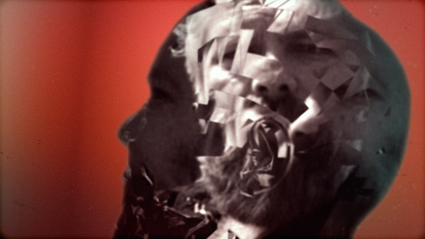
Ms&Mr, Xerox Missive 1977/2011, (video stills), multi-channel video installation
courtesy the artists
Ms&Mr, Xerox Missive 1977/2011, (video stills), multi-channel video installation
For Xerox Missive Ms&Mr have utilised audio and video material from a speech and interview given by Dick in 1977 at a Science Fiction Convention in Metz, France. Via fan sites they also tracked down Tessa (still living in California) who agreed to meet with the artists and, amazingly, be filmed for the project,
On one of the four screens of the installation, we see Tessa as she is now sitting at a desk in front of a microphone, waiting and smoking. Dick arrives and sits beside her and there’s an exchange—their heads turn in slow motion to almost see each other, a hand reaches out to make contact. Dick begins to deliver his speech while Tessa perches on the edge of the table, like a groupie or bodyguard. While these interactions are formal—they are ‘happening’ in the public space of a lecture room—there is an intimacy implied between the figures, a kind of comfort in each other’s presence that is uncanny.
On the opposite screen we see Dick and Tessa in close-up against a plain reddish background, a kind of no-space. Mainly we see the back of Tessa’s head but occasionally her aged hand reassuringly touches her husband on the shoulder. As the sequence progresses his features fragment and distort, breaking into shifting slivers like the facets of a diamond yet contained within the outline of his profile. As his image morphs, receding in and out of recognition, we imagine his presence slipping in and out of consciousness in different dimensions across the timeline.
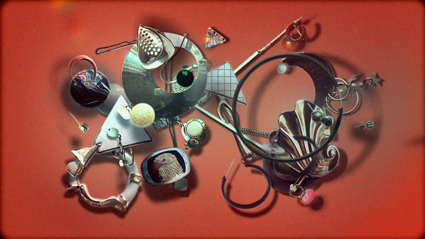
Ms&Mr, Xerox Missive 1977/2011, (video stills), multi-channel video installation
courtesy the artists
Ms&Mr, Xerox Missive 1977/2011, (video stills), multi-channel video installation
On another screen is a collection of jewellery—earrings, brooches and pendants. These items float against the same reddish background, and appear hyper-real, between photograph and illustration. Like the pendant of the strange girl at Dick’s door in 1974, they shimmer, reflecting half-forms and glints of light. On a final screen we see Tessa alone in dappled sunlight against hazy trees, slowly turning, repeating small gestures seen in other sequences. This is the Tessa of the present, alone but still seeking other dimensions.
Accompanying the video are audio snippets of both Dick and Tessa, alternating around the four speakers of the room. Dick talks of the “black haired girl” who often appeared in his novels as a messenger, and how things he wrote actually came to pass, as though he were not inventing but rather remembering a future. Tessa confirms how elements of his writing came true—she was one of these girls. The pronouncements are sparse and slightly muffled, folding into the ominous, rhythmic under-rumble of the soundtrack, but adding just the right amount of context and provocation, particularly for those not well versed in Dickian mythology.
The contemporary footage has been matched to the soft-focus and graininess of the original 1977 video, but there are elements that expose the artifice of composition—a cat’s face smudged, a slightly misaligned gaze—effectively reminding us of the manipulation and time-slippage. The warm tones and haze of the footage, similar to Super-8 flicker and specks, connotes nostalgia and memory so rather than seeming like a meeting of past and present, Tessa and Philip appear caught in a memory that has become, as Tessa says, “unstuck” from the timeline. This visual quality is also evocative of the retro-futurist flavour so strong in many of Philip K Dick’s books, where the future cannot help but be permeated by the era in which it is written: McLuhan’s future seen backwards through a rearview mirror.
In Xerox Missive Ms&Mr have reached a new stage in the development of their oeuvre. As in their earlier work, the strength lies in the interplay of form and content, but in this case the extension beyond themselves as subjects to a couple with well publicised philosophies on the elusiveness of time, creates an even tighter amalgamation. However above and beyond the philosophical explorations, Xerox Missive is powerful because, like the Videodromes series, it tangibly evokes, via technical intervention, a sense of love and lasting connection between the onscreen protagonists. Tessa and Philip K Dick have been separated for over 30 years and exist (arguably) in different dimensions, yet in Xerox Missive their relationship lives on, captured outside of time.
Ms&Mr, Xerox Missive 1977/2011, Project Space, Art Gallery of NSW, Dec 8 – Feb 5; www.artgallery.nsw.gov.au; www.msandmr.net
RealTime issue #107 Feb-March 2012 pg. 46
© Gail Priest; for permission to reproduce apply to realtime@realtimearts.net
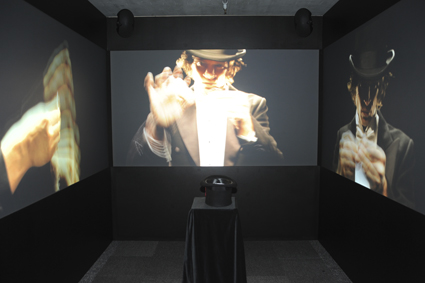
Michele Barker and Anna Munster, HokusPokus (2011), HD multichannel installation
photo courtesy Performance Space
Michele Barker and Anna Munster, HokusPokus (2011), HD multichannel installation
THE MAGIC SHOWS THAT CAPTURED THE IMAGINATION OF GEORGES MÉLIÈS WHEN HE ARRIVED IN ENGLAND IN THE 1880S LATER INSPIRED HIS PIONEERING INVESTIGATIONS INTO THE SLIPPAGES BETWEEN REALITY AND ILLUSION POSSIBLE WITH FILM. OVER A CENTURY LATER, MAGIC IS NOW ATTRACTING INTEREST FROM ANOTHER LEFT FIELD SOURCE: NEUROSCIENTISTS ARE DISCOVERING IN THE WAY MAGIC WORKS A NEW UNDERSTANDING OF HUMAN PERCEPTION WHICH IS OPENING UP A PANDORA’S BOX FOR COGNITIVE SCIENCE.
This collision between the art of deception and the science of perception has also intrigued artists Michele Barker and Anna Munster, who bring this fledgling area of enquiry into the media art realm with HokusPokus. Comprising one half of the visual arts program in Performance Space’s 2011 Exchange season, this collaborative work employed an interactive cinematic magic show to explore the corporeal aspects of seeing. The artists’ playful and experimental journey into neuroscience was paired with a stunning immersive installation in the main space informed by the biological sciences, Peta Clancy and Helen Pynor’s The Body is a Big Place, with sound by Gail Priest, which engaged the organ transplantation process to challenge the disconnect we have with our own bodies and to create greater empathy for this remarkable yet often misunderstood medical procedure.
Installed in the smaller, darkened viewing room at the rear of Bay 19, HokusPokus created a responsive environment that was triggered by a swipe of the hand over an upturned top hat which conjured the appearance of a magician across three screens. A master of illusion and very charming in his dapper black and white tuxedo, the magician launched into a repertoire of visual tricks, deftly manipulating silver thimbles, coins and rings, making balls vanish beneath cups and speedily shuffling and dealing cards. Yet despite his commanding demeanour and gaze, the magician’s control over his act was made unstable by the influence of the viewer on his performance. Having networked the space to make the magician flit between the screens in response to movement, the artists undermined the viewer’s attempts to unravel the secrets of his tricks through distractions and interruptions to their focus.
Sleight-of-hand magic relies upon exploiting a lapse between what the eye sees and the brain’s relative slowness in comprehending, a cognitive glitch. In HokusPokus, Munster and Barker’s three screens were arranged to stimulate the viewer’s peripheral vision, invoking the phenomenon of change blindness. For the artists this phenomenon signals more than simply a novel optical effect. By creatively engaging an aspect of human vision often neglected by new media art, HokusPokus provocatively challenged what Barker has previously identified as the primacy of frontal projection. It also suggests implications for a branch of cognitive science called enactive perception, which understands seeing as a form of sensimotor knowledge gained through the body. However rigorous the conceptual underpinnings though, it was the shadowy sensory realm of the visual trickster that drew me in. A smattering of antiquarian props on screen riffed against the installation’s futurism leaving me feeling curiously outside time while the thrill of having the change blindness eventually ‘wear off’ so that I could spot the fraud shuffles and blank decks resulted in a surprisingly embodied viewing experience.
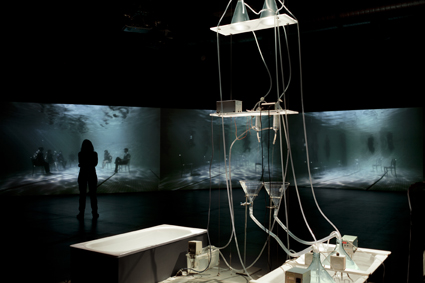
Peta Clancy and Helen Pynor, The Body is a Big Place, (2011), installation view, 5-channel video projection, heart perfusion device
photo courtesy the artists
Peta Clancy and Helen Pynor, The Body is a Big Place, (2011), installation view, 5-channel video projection, heart perfusion device
The Body is a Big Place offered entry into a sensorial landscape of a more submerged variety akin to stepping inside the confines of a swimming pool. A multi-faceted art and science installation comprising six video channels, an undulating aqueous soundscape, a bio-sculptural pulmonary system and two live pig heart perfusion performances, like HokusPokus the work had a long gestation period. When visual artists Pynor and Clancy began discussing a possible collaboration as far back as 2007 “overlapping interests eventually led us to consider organ transplantation as a process in which the ‘personal’ nature of internal organs, and the body as a ‘porous membrane’ are deeply apparent,” the artists explain in an online conversation.
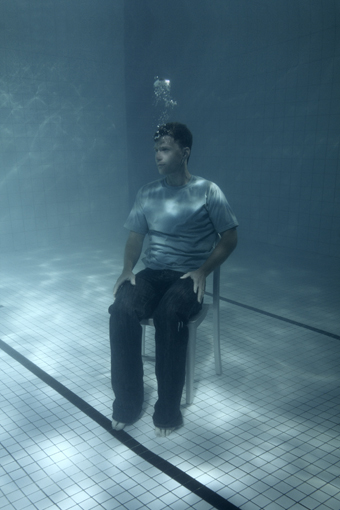
Peta Clancy and Helen Pynor, The Body is a Big Place, (2011), video still
courtesy the artists
Peta Clancy and Helen Pynor, The Body is a Big Place, (2011), video still
The ‘personal’ and the ‘porous’ nature of organ transplantation is explored in the work on two levels. Firstly, through the artists’ engagement with the transplant procedure itself, specifically heart perfusion, where over an extended period of research Pynor and Clancy developed a tender affection and respect for the resilient physiology of the heart, emphasised during the procedure when it beats independently of the body, and sought a way to bring that appreciation into the gallery. After witnessing a Langendorff heart perfusion, the artists thought it might be possible to replicate this technique, a feat that was eventually achieved through the use of fresh pig hearts, sourced as waste product from animals already slaughtered for food in an abattoir south of Sydney.
It was for this live reanimation of the pigs’ hearts in the gallery that the bio-sculptural apparatus was created, although within the context of the installation it exuded its own peculiar aesthetic charm. A gurgling vertical bucket chemistry lab created from plastic tubing and an assortment of funnels and bulbous spherical vessels, clamps, dials and monitors, it was faithful to the body in its warming of the water to body temperature and the scaling of the apparatus to replicate human blood pressure, necessary to successfully reanimate the hearts. On an adjacent wall a video showed a scientist performing the perfusion, the raw muscles of the pig hearts mesmerising in their almost hyperreal pulsing. This juxtaposition with the apparatus, pumping actively but incomplete until the arrival of two suitable organs (wondrously fulfilled during the two perfusion performances), tapped into the anticipation, longing and uncertainty that underwrites the waiting experience of potential recipients.
The second level of engagement flowed from the artists’ interviews and meetings with organ transplant communities. Put in touch with a group of organ recipient swimmers, Clancy and Pynor seized a unique opportunity to film them in a series of loosely choreographed underwater sequences at the Melbourne Baths. Edited and screened across five channels within the gallery, the effect was to create an underwater environment as a metaphor for the interior of the body where Gail Priest’s score of deep and reverberating sounds created an intimate, enveloping atmosphere. As the fully-dressed swimmers plunged vertically into the water, their clothes, pregnant with air, billowed wildly about them. Their bodies appeared amoeba like, expansive and fluid, alluding to the dissolution of boundaries that occurs in an organ transfer. At the bottom of the pool they anchored briefly on silver chairs until the need for air plucked each swimmer back to the surface, evoking relief and a sense of liberation.
In lesser hands, this could easily have become a gory or sensationalist work. But just as HokusPokus achieved a balance between the cerebral and the sensory, Clancy and Pynor’s sophisticated engagement with organ transplantation revealed the maturing of art-science practices, reflecting their conviction that “our interest in heart perfusion has not been to shock or to transgress, but to highlight these astonishing characteristics of life itself.”
Performance Space, Exchange: HokusPokus by Michele Barker and Anna Munster; The Body is a Big Place by Peta Clancy and Helen Pynor, sound Gail Priest; curator Bec Dean, Performance Space, Carriageworks, Sydney Nov 3-26, 2011
RealTime issue #107 Feb-March 2012 pg. 47
© Ella Mudie; for permission to reproduce apply to realtime@realtimearts.net
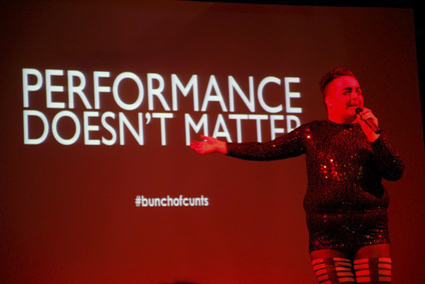
Scottee in Eat Your Heart Out‘s Performance Doesn’t Matter
photo Christa Holka
Scottee in Eat Your Heart Out‘s Performance Doesn’t Matter
TRASHING PERFORMANCE WAS A WEEK LONG PROGRAM OF SEMINARS, PERFORMANCES AND SCREENINGS IN LONDON. IT MARKED THE SECOND YEAR OF PERFORMANCE MATTERS, A THREE-YEAR RESEARCH COLLABORATION BETWEEN ROEHAMPTON UNIVERSITY, GOLDSMITHS UNIVERSITY AND THE LIVE ART DEVELOPMENT AGENCY. THE PROGRAM QUESTIONED STYLES OF THEATRICAL AND SOCIAL PERFORMANCE AND MODES OF ADDRESS. IN THIS REVIEW, WE’VE TRIED TO REFLECT THE DIVERGENT, AND SOMETIMES CONTRADICTORY, STYLES AND ATTITUDES OF TRASHING PERFORMANCE.
performance doesn’t matter
Ladies and Gentlemen, boys and girls, roll up, roll up for the night of your lives! Join us for an extravaganza, join us for a spectacle, join us for a bit of fun. Because “Performance Doesn’t Matter,” or so the organisers of a cabaret night at Toynbee Hall would have you believe. Your sensational host Scottee, dressed in sequins and high heels, will introduce you to “light art”—part live art, part light entertainment— between costume changes and tweets. Make sure you have a drink in your hand, and try to avoid the glare of the makeup lamps at the front of the stage, where tonight’s acts are getting ready.
“Performance Doesn’t Matter” blows a raspberry at establishment figures— universities, festival curators and even you, dear and earnest audience. A troupe of dancing girls (Figs in Wigs) spends more time bowing than dancing, and ends their routine by declaring “Chekhov is not our Dad!” A figure called “Baghdad’s Got Talent” dances, strips and performs magic tricks under a burkha. It’s a double taboo—she questions your attitude to religious veils, while rendering her own performance invisible.
For all its flippancy, don’t forget that “light art” can be political. Nando Messias lip syncs to the sound of a woman describing a homophobic attack. His thin frame bends and twists in perfect time with the unnamed voice, transforming genders, ages and identities and displaying the fragility of the human body under the weight of meanings it has to carry. Later, Johnny Woo performs as man and woman, in his own voice and miming to the voices of others. His mesmerising performance slips between identities like a singer sliding between notes.
This is more than just entertainment—these artists have an air of desperation, as if performing for survival. Performance does matter after all. Well, nobody said anything about being consistent.
spotted!
All the superstars of the Performance Studies academic world, together in one place! All week, they were to be seen hanging out at seminars on subjects like “Emotion and Performance,” “Mainstream and Underground” and “Outsider Actions”—and that was just the daytime program. We spy those young dreamboats Adrian Heathfield and Dominic Johnson smiling at their fans. Golden-voiced crooners Gavin Butt and Tavia Nyong’o on the mike. Even the famously shy Lois Keidan of the Live Art Development Agency took a turn in the spotlight. And what an audience: a sea of tattooed iconoclasts and bespectacled hipsters in which the occasional dorky young writer (like yours truly) felt a little out of place!
this is not a dream
What is this for, this technology that sends images into our dreams? The demand for consumption is pumped around the world by the bloodflow of our culture: the mediated image. But what possibilities might it contain for other purposes? For circulations and counter-
circulations of desire and subversion?
This is the subject of This is Not a Dream, a documentary-in-progress by academic Gavin Butt and curator and critic Ben Walters. It ranges from the early days of video art and public access television, when Glenn O’Brien’s TV Party imagined itself as explicit resistance to the mainstream, to Cole Escola’s queer sketch comedy, whose viral success on YouTube led to a commission from the MTV-owned Logo channel.
Along the way, a more complicated set of interconnections between opposition and seduction is exposed through interviews and selected footage: Nao Bustamante creates a character to guest on The Joan Rivers Show, where she tells middle America she “met a multigendered ambisexual at an aquarium.” Scottee, for whom “YouTube was my university,” appears on X-Factor having a cake fight with Rhianna. Kalup Linzy creates low budget videos in the style of his favourite daytime soaps. Embraced by the artworld as “outsider art,” a final twist leads to a guest role in General Hospital. In one of the episodes, future Hollywood superstar James Franco has the line: “You know the problem with most performance art? It doesn’t go far enough.”
These entanglements take material form in a series of exquisite live interventions by Dickie Beau, moving and lip-syncing with such careful precision that his painted face feels more cinematic than real. Beyond the critique of mediated image as source of alienation, this is a world filled with longing, a world of quivering desires and unreleased energies.
disputed!
US firebrand Lauren Berlant stirred things up when she took the stage. I think you’ve got it wrong, she said to the organisers, it’s not as simple as opposing emotional responses and critical analysis. Most of the time, we don’t even know what we feel! Crisis doesn’t always feel like crisis, she went on. Sometimes it just feels like boredom. Or depression. Or, like, whatever. Incoherence is a symptom of history, says the canny psychotheorist. Your humble writer couldn’t agree more.
the open university
What do you stand for?
Where do you stand?
What do you stand in?
Marcia Farquhar invites you to stand in a skip and listen to other skip dwellers deliver lectures, manifestos and/or their opinions. This is “Open University” and it is, literally, trashing performance.
Do—feel yourself welcomed by Marcia’s friendly chatter.
Do—agree with Dr. Raimi Gbadamosi “in favour of inefficiency.”
Do—nod sagely with Justin Hunt in praise of Courtney Love.
Do—follow Flora Pitrello’s elegant ode to surfaces.
Do—stamp your feet with Kitty Finer against Facebook.
Do—aspire to Ansuman Biswas’s spiritual take on trashing everything.
Do—enjoy the inauspicious surroundings, improved by Marcia’s charisma and her friends.
Do Not—ask if the skip really stands for “trash,” or if it is just a(nother) stage.
Do Not—worry whether the backyard context disrupts the mode of performance, or makes the event more exclusive.
Do Not—ask if the people whose voices get heard are always invited, or if they can ever insert themselves, unanticipated, into the dialogue.
Just as you begin to wonder how “Open” this university is, Marcia will ask the audience to join in and a student called Adam Young will step into the skip. He will tell you about his experience at the Occupy London protest camp, recently set up in central London. He will urge you to visit. Someone will suggest we take the skip along.
fired up!
“Recovery will never come!” exclaimed wiry old-school Italian Marxist Franco “Bifo” Berardi, giving a wake-up call early Saturday morning. We need to re-activate the social body, he declared, his finger pointing insistently in the air. It’s not a movement of the will, but a movement of material bodies. Only then will the next step be possible: dismantling the financial machine. Nice one, Bifo! Bring it on!
FeMUSEum
Tammy Whynot, the feather-boa-wearing femme persona of Lois Weaver, says it’s difficult to share a stage with a drag queen, because of the force of a man’s physical presence. Making her point, Tammy stands in front of the stage at Toynbee Hall, with a tray of homemade cupcakes by her side.
Lois Weaver, Carmelita Tropicana, Amy Lamé and Bird la Bird are here to celebrate women they admire. Carmelita Tropicana references a 17th century nun, a British Bulldog and Marlene Dietrich. Bird la Bird creates a series of vignettes inspired by Angela Carter’s feminist fairytales and the punk singer Polly Styrene. Amy Lamé asks audience members to write the name of their favourite femme on a doily. And Lois/Tammy recounts her own life (and femme-journey) in landmark years—throwing a cupcake into the audience to mark each birthday.
If drag queens usurp the performance of gender, femmes over-perform femininity. They harness a gentler kind of power: doubt. Where does the woman end and the femme begin? What is performance and what is not? And of performance, what is performed for the self and what is performed for the other?
confessed!
It all got a bit emotional when University of California scholar Jennifer Doyle interviewed Adrian Howells, the UK artist best known for his works that produce “accelerated intimacy” (in Doyle’s words). Sprawled on a cosy sofa at the front of the stage, Doyle held nothing back, remembering old lovers and stalkers and her own most embarrassing moments. Meanwhile, Howells talked via Skype from beneath the covers of his own bed, speaking with painful honesty and clarity about the way depression is interwoven within his artistic process. I think we all know how he feels.
this is performance art
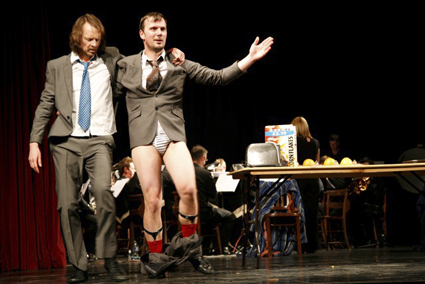
New Art Club in Mel Brimfield’s This Is Performance Art Part Two, Experimental Theatre and Cabaret
photo Christa Holka
New Art Club in Mel Brimfield’s This Is Performance Art Part Two, Experimental Theatre and Cabaret
Culture will eat itself. It’s a fact! So don’t miss out—get in on the feeding frenzy today! Not sure how to do it? Follow these easy lessons from Mel Brimfield:
CUT-AND-PASTE from assorted organising schemes: art history canons, TV best-of shows, tabloid headlines. MIX performance lecture, documentary film and live brass band accompaniment. SPRINKLE with pompous accents, outlandish costumes, parodies of British upper class eccentricity. FOLD NEATLY so that the lines don’t show, and Richard Serra becomes a shirtless beefcake in a welding mask. Joseph Beuys becomes a loveable rabbit-ventriloquist. Rosalind Krauss becomes a celebrity gossip columnist.
Now confidently STUFF the highbrow up its own backside. REPEAT AND RECYCLE until you can’t tell the original from the derivative: Morecambe and Wise as Gilbert and George. Yoko Ono as burlesque sex kitten. Nude tableaux vivant as living sculpture. Action painting as heavy-metal machismo. In a pinch, REGURGITATE your previous work. SERVE with a dash of slapstick juggling and SCATTER with nymph-like dancers.
THIS IS PERFORMANCE ART. This is culture. Just remember: eat it before it eats you.
Trashing Performance 2011: Toynbee Studios, Tate Modern, Bethnal Green Working Men’s Club, Oct 25-23, 2011 www.thisisperformancematters.co.uk/trashing-performance
RealTime issue #107 Feb-March 2012 pg. 16
© Mary Paterson & Theron Schmidt; for permission to reproduce apply to realtime@realtimearts.net
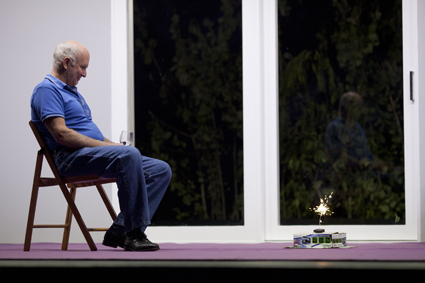
L’effet de Serge, Sydney Festival
photo Jamie Williams
L’effet de Serge, Sydney Festival
Sydney Festival’s L’effet de Serge celebrates the quiet, suburban communality of DIY-at-home Live Art. The idea is catching on. Works in Compass Live Art Festival (Leeds UK) explore exchange as a means of art production and reception. Andy Field, co-director of Edinburgh’s Forest Fringe argues, “Let’s take any economic value out of the work, and understand it on entirely different terms, as a means of social and political shift.” In the Perth International Arts Festival, UK group Subject to Change, invite you to build your own version of Perth. With more luxurious means, US artist Natalie Jeremijenko and chef Mihir Desai feed their audience exotic but sustainable and healthy dishes amidst taxidermied animals in a museum. In Bargain Garden Theatre Kantanka magically recycle anything and everything to create their costumes and the space that houses them. Contributing to the growing art-science field, Peta Clancy and Helen Pynor reanimate pigs’ hearts at Performance Space in an exploration of the ‘porous’ body and organ transplantation. Soon in Sydney, remarkable Berlin artist Thomas Demand (cover image) will convert the Commercial Travellers’ Association hotel rooms in the Harry Seidler designed MLC Building into an installation, with a scent by Miuccia Prada (yes, that Prada) and an accompanying story by US writer Louis Begley. Art is heading in every direction, innovating, hybridising, seeping into the everyday.
RealTime issue #107 Feb-March 2012 pg. 2
© RealTime ; for permission to reproduce apply to realtime@realtimearts.net
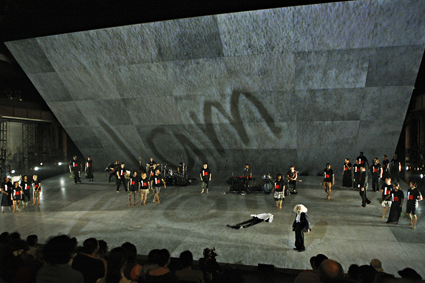
I am Eora
photo Prudence Upton
I am Eora
COMPLEMENTED BY GARY FOLEY’S SOLO PERFORMANCE, FOLEY, AT THE SYDNEY OPERA HOUSE, BLACK CAPITAL, THE CENTREPIECE OF THE 2012 SYDNEY FESTIVAL AT CARRIAGEWORKS, OFFERED AUDIENCES RARE INSIGHTS INTO THE ABORIGINAL HISTORY OF SYDNEY AND OF REDFERN IN PARTICULAR.
My hours at Carriageworks were well spent: there was much learnt and even more that was deeply felt. Elsewhere, Force Majeure’s Never Did Me Any Harm, Rosslyn Oade’s I’m Your Man, Philippe Quesne’s L’Effet de Serge and Rimini Protokoll’s Radio Muezzin were my festival highlights while Chunky Moves’ Assembly, Cheek by Jowl’s ‘Tis Pity She’s a Whore and Belvoir’s Thyestes appealed with their intense theatricality and inventiveness.
i am eora
The engulfing stage design for I am Eora comprises two huge planes that meet deep upstage; one, the floor, tilts down towards the audience, the other rises high to create a deep sky-scape of the same slate-like texture as the floor while both double as a vast screen. It’s like peering into distance without end, but also into memory, legend and history.
A lone man (Matthew Doyle) in ceremonial attire burns eucalyptus leaves on the far side of the stage and exits. Another man (Luke Currie-Richardson), elegant in a suit, appears centre stage, takes his shoes off, stares at us, flexes his feet, removes and neatly lays out his clothes. He is naked save for white body marking. “I am Eora” is written via projection on the sky. The man’s nakedness silently suggests at once comfort with his skin, pride, a challenge even and a return to the past.
A suited Jack Charles berates a crowd of performers from the auditorium: “You can’t live in the past. Time to move on you mob.” “Shut up you old cunt,” one of them yells and Charles is struck down. He recovers, recalling meeting King George III, telling the monarch he needs to give back some of the taken Aboriginal land, that scars don’t heal. Charles is embodying the spirit of Bennelong, whose compromises with white invaders are not always admired. I am Eora then moves on to dramatise the archetypal power of the legendary, not mythical, historical Aboriginal figures Pemulwuy, Barangaroo and Bennelong. Pemuluy, the guerilla warrior, is represented by singer-composers Radical Son and Nooky as a modern rapping hero in not always distinguishable lyrics in a raw opening night sound mix. Pemulwuy was eventually killed by troops: “Boy you gotta hold your own, your daddy ain’t comin’ home.” Tomorrow’s Pemulwuy emerges as a small boy in a Superman outfit while Radical Son’s antecedent—“All the brothers, women, children who died just to be civilised…I don’t ever want to feel like a Bennelong”—is shot by a policeman. It’s clear by now that I Am Eora is neither history lesson nor simple story-telling, far from it. It assumes some knowledge of the historical figures (aided by the printed program) but otherwise leaves the audience to make connections.
Represented by a solo performer (Miranda Tapsell), Barangaroo’s spirit is largely evoked by action around her—the flow of sustaining water projected above (Barangaroo was a fisherwoman), the voice of Mum Shirl, the powerful singing of Wilma Redding (“Don’t close the door on me”), Linda Burney MP repeating her inaugural parliamentary speech and a group of women gesturing chorally and affectingly in support of Barangaroo. When the nurturing, pregnant Barangaroo does speak, her voice rises into a wild, barely intelligible cry from the heart. This constellating approach to evoking Barangaroo works here and there but is sometimes a testing mix of the literal and the very lateral, of the subtle and the overwrought.
Bennelong returns, repeating his opening words of warning, but now despairing of the loss of stories, of place names (“how will people know they are from here?”) and anticipating his death: “I know this is the night I will die…our footsteps will be swept away…all this I have seen,” suggesting that his attempts at reconciliation were driven by the need for cultural preservation. He dies, and in an act of reconciliation internal to Aboriginal society, Radical Son/Pemulwuy takes up Bennelong’s body.
Wesley Enoch and fellow writer Anita Heiss have taken on a huge challenge in eschewing story-telling and focusing instead on the evocation of three key figures in local Indigenous history, using a collage of song, dance and spoken word (at its best in Charles’ Bennelong) supported by a talented live band and the Stiff Gins, and layered with projections (including, for example, names writ large and then erased, as history does). Enoch, as director, is to be congratulated for melding hugely disparate elements. That they didn’t always cohere and that the performers could not always meaningfully fill Stephen Curtis’ impressive stage was perhaps inevitable on a first outing. A tauter version and a clearer delineation of the tension between the three archetypal figures (especially as it relates to the Bennelong heritage) might make for an enduring work which, as it is, delivered a grand, impressionistic celebration and a sense of heritage that most of us know little of, let alone feel part of, but is offered for sharing in I am Eora.
travelling colony
Brook Andrews’ Travelling Colony comprises caravans painted in the artist’s trademark patternings such that they cluster into a single artwork filling the vast Carriageworks foyer. Likewise, as you move from caravan to caravan, relaxing into a chair or on a bed, you gradually accumulate a history of Redfern as told by its inhabitants on video monitors. Some of these people played key roles in the development of Redfern, recalling childhood years, industries that provided work when there was none in the country, the impact of Charles Perkins, the Block as the first Indigenous landholding, the founding of child care, medical and legal services, the profound Black Theatre years, the terrible drug blight and the death of young TJ Hickey. Speakers believe the latter was the trigger for reform: “it pushed us to turn it around.” The pride in Redfern is palpable: “What happened in Redfern benefited the whole country.” It’s seen as the place where leaders learned to lead, where culture has won out over drugs, where young artists learn their craft in a safe place, says rapper Nooky, while an older male, a community bus driver, admires “the young blokes and women comin’ through” and pays tribute to the role women have played in Redfern’s evolution. Travelling Colony is an ingeniously immersive and educative creation from a leading Indigenous artist. See it now.
181 regent st: addressing black theatre
Also fascinating and informative in a more conventional model is the Rhoda Roberts curated exhibition focused on the National Black Theatre in Redfern in the 70s. I can do little justice to its scope but to acknowledge its tribute to the artists well outside the mainstream who provided the impetus for the flowering of black theatre from the 70s to the present. There are video projections of dramas and documentaries, excerpts of staged play readings, photographic portraits of leading figures and images from key productions, reviews, articles and scripts. In the audio recordings from ABC Radio National’s Awaye, it’s sad to hear late playwright Kevin Gilbert speaking of his need to keep writing and painting inside prison and out given “the horrors I saw and still see and will continue after 1988 [the National Bicentennial]” which he attributes to the absence of a truly national spirit. 181 Regent St is an inspiring celebration. I’m hoping a book or DVD will emerge from it.
foley
If not formally part of Black Capital, Foley at the Sydney Opera House segued beautifully with I Am Eora,Travelling Colony and 181 Regent St. Gary Foley’s personal account of his own history is embedded in and integral to the development of black politics in Australia. As a young man, inspired by Charles Perkins, he found his way to Redfern, became part of the black theatre movement and emerged as a leading activist. The show is an informal lecture with Foley the historian guiding us through sometimes unfamiliar events, from the visit of black American boxer Jack Johnson to Australia in the early 20th century, encouraging the strengthening of social and political organisation, through to Foley’s childhood and on to Redfern, the National Black Theatre, Black Power (wickedly funny) and the Aboriginal Tent Embassy which is central to his vision.
Describing himself on stage as “an aboriginal historian in his natural habitat” (the set is built from the cardboard boxes that have held his library and copies of his ASIO files), Foley is consistently and pointedly witty. But always with an edge, sniping at Neville Bonner, Noel Pearson, “1988—the great masturbation of the nation,” and delineating the failure of Labor governments to grasp the need for land rights, not native title. He declares, “The struggle goes on…we changed the world, only trouble is the world changed it back.” If now imbued with wit and wisdom, Foley’s anger is still palpable. The show should travel to a wider audience, and it could make a great film given the ample audio-visual material that Gary Foley and director Rachael Maza put to fine use on stage (Foley drolly indicating that working to cue keeps him on track in a delightfully discursive performance).
never did me any harm
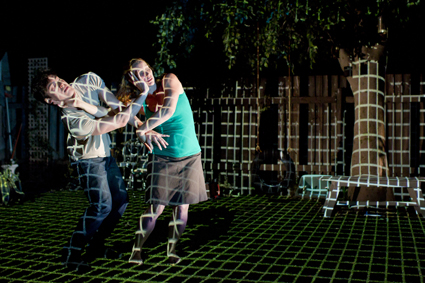
Never Did Me Any Harm, Force Majeure & STC
photo Jamie Williams
Never Did Me Any Harm, Force Majeure & STC
Force Majeure’s Never Did Me Any Harm is an engrossing reverie replete with dream-like discontinuities and the irruption of strange images into an inviting everyday backyard setting. As in much of her work, choreographer Kate Champion draws us into states of being where time is suspended, with either a moment of trauma writ large as in the individual crises of the subjects of Not in a Million Years (2011) or the collective anxiety of the post-crisis Already Elsewhere (2005), or more intimately in the personal reflections on age in The Age I’m In (2008). As with the latter, the recorded utterances of volunteers reflecting on their lives anchors this reverie in everyday reality. This time the subject is parenthood.
Although children have a role in the show—performers transform into amusing or scary children—the work focuses on adult problems and disappointments: a father who manipulates his child’s playfulness to the point of violently shaking her; parents who lose their emotional and physical intimacy; others worn down by the challenge of rearing an autistic child. Suppressed violence is vividly represented by the projection of a pulsing digital grid that envelops the backyard, quaking beneath the performers with a deep sonic rumbling and vibrating their bodies.
I was particularly taken with a scene where Josh Mu as an autistic boy (or as Kate Champion explains in her RealTime online video interview, it could be any child) pushes his comforting mother (Heather Mitchell) down as if to kill her. Doubtless that’s what she might feel about his demands regardless of her love for him. Is this her nightmare? Just as disturbing is the subsequent moment when a home movie image is projected onto the boy’s t-shirt. He takes it off, gently folding it as if to hold on to his past. His shadow, bizarrely white, momentarily parts company from him and has to be retrieved in one of the most memorable images in the show, as if the boy is dancing into a sense of wholeness and independence.
Other scenes are much less mysterious, more literal—a father’s (Vincent Crowley) increasingly loud and bitter speech to the audience about parents who have forgotten their own childhoods, who chauffeur their children in SUVs, who sexualise children, and his concern that no one celebrates having an average child. There’s the scene where projected words like ‘money,’ ‘accessories,’ ‘bored,’ ‘grown-up’ and ‘damage’ magically slide down the tree trunk onto a couple as if to suggest forces at work of which they are unaware. The oscillation between these relatively literal moments and more enigmatic ones provides a strong framework for evoking complex issues and emotions not so easily represented.
Dance doesn’t appear utterly central to Never Did Me Any Harm. There’s Kirsty McCracken’s dancing child and Sarah Jayne Howard’s pregnant mother. But an overarching choreographic sensibility informs the work—it’s evident in the engaging gestural conversation that opens the show, the tussle between father and daughter, the funny family photo scene, the episode where the boy’s shadow peels itself away, and elsewhere. Actors Heather Mitchell, Marta Dusseldorp and Alan Flowers are seamlessly integrated into the movement. The embracing dance in Never Did Me Any Harm is between bodies, voices, images, sound (Max Lyandvert) and design (Geoff Cobham) in a dark if sometimes humorous foray into the private worlds of parenthood.
In my video interview with Kate Champion, made after I’d seen Never Did Me Any Harm, I ask her to respond to some of these observations. Her comments are fascinating.
thyestes
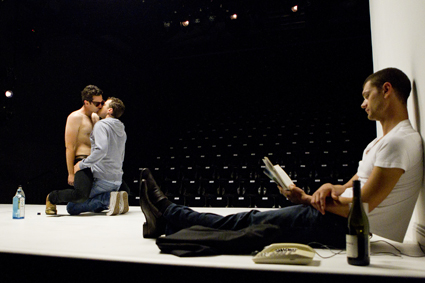
Thyestes
photo Jamie Williams
Thyestes
With its virtuosic theatricality and taut ensemble playing, Thyestes is a bracing contemporary rendering of the Ancient Greek myth of the rivalry between the brothers Atreus (Mark Winter) and Thyestes (Thomas Henning) culminating in a meal in which a vengeful Atreus cooks and serves up his brother’s children to their father. Instead of adapting Seneca’s play, the writers (Winter, Henning, Chris Ryan and director Simon Stone) go at the myth quite laterally, detailing the unfolding story in brief digital readouts between six scenes and then abruptly working back from the twelfth scene to the horrendous, pivotal sacrifice.
The ghastly meal aside, the events in the readout are mostly not portrayed on stage: it’s “the moments between atrocities…play[ed]…in as modern and realistic way as possible” (director’s program note) that provide the work’s focus. The temporal disjunction, on the other hand, is aimed at revealing the causes of the deed and then its consequences (for example, the death of Atreus at the hands of Thyestes’ bastard son) before we witness Thyestes gobbling up his bolognaised children. It’s a strategy that might confuse even an alert and myth-informed audience member, not least because the myth and the contemporary scenes are for the most part at such a great remove from each other. Still the work coheres and is compulsively watchable as the three performers (Ryan playing one male and three female roles) indulge in Tarantino-ish conversations typically imbued with popular culture references, obsessive repetitions, psychotic turns and implicit threats. Or they simply play table tennis (Thyestes and Atreus in exile). Or quietly or overtly torment each other (some nasty business with a strap-on). Raw rock alternates with excerpted classical compositions and Ryan, as Pelopia in an oddly Kosky-an moment, sings Schubert’s “Der Doppelganger” at a grand piano (the characters otherwise show no inclination to high art, quite the opposite).
The ingenious set is a black-framed white box with the audience on either side, looking through. Dark curtains rapidly rise and fall to mark scenes in which, miraculously (behind the aural mask of loud music), surprising new stage arrangements are realised with cinematic verve. Thyestes is like a hyper-archaeological dig: we read beneath the surface of this impressionistic, blokey world, searching below the accretions of contemporary culture and its technologies, from iPod to piano, past Romanticism and the Baroque, to find mere fragments of a mythic world of power hungry, rapacious kings. Now stripped of the mystery of distant time, of any sense of tragedy or even pathos, these men are revealed to be as cruel, manipulative and banal as the powermongers who live amongst us today. Only in the conversation before Thyestes eats his children, where he and Atreus recall their childhood, is there a fleeting sense of brotherhood. But the joy of vengeance outweighs the familial bond. Thyestes is a bold, complex and challenging creation: just what it adds up to is food for further reflection. Mark Winter’s manic but superbly controlled performance as Atreus (who is at the centre of this ‘telling’ of the Thyestes myth) is chilling, Henning is contrastingly cool and Ryan effectively plays the women with a simple directness (the inherent mysogyny of the myth is amplified in this play but, at the same time, it’s perhaps undercut by the casting choice).
radio muezzin
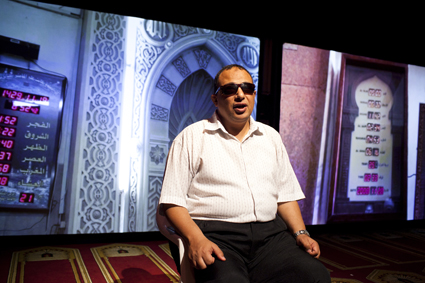
Radio Muezzin
photo Jamie Williams
Radio Muezzin
There’ll be a detailed response to Radio Muezzin in RealTime 108 from Meg Mumford and Ulrike Garde, who have spent time with the producing company Rimini Protokoll (Germany) and they’ll also look ahead to the company’s 100% Melbourne in May this year. As feature-length documentaries play in cinemas and non-fiction moves to the front stands in bookshops everywhere, so has theatre invested increasingly in staged documentaries in a variety of forms with increasing realism—real people, as it were, on stage.
In Radio Muezzin, we meet three muezzins from Cairo who are losing their jobs to a fourth (who has left the show—his words are read to us and we see him on screen, championship weightlifting and winning a Qur’an reading competition in Bangkok) who broadcasts daily prayers to mosques. The three men, one of them blind, one with a damaged leg, another with a day job, speak with humility about their careers, families, status and the Arab Spring (which they welcome) along with revealing incidents from their lives told against a screen the width of the stage. We glimpse their younger selves and the flow of Cairo street life. One muezzin takes two hours to get to his mosque each day, one still works at the holy task of baking, another’s mosque is the size of a tiny room while the broadcasting muezzin has an audience of tens of thousands.
The significance, and challenge, of growing a beard is discussed; ritual ablutions are carefully demonstrated; salary discrepancies (from no pay to a lot) are detailed, and we hear the haunting sung prayers. A set of ceiling fans turn above the carpeted stage to convey, with the projections, just a touch of Cairo. While it’s disappointing that the fourth muezzin doesn’t appear (projected text explains that he was in dispute with the other muezzins in the show) it’s sadly apt that his close-miked, dulcet toned, recorded reading gradually overrides the live voices of his peers at the end of Radio Muezzin. This is affecting theatre, unsophisticated, awkard at times, but it never pushes the muezzin to be anything other than who they are, or as much as they are prepared to reveal. Congratulations to the Goethe-Institut, its partners, and the Sydney Festival for presenting us with this unexpected pleasure—theatre that while un-cathartic is quietly engrossing and culturally disorienting.
anatomy of an afternoon
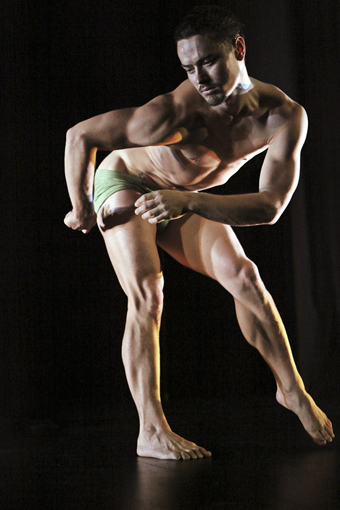
Paul White, Anatomy of an Afternoon
photo Prudence Upton
Paul White, Anatomy of an Afternoon
In Anatomy of an Afternoon, a work inspired by Vaslav Nijinsky’s Afternoon of a Faun (originally set to Debussy’s Prelude to the Afternoon of a Faun), dancer Paul White very slowly emerges from tree-like stillness into a creature, initially appearing to discover balance and shape (peering down at his body to see what it is doing), walking on all fours, tongue protruding, becoming increasingly animal-like and crawling rapidly towards us as the music from the three onstage musicians intermittently hints at Debussy, the fragmented, sensual ebb and flow of their score equally taking its own shape.
Standing again, White is suddenly alert to his feet, as if they’re alien; he staggers, hops and turns; he quite unconsciously discards his clothing; he doesn’t understand how trousers work—thinking they should slide on of their own volition.He reminds me of the protagonist of Werner Herzog’s The Enigma of Kaspar Hauser, a man discovering himself and the world, if not manners—White bares his bottom at us and sniffs his fingers. If Nijinsky’s faun flirted with nymphs and naiads, White engages instead with the audience, peering with curiosity, looking at us upside down between his legs or from an extended miraculously slow-turning headstand, the music now fully-textured in this reverie of self-awareness.
I saw Anatomy of an Afternoon at a disadvantage, from the back of the Opera House’s Playhouse auditorium, deprived of the intimacy the work seemed to warrant and not terribly aware of White’s facial expressiveness mentioned by other audience members. However, White, as ever, moved superbly in a work that perhaps evolved too slowly to be consistently immersive and was curiously lacking a third dimension usually evident in the creations of choreographer (and RealTime correspondent) Martin del Amo. But I’d love to see it again, up close.
i’m your man
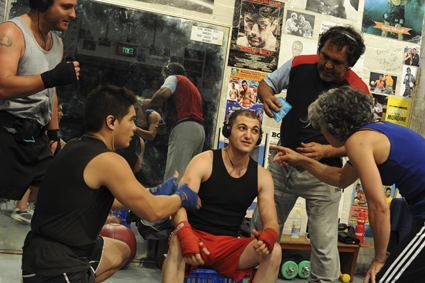
I’m Your Man
photo Heidrun Löhr
I’m Your Man
The first thing that hits you in I’m You’re Man is the smell of linament, the second is the pummelling of punching bags in the small Belvoir Downstairs Theatre converted into a gymnasium walled with posters of famous boxers past and present and inspirational texts: “The more you sweat the less you bleed.” Loosely built around the career of a young boxer, Billy Dibb (Michael Mohammed Ahmad) aspiring to be world champion, I’m Your Man is a weave of verbatim utterances from boxers about their lives channelled through iPods worn by performers who reproduce what they’re hearing, picking up the pauses and hesitations, the changes of tack and rhythm, the colour of accent. The sense of pride and of ambition (whether for fame or a family’s survival) is as palpable as the punching, push-ups, virtuosic skipping and floods of sweat. We learn about being hit (“It’s the thump, not the pain”), wounds (“you could see the cracks open”), decay (“it’s my eyes, it starts from there”), deaths, constraints on sex and alcohol, defeat, nightmares and the big night. Perhaps on his way to the top, Billy fantasises victory, he’s “willing to die” and his support team anxiously spill out conflicting advice and fears. “The time for talking is over!” yells the coach and the waiting crowd roars. And the audience in this tiny gym-theatre roar too, in approval. I’m Your Man’s is pretty relentless but the pressure is eased by some quiet, amusingly lateral dialogues. As for the headphones, so confident and fluent are the performers that you forget the device and marvel at the brute reality endured as a sport.
l’effet de serge
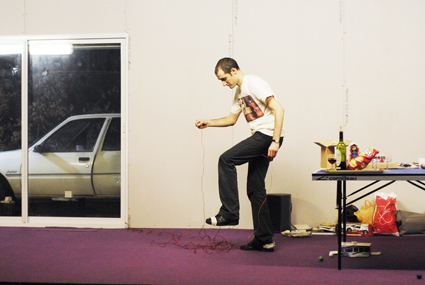
L’effet de Serge
photo Martin Argyroglo Callias Bey
L’effet de Serge
L’effet de Serge (France) was a festival highlight, a quietly immersive, slow burn, idiosyncratic performance about a man who lives on his own and invites friends singly or in pairs to visit for one-off events and occasionally a larger one, bringing all his acquaintances together. Serge’s actions are most easily described as DIY-at-home Live Art. His long workbench is cluttered with a TV (which he watches while silently working) and numerous tools with which he creates his little actions. To the sound of old movie scores, a tall, loose-limbed actor (faintly reminiscent of Jacques Tati) announces that he will play Serge. Couples or individuals arrive at the barely furnished house at various intervals, seen through the glass door on foot or bicycle or in a (real) car, are offered a drink and witness a brief display—sparklers on a motorized toy car to music by Handel, for example. Or Serge in his guests’ car flashing head lights, parkers and interior light to the beat of Wagner’s Ride of the Valkyries. His audience is allowed to finish their drinks and then are ushered out. Socialising is minimal.
Serge plays table tennis, solo. He sets up a more elaborate display (luminescent spectacles, glo-rope, laser effects, music by John Cage) for a young woman (there are the slimmest of hints of a possible relationship shaping up). Then there’s the big night, many guests, a bigger spectacle, much more sociability and played like the real thing, with much of the dialogue aptly just audible and not at all acted in the conventional sense. It’s not surprising to read that Serge clubs have been springing up across Europe. L’effet de Serge is a work of quiet intimacy, eccentricity and everyday performativity emerging side by side with the virtual fantasies of the digital world.
assembly
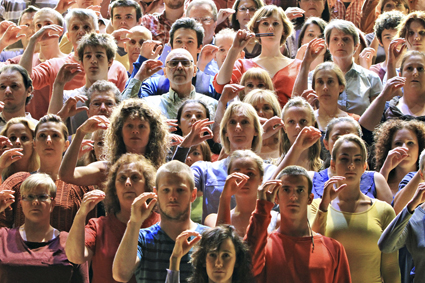
Assembly, Chunky Move
photo Prudence Upton
Assembly, Chunky Move
From the opening, enveloping mass chatter to the sight of waves of choral performers flowing over the top of the steep, wide stairs that fill the stage, to a vocally aggressive stand-off between two sudden, huge factions, Chunky Move’s Assembly conjures nothing less than the experience of watching the human crowd at a distance as just another animal species (a reminder of the imagery that saturates previous works, Glow and Mortal Engine). However, interpolated into these mass movements are carefully orchestrated patternings in smaller groups that suggest cooperation, care and intimacy (as well as occasional threat), while eight dancers, alone or in various permutations, become emblematic of the body’s capacity to interact and communicate with wordless eloquence. The dancers glide, often while extended horizontally, with anti-gravitational ease, up and down steps, or fall from one level to another with occasional alarming thumps. The quite dancerly choreography, brief tableaux that recall religious paintings, the vocal beauty of some of the crowd sounds and music from the late Middle Ages and Renaissance yield a quasi-mystical ambience that elevates life and art to something more than mere being. Gideon Obarzanek makes the most of the design and of his large cast, exploiting all the opportunities they offer him aesthetically while evoking a certain thoughtfulness about the tension between individual and mass, between human and animal evident in images of panicky flocking or lyrical circling, like birds. Given the considerable physical demands The Sydney Philharmonia Choir acquitted itself more than ably (as it did gesturally for Peter Sellars’ staging of Stravinsky’s Oedipus Rex for the 2010 Sydney Festival). Assembly is a grand work which fascinates with its interplay of ideas and images, both visual and aural.
a history of everything
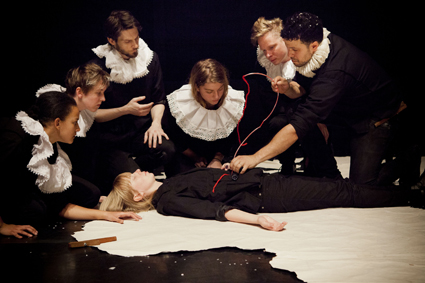
A History of Everything, Sydney Theatre Company and Ontroerend Goed
A History of Everything is a romp backwards through human history to our single cell origins and the Big Bang. It springs from a young woman’s fantasy, delivered at the show’s opening, based on some dodgy science positing that at the point of utter entropy of the universe the flow of time will reverse. The performers unroll a huge map of the Earth across the stage and with a variety of props, including signs for wars and flags to denote nations, reverse time in some detail for recent decades (revealing what one has forgotten) and then in giant steps backwards. Direction and performances are endlessly witty and inventive, drolly noting the delivery of technological developments (revelatory at the time, slight in retrospect), pushing tiny boats backwards over oceans, shifting continents about on their tectonic plates, coolly delineating a hugely shrinking global population. Towards the end the young woman who we met at the beginning can declare that she’s no longer frightened of the universe—there is something oddly comforting about conjuring a compact life of the Earth even if backwards. However, it’s a show built on an exhaustible conceit and, once it arrives at pre-life, becomes calculatedly spectacular if reverentially grim with the Big Bang like an apocalypse in reverse. A History of Everything has nothing of the raw dynamism of Ontroerend Goed’s (Belgium) previous Sydney offering, Once And For All We’re Gonna Tell You Who We Are So Shut Up and Listen. However, all credit to the actors, including members of the STC’s Residents, for their role in collaborating on the creation of a work packed with detail as well as performing it with such vigour and dexterity.
’tis pity she’s a whore
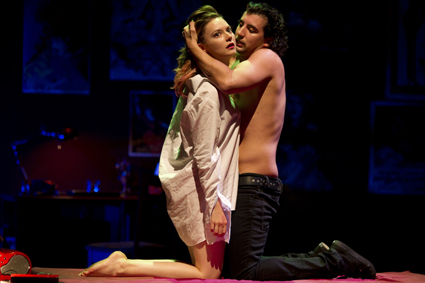
‘Tis a Pity She’s a Whore
photo Jamie Williams
‘Tis a Pity She’s a Whore
Cheek By Jowl’s consistently engaging but not entirely satisfying production of John Ford’s ‘Tis Pity She’s a Whore (1629-1633) is a pruned back version of the original, depriving the play of its comic sub-plot but unleashing the force of the central narrative by providing it uninterrupted continuity. This allows
the jilted Hippolita to take centrestage in a clear trajectory from her expression of emotional pain to her subsequent murderous plotting and eventual death. Thwarted desire is physically manifest in her sadistic treatment of her apparent ally, the Machiavellian Vasques, twisting his nipples and digging a stiletto heel into his hand. Suzanne Burden’s Hippolita is powerfully realised as a strong if misguided woman. She is juxtaposed with Annabella, the play’s adolescent co-protagonist (with her brother-lover Giovanni). Annabella’s dismissal of Soranzo (Hippolita’s ex) is conducted with dignity and wit well beyond the ken of this aristocrat suitor whom, in an act of desperate expediency, she has to marry anyway.
From then on the narrative drive is pretty much in the hands of Vasques until it escapes even his grasp when the obsessed Giovanni stabs Annabella and presents her heart to the courtly gathering. In the meantime Annabella had come to expect nothing less than death at the hands of the cuckolded Soranzo, but never Giovanni. Refusing her brother’s love, her self-awareness is almost tragic and certainly alert to the additional disadvantage of being a woman in her circumstances. But, very oddly, Cheek by Jowl undercut Annabella’s tragic potential by adding an attraction to, yes, knitted baby wear, as if she is willingly, perhaps delusionally, accommodating herself to a familial future with Soranzo—this puts her in the same basket as mad Giovanni. Instead of tragedy, we get pathos, losing the critical distinction between an insightful sister and a narcissistic brother, between a maturing woman and a sorry girl. Nonetheless Lydia Wilson’s lithe performance as Annabella is the production’s greatest asset, sensual and passionate, subtly realising her transformation, while Jack Gordon as Giovanni is, unfortunately, rhetorical in his delivery and much less certain in the delineation of his progress from lover to jealous murderer.
The pulse of ‘Tis Pity She’s a Whore beats fast from the very start, with its lucid narrative and its energetic ceremonial sequences—the whole cast in ramped-up, pop or folk-inflected dance numbers substituting for the original masques, including a Pina Bausch-Kontakthof swirling circle of gesturing suitors. But it’s initially too fast, not allowing us to fully feel the passion between Giovanni and Annabella and, particularly, her surprise that her brother feels as she does. Instead it’s dominated by adolescent physical playfulness. As well, the presence of ensemble players in early scenes they’re not actually involved in, offering a sense of milieu, feels dated and overcrowded. Also overwrought is the scene in which the maid Putana has her tongue bitten out onstage once Vasques has wheedled from her the truth about the lovers (Ford has her blinded off-stage, Vasques preferring to have her keep her tongue so she can tell her tale to the authorities). While this gross act tallies with the director’s publicised view of the Jacobean and Caroline stage’s goriness it here becomes, along with the mayhem perpetrated in the barely offstage bathroom, a protracted indulgence quelling the play’s thrust. Cheek By Jowl bring a welcome dynamism and fluency to ‘Tis Pity She’s a Whore, allowing the actors playing Hippolita and Annabella great range and depth but, in the end, reduce Annabella to a lesser being, dulling the play’s power.
–
I Am Erora, writer, director Wesley Enoch, writer Anita Heiss, associate director, choreographer Yolande Browne, design, projection Stephen Curtis, associate designer Ruby Langton-Batty, video artist Mic Gruchy, music director Cameron Bruce, lighting Trent Suidgeest, associate lighting desinger Lindsay Williams, sound designer Paul Tilley; Carriageworks, Jan 8-14; Brook Andrews, Travelling Colony, Carriageworks, Jan 8-March 4; 181 Regent St: Addressing Black Theatre, Carriageworks, Jan 8-29; Ilbijerrri Theatre Company, Foley, writer, performer Gary Foley, director Rachael Maza, Playhouse, Sydney Opera House, Jan 24-29; Force Majeure, Sydney Theatre Company, Never Did Me Any Harm, director Kate Champion, performers Kristina Chan/Sarah Jayne Howard, Vincent Crowley, Marta Dusseldorp, Alan Flower, Kirstie McCracken, Heather Mitchell, Josh Mu, set & lighting designer, Geoff Cobham, composer & sound designer Max Lyandvert, dramaturg, Andrew Upton, associate director, Roz Hervey, Wharf 1, Sydney Theatre Company, Jan 11-Feb 12; Stefan Kaegi/Rimini Protokoll, Radio Muezzin, Everest Theatre, Seymour Centre, Jan 16-21; Anatomy of an Afternoon, concept, director, choreographer Martin del Amo, choreographer, dancer Paul White, composer Mark Bradshaw, The Playhouse, Jan 9-11, 13-16; Belvoir, Thyestes, after Seneca, writers Thomas Henning, Chris Ryan, Simon Stone, Mark Winter, performers Henning, Ryan, Winter, set & costumes Claude Marcos, lighting Govin Ruben, composer, sound design Stefan Gregory; Carriageworks, Jan 18-Feb 19; I’m Your Man, creator, director Roslyn Oades, performers Michael Mohammed Ahmad, Billy McPherson (also boxing coach), Katia Molino, Justin Rosniak, John Shrimpton, sound artist Bob Scott, movement director Lee Wilson, lighting design Neil Simpson, Downstairs Theatre, Belvoir St Theatre, Jan 12-Feb 5; L’Effet de Serge, conception, direction, design Philippe Quesne, performer Gaetan Vourc’h, Vivarium Studio, Everest Theatre, Seymour Centre, Jan 8-11; Chunky Move, Victorian Opera, Sydney Philharmonia Choir, Assembly, director, choreographer Gideon Obarzanek, music director Richard Gill, lighting Nick Schlieper, costumes Harriet Oxley, set design Gideon Obarzanek, Chris Mercer, City Recital Hall, Angel Place, Jan 11-14; Sydney Theatre Company & Ontroerend Goed, A History of Everything, director Alexander Devriendt, text by Alexander Devriendt, Joeri Smet?in collaboration with the cast, Wharf 2, STC, Jan 13-Feb 5; Cheek by Jowl, writer John Ford, director Declan Donnellan, designer Nick Ormerod, lighting Judith Greenwood, sound design Nick Powell, movement Jane Gibson, Sydney Theatre, Jan 17-21
RealTime issue #107 Feb-March 2012 pg. 3-5
© Keith Gallasch; for permission to reproduce apply to realtime@realtimearts.net
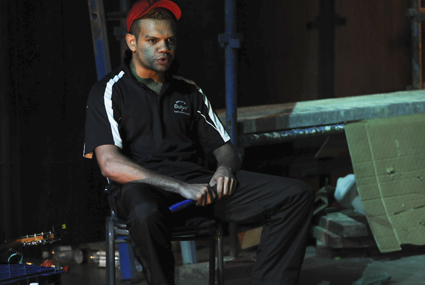
Meyne Wyatt, Buried City
photo Heidrun Löhr
Meyne Wyatt, Buried City
BURIED CITY IS BILLED AS A CO-PRODUCTION BY BELVOIR ST THEATRE, URBAN THEATRE PROJECTS AND THE SYDNEY FESTIVAL, SCRIPTED BY RAIMONDO CORTESE AND DIRECTED BY ALICIA TALBOT. BUT FOR THOSE WHO HAVE BEEN WATCHING TALBOT’S WORK OVER THE PAST DECADE, BURIED CITY FEELS LIKE THE FINAL INSTALMENT OF A FOUR-PART SERIES ABOUT SYDNEY, WHICH STARTED IN 2006 WITH BACK HOME AND HAS CONTINUED AT TWO-YEAR INTERVALS EVER SINCE, WITH THE LAST HIGHWAY (2008), THE FENCE (2010) AND NOW THIS PRODUCTION.
Like its predecessors, Buried City is concerned with the experience of those who exist on our social and political margins. Previously, this has involved audiences travelling to geographical margins too: a backyard in Blacktown (Back Home), a warehouse in Bankstown (The Last Highway) or an old boarding school in Parramatta (The Fence). Here, however, we sit in the city—its skyline visible through a hole in the theatre wall—looking at Belvoir’s familiar triangular stage. Even though Mirabelle Wouters has succeeded in transforming it into a semi-abandoned building site, with scaffolding, milk crates and a small demountable office, it still feels strange. Can it be that there is a margin buried beneath this city centre? More to the point, how will its subjects appear on this very mainstream stage?
The show introduces its six performers/personas (they use their own names) slowly. The first person to speak is the security guard Effie, a confident young African-Australian woman who chastises Russell, a white middle-aged worker, for falling asleep on the scaffolding. Sitting nearby is a young Aboriginal man called Meynedog, whose role at the site is not entirely clear but who seems content just to hang around, stirring. Soon Russell’s friend Perry enters and plays a song on the guitar. Later, Hazem, a self-described “Palestinian Muslim fucking fundamentalist Jihadi fucking queer,” arrives with Val, an Asian woman he’s only just met. Over the course of the evening, these characters cover pretty much everything from the rise of China to the fall of the unions, the role of race, racism and religion, and the number of chickens the Chinese will eat if they adopt a Western diet.
This looping, overlapping dialogue is one of Talbot’s trademarks, as are the split stage (we often have to decide where to look and what to miss) and the deceptively slow unfolding, which eventually explodes into violence. The biggest fight is between Russell and Haz: the former is a proud unionist who still describes himself as a socialist; the latter a young man on the make, talking about money, property and “multiplatform” everything. It seems he used to go out with Russell’s daughter, but it all fell apart. Their messy, inelegant fight is what happens when you reach out to pass the torch only to find the inheritor has his hands full, shaking on deals with the moneymen. If it sounds melancholy, it is, but it is also funny: at the end of the fight, for instance, Meynedog looks down from the scaffold and says brightly, “That was terrific guys.” Similarly, in the final scene, when Perry is playing one of his beautiful songs and the show is threatening to tip into sentimentality, Meynedog interrupts with an aggressive song from the stereo, his lithe frame dancing around the stage like lightning.
While the set and script are strong (apart from the occasional monologue), the performances are slightly uneven: Meyne Wyatt is both mercurial and magical as Meynedog; Russell Kiefel simultaneously belligerent and bereft as he watches the world go by; and Hazem Shammas projects determination as well as confusion. But Perry Keyes’ usually strong stage presence goes missing, as does Valerie Berry’s, and both seem somewhat stilted. Effie Nkrumah does slightly better, but she doesn’t have much to work with. In fact, neither of the women do; as in Back Home, where women were absent, and in The Longest Night, where they were often without agency, the gender lines in this piece are stark.
This is not to criticise Talbot and Cortese for sexism, simply to observe that their interest here is to chronicle the crisis in masculinity brought about by the post-industrial world. In a decade of incredible wealth there has also been incredible stealth, as the gaps between classes, ethnicities, genders and generations have remained or even widened. For this reason, even though Buried City might not be Talbot’s finest or, more accurately, freshest work (it feels too familiar for that), taken together with its three siblings it still marks a major achievement. She, Cortese and the entire artistic team manage to evoke a feeling likely to become more familiar to many of us as the mining boom continues—a strange sense, not unlike like the post-party blues, that everyone else is having a slightly better time of it.
Urban Theatre Projects, Belvoir & Sydney Festival: Buried City, director Alicia Talbot, writer Raimondo Cortese, co-devisors & performers Valerie Berry, Perry Keyes, Russell Kiefel, Effie Nkrumah, Hazem Shammas, Meyne Wyatt, set & costume designer Mirabelle Wouters, lighting Neil Simpson with Sean Bacon, composer & sound designer Paul Prestipino, singer-songwriter Perry Keyes, movement director Kathy Cogill; Belvoir, Sydney, Jan 8-Feb 5
RealTime issue #107 Feb-March 2012 pg. 5
© Caroline Wake; for permission to reproduce apply to realtime@realtimearts.net
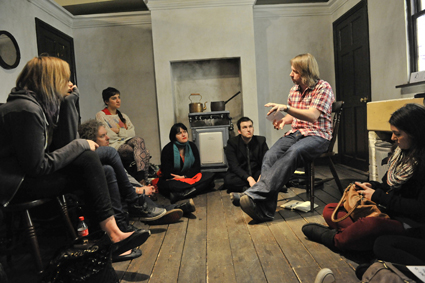
Third Angel, Inspiration Exchange, Compass Festival of Live Art
photo Jonathan Turner
Third Angel, Inspiration Exchange, Compass Festival of Live Art
IN NOVEMBER 2011, WITH TONGUES SUBTLY POKED IN CHEEKS, FIELD THEORY UNDERTOOK DURATIONAL LATTES, A FOUR-DAY CHAT FEST DISCUSSING THE WHO, WHAT, WHERE, HOW AND WHY OF LIVE ART WITH CULTURAL LEADERS IN SYDNEY, WITH A “FINAL REPORT” PRESENTED AT PERFORMANCE SPACE.
Live Art is a sphere that continues to gain traction in Australia, though the then-artistic director of Performance Space, Daniel Brine, noted in his Durational Lattes discussion that it is a term that “has a specific relationship to the British scene.” Shying away from reliance on cultural importation is a valid position, but might negate lessons offered from international perspectives, not to mention a dialogue with similar practices that have long existed in Australia, albeit under a different name. These are some of the thoughts I carried with me as I set off to the Compass Live Art Festival and Symposium in Leeds whilst on a recent trip to the UK.
Compass is an initiative forged between Leeds-based Waymarking (Sarah Spanton) and the Arts Council England, and led by a consortium including festival curator Annie Lloyd and the organisation East Street Arts. Compass presents events throughout the year, but the main focus is the Live Art Festival that couples a weekend-long artistic program with a symposium program of workshop discussions.
The artistic program happened in markets, an empty shopfront, the City Museum, the streets and in galleries and theatres. Activating the city with art in unexpected locations provided a gentle and occasionally critical counterpoint to the pre-Christmas shopping frenzy that seemed to be going on around, and mostly obliviously to, the festival. ‘Exchange’ is now a familiar theme in contemporary art, with artists looking to propose alternatives to capitalist modes of economic exchange and viewing the artwork as a point of exchange for artists, audiences and the public. A number of the works in Compass asked participants to contribute something of their own, and then consider what they received in return.
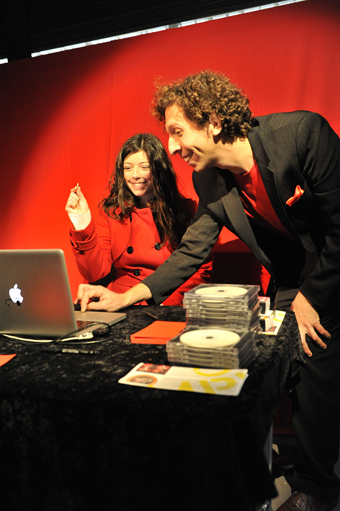
Brian Lobel, Carpe Minuta Prima, Compass Festival of Live Art
photo Jonathan Turner
Brian Lobel, Carpe Minuta Prima, Compass Festival of Live Art
Brian Lobel’s Carpe Minuta Prima presented an explicit monetary exchange, appropriate given its location at the commercially purposed Leeds Kirkgate Market. Lobel would buy a minute of your time for £1 and in an automated exchange your minute was captured on video. These were later sold as DVDs from a stand for £1, obviously not replicating commercial systems in which Lobel’s labour, additional resources, profit margins and ‘supply and demand’ would have been factored into the resale, but instead creating an almost naïve or Utopian economy where one equals one. I didn’t sell, but instead bought a minute, as did my festival hosts whose living room we later sat in watching the DVDs. We got advice (the best fish and chips in town), a performance (a mimed driving sequence) and a plea for help that will never be answered. I wondered how much participants considered what they were selling. The ephemeral minute that was bought turned into their image captured, distributed and out of their control.
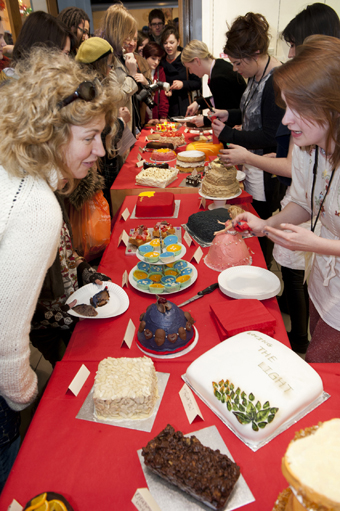
Jenny Lawson, Bake me a Cake, Compass Festival of Live Art
photo Jonathan Turner
Jenny Lawson, Bake me a Cake, Compass Festival of Live Art
In a former United Colours of Benetton shop, another work proposed to take people’s stories and turn them into cake. Jenny Lawson’s imperatively named Bake Me a Cake invited you to drink tea, share your story, choose your ingredients and she would bake a cake to your design. When I arrived I found something of a production line of volunteer bakers and icers. I was offered no tea, but managed to find a piece of paper and a pen and scrawl out a story of significance to me involving cake. I chatted to the women writing next to me but we didn’t share our stories. We left them on a growing pile. If the aim of this work was to make all the participants’ ‘life-cake’ on a single weekend, it was destined for failure. On Sunday afternoon we returned for free cake. Lawson had scrapbooked the masses of outpourings into an impromptu ‘recipe-book.’ Flipping through it provided no intimacy, and even the cakes-from-life that we munched on seemed disconnected from the origins of their aphoristic titles—“Divorce cake” for example, which was particularly tasty.
If exchanges are meant to be fair and balanced and offer something of value to all involved, Third Angel might have hit the nail on the head with Inspiration Exchange. The charismatic Alexander Kelly sat in a Victorian period model kitchen in the Leeds City Museum cataloguing the things that inspire people. You told your story to him and the cramped kitchen audience and then gave it a name to be recorded. In return he chose a card and recited a previous participant’s inspirational story. When people told their stories, they shared with great personal investment. When Kelly re-performed them, whimsy and banality were absorbed by the skill of a master storyteller, always looking to transfer inspiration.
The ‘bigger-ticket’ events recalled the indebtedness of Live Art in the UK to pioneering experimental theatre groups such as Yorkshire locals Forced Entertainment and the English-Belgian group Reckless Sleeper. Reckless Sleeper’s The Last Supper interrogated storytelling and history-making with what transpired almost as a word-association game of recalling the notable dead and literally eating their words, squares of paper disappearing into the performers’ mouths once their contents were recited. Performers and audience sat at dinner tables on the stage, intimately sharing the last meals of executed prisoners as distributed through a kind of raffle. We considered martyrs and criminals alike as defined by their last words and meals. We considered whether we were supposed to eat the cheeseburger and decided we were. Forced Entertainment’s And on the Thousandth Night… (see RT60) further undid the devices of narrative theatre. The pay-offs of duration in performance were explored as themes of half-told stories resurfaced over six hours of stop-start “Once upon a times” that were continuously elaborated and expanded, becoming more and more ridiculous.
It was the Symposium program of workshop-discussions that most defined the issues and politics concerning Live Art as artists, students and academics from a range of disciplines, arts workers and government body representatives mooted questions of access, city making, intimacy, dialogue, touring, funding and more. In the Symposium plenary it was noted by many that more discussions were started than could be resolved. Live Art continues to skirt definition as an art form, and yet still succeeds as a discursive strategy, a research engine and a creative space.
Compass Festival of Live Art and Compass Symposium, various locations, Leeds, UK, Nov 25-27; http://compassliveart.org.uk
RealTime issue #107 Feb-March 2012 pg. 6
© Megan Garrett-Jones; for permission to reproduce apply to realtime@realtimearts.net
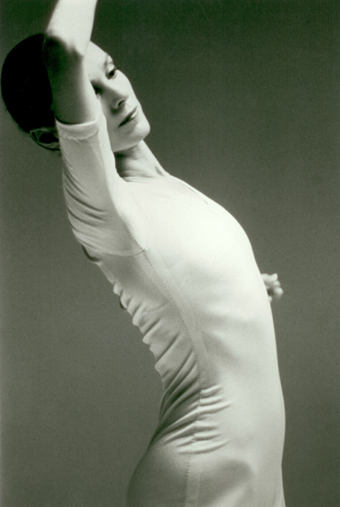
Lucinda Childs
photo Nathaniel Tileston
Lucinda Childs
THE RECENT TURN TOWARDS HISTORY WITHIN CONTEMPORARY DANCE HAS BEEN BOTH PRODUCTIVE AND ENLIGHTENING. TAKING THE 2005 BOOK ENTITLED MERCE CUNNINGHAM, FIFTY YEARS AS HIS STARTING POINT, FRENCH CHOREOGRAPHER BORIS CHARMATZ RECENTLY CONSTRUCTED A PERFORMANCE FROM ITS IMAGES (50 YEARS OF DANCE).
Brussels based Olga De Soto based a ‘performative lecture’ on a 1932 piece by Kurt Joos (An Introduction). And Eszter Salamon adapted John Cage’s 1949 “Letter on Nothing” (Dance for Nothing). Locally, Jane McKernan curated an excellent program of short works titled Dance History, for Campbelltown Arts Centre in 2010 that began with the dancers reeling off choreographers names from across the 20th century.
This historical turn in dance has shown that some of the most relevant artists were, unsurprisingly perhaps, some of the most controversial in their own time. Lucinda Childs, with a 40-year career, is one such example eliciting a recent homage from Dutch choreographer Nicole Beutler, Dialogue with Lucinda (2010). Beutler worked with one of Childs’ assistants and the choreographer enjoyed the resulting work. Childs is happy to be seen within such a context: “We want the art form in and of itself to be important, to protect and preserve that dance tradition.”
Childs explains that her key work, DANCE (1979), was created in collaboration with composer Philip Glass and visual artist Sol LeWitt following Childs’ collaboration with Glass and Robert Wilson on the landmark opera, Einstein on the Beach in 1976. I asked how the special dialogue between the choreography and music in the work was produced: “Well the music came first—I felt I wanted to work very much with the existing structure in order to create the counterpoint, dialogue and tension with the choreography.” However, Childs carried out the project in a truly collaborative spirit. “I would never want to give another artist an ‘assignment’—I want them to enter into it with a completely open mind and spirit, so they really are involved from the very, very beginning, not stepping into an existing situation.”
Childs would go on to collaborate with Wilson as both choreographer and performer many times and a large part of her work over the last 20 years has been within the field of an expanded notion of opera pioneered by Wilson. Childs has played an important role in ensuring a place for dance within the innovations occurring where the performing arts meet at key moments in the last 40 years.
DANCE is a rarity, now perhaps even more than when it first appeared. It manages to combine original and compelling choreography with highly conceptual work that is intensely dependent on structures and dimensions brought from other art forms. DANCE was first remounted in the US in 2009 and some of the dancers cast in that revival will be performing in a season of the work at Perth International Arts Festival in February. Childs, a member of the influential Judson Dance Theater in New York which re-routed 20th century dance onto its current course, established her own company in 1973 with the aim of developing a distinct choreographic language that broke with the questioning of dance (“making an omelette out of anything but an egg”) that had marked Childs’ work with Judson.
DANCE is the original contemporary dance work to use an intensely limited palette of movement in a composition of infinitely varied phrases. Like Glass’ music, it seems more apt to use the term ‘essential’ than ‘minimal’ in describing the work, a point made by Glass himself. This seems to preserve the positive dimension of the creative process, describing a distillation rather than a process of stripping away. In an article written in 1975, Childs describes a choreographic process where one element acts as a “sounding board” for the rest of the work, so that the composition consists of “reversals, subdivisions, inversions, re-ordering in space, and displacement from one dancer to another.” Childs explains that her interest in DANCE was not in developing a “personal vocabulary” but in creating “simple ideas that relate to the structure of Philip Glass’ score… not so much the content but what he’s done with the material…not to illustrate the music or contradict it, but to set a tension between the two structures.”
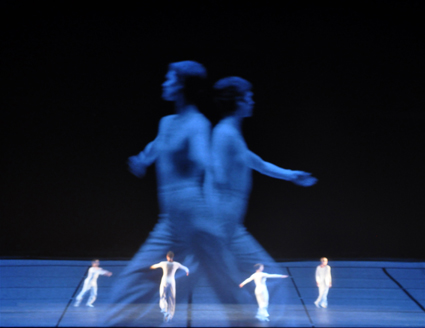
DANCE, Lucinda Childs
courtesy PIAF
DANCE, Lucinda Childs
The flow or sustained quality of the work creates an impression of flight; the dancers seem to ride the rhythm and energy of a swinging momentum with ease, as if they are being danced by the score. “In performance, there is an excitement connected to the physical and mental stamina of the dancers…it’s a virtuosic style that doesn’t come out and make a big splash, but we sustain and build over a period of 20 minutes. That’s something we really have to work on. But there is also just the enjoyment of the music—we never get tired of the music.” The impression of ease is deceptive: “The precision required of the dancers is enormous because they have to count the music very carefully in order to perform the kind of structuring I want, which is a counterpoint really.” Precision is also required because they are performing with the virtual ‘ghost’ dancers featured in LeWitt’s projections from the original 1979 production.
Originally shot on 35mm B&W film and projected onto a scrim both with and without the dancers on stage, it is the only film ever made by Sol LeWitt and provides the ‘scenario’ for DANCE, so that everything on stage refers back to the realm of the composition. “The main aim for LeWitt was not to create some arbitrary drop for the dancers to dance in front of, and in a way he wasn’t sure how to collaborate until we decided that the décor should be the dancers.” The projected dancers expand upon the live performers as echoes or shadows, but they also ‘flesh out’ the visual movement by reiterating—but also complicating the already intricate variations on one theme that make up the dance. Lucinda Childs states that the projection provides ‘a different point-of-view because of all the shifts in camera angle and editing—LeWitt did a phenomenal amount of work on that and I think that’s something people can see in performance—it’s very clear.”
Perth International Arts Festival: Lucinda Childs Dance Company, Dance, Heath Ledger Theatre, State Theatre Centre of WA, Perth, Feb 22-25, perthfestival.com.au
RealTime issue #107 Feb-March 2012 pg. 9
© Erin Brannigan; for permission to reproduce apply to realtime@realtimearts.net
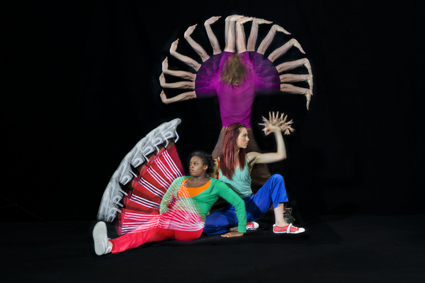
Proximity, ADT
photo Chris Herzfeld, Camlight Productions
Proximity, ADT
GARRY STEWART’S LATEST WORK FOR ADT IS PROXIMITY WHICH WILL PREMIERE AT THE 2012 ADELAIDE FESTIVAL. AS WITH HELD (2004) AND DEVOLUTION (2006) PROXIMITY IS ANOTHER OF STEWART’S VISCERAL YET CEREBRAL EXPLORATIONS OF THE RELATIONSHIP BETWEEN IDEAS, THE BODY AND TECHNOLOGY FURTHERED HERE BY HIS PASSIONATE INTEREST IN NOTIONS OF SELFHOOD AND ITS NEUROSCIENTIFIC CORRELATIVES AS DEMONSTRATED IN BE YOUR SELF (2010). I SPOKE WITH STEWART ABOUT THE ORIGINS OF PROXIMITY AND ITS CONNECTIONS WITH ITS PRECURSORS.
When did you start thinking about Proximity? What came first, an image, the idea or the technology? What kicked you along?
For the last several years, I’ve wanted to do something post-HELD (the 2004 work with US photographer Lois Greenfield), something that again worked with the reproduction of images of dance on screens. HELD was just ridiculously bombastic and ironic, a very particular point of view of the utilisation of dance photography from a quasi-heroic perspective. So I wanted to approach similar technology but work in a softer, more poetic aesthetic territory and find other ways to bring the audience into the detail of the body. I was going to do another version of HELD using stills photography but after a creative development where we also worked with video cameras it seemed more interesting to see what we could do with video.
Then I was commissioned to make The Rite of Spring for Ballet du Rhin (Strasbourg, 2011) and I think I must have thought through about 20 possible different versions of The Rite of Spring. At the 11th hour, as we were about to start rehearsals, I decided to have dancers videoing each other. So it became a dialogue between real time dance and real time video manipulation. That became in a way the first stage of thinking further about Proximity as a post-HELD piece.
So I worked with Thomas Pachoud. He’s Paris-based and doesn’t call himself a video artist but a video engineer. He studied computer science and basically lives in a world of writing code and programming in terms of algorithms. It was a bit of a blind date working with him on The Rite of Spring but it went really well. So I said do you want to come to Australia and continue the investigation? We both felt that we wanted to continue working together. We’d just scratched the surface—in ballet companies you get to work three to four weeks. So he came here and we’ve been working together for a couple of months and we’ve just really expanded upon the ideas that we began with.
It’s very nice to think of the works in terms of a series or of different works having a dialogue with each other rather than necessarily all the time making a work and then trying to make a paradigm leap to something completely different. I think Proximity is also informed by ideas from Be Your Self, the work I made for the last Adelaide Festival [and which will be staged in Sydney later this year. Eds].
That work was primarily based on ideas on the nature of selfhood, which came out of Buddhist meditation classes that we have in the company. We have a Buddhist teacher who comes in once a week and a lot of the discussion is about the nature of self. Proximity is really the convergence in some ways of some of the concerns of HELD and Be Your Self and using video technology to make visible the invisible connections that exist between us and the world around us.
A kind of phenomenological investigation?
Be Your Self is very much rooted in phenomenology. Proximity is a little bit more coming out of philosophies of selfhood but is also informed by neuroscience. I’ve been having a few chats with Ian Gibbins, Professor of Physiology at Flinders University, about body maps and the ways we neurologically engage with the world. In the parietal lobe of the brain there are countless body maps; our entire body is mapped in our brain. So, when we engage with the environment and as agents in the world, these neurological maps actually extend into the world. So if I’m driving my car, my body maps incorporate the volume and weight, the friction on the road and the velocity of the car etc. It’s actually quite a real connection with the body, not just armchair philosophical or poetic.
Watching the trailer I was struck by the lines of force or attraction [discussed as “webbing” below. Eds] that appear between the dancers in the video projections shot live by other dancers.
The video acts as an analogy or metaphor for these fields of neurological connectivity. Another idea in Proximity is the notion of the plurality and multiplicity of selfhood and our sense of the way consciousness works. Because we inhabit one body over a single lifetime we have this sense of ourselves as being a unified if malleable entity. But I think that there are competing selves. When I made Be Your Self I was thinking a bit more literally about competing selves, whereas now I think that rather than a whole group of actual competing selves, the nature of selfhood is in the body’s multiplicity. It’s more fractured and there’s more difference than we can understand. I guess the work in some ways is concerned with revealing that and offering the potential for creativity within it, and a sort of fluidity in terms of identity and who we are in the world.
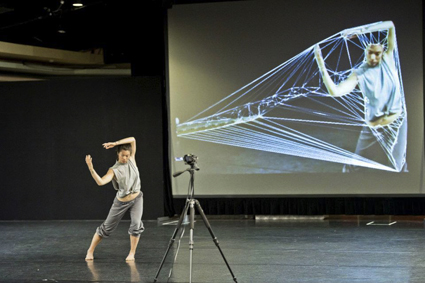
Proximity, ADT
photo Chris Herzfeld, Camlight Productions
Proximity, ADT
The multiple selves don’t necessarily need to be in conflict do they, if they’re creative?
It’s like an ecosystem. We’re all interdependent, making up the totality or depth of an individual. One of the principal sub-concepts behind the work is the notion of the visual. How do we see, particularly when we’re using technologies such as video and photography. We make choices about what we reveal. We frame objects in the world which then creates a set of relationships, some kind of dialogue that’s culturally underpinned. Inherent in the corollary of framing is what do we omit. Also, how do we evaluate what we’re seeing?
These are like neural networks extending beyond the brain.
Yes. The interesting thing about some of these video techniques is that as you’re watching, as an audience member, they affect you neurologically. The effect we call “webbing” for me is really the cornerstone of what Proximity is about, these algorithmic points that connect the bodies in the space and what we see projected is all the complex rhizomatic network of webs that connect bodies. The way that those lines work—because of the algorithms that have been created [by Thomas Pachoud] to make them—gives you a sense that they have pressure and tension. It’s really interesting because it’s a complete illusion; it’s just a visual effect. But you feel like when you’re looking at the images of the dancers on the screen that they’re really connected to each other within these lines. You somehow feel that force and tension yourself. It’s that phenomenon where, when you watch dancers leaping through the air, you empathise with that and neurologically you quasi-experience it.
The mirror-neurons effect. How does the use of the cameras relate to this? Some dancers will have cameras onstage?
The dancers are operating the cameras. There are three of them, two on the stage and one above. The dancers are moving them about and setting them up in terms of focus and positioning. They can actually film themselves once they’ve set up the camera. So someone might be filming someone’s solo and then they’ll leave the camera and go and stand in front of it themselves.
And they appear on a screen and might be multiplied?
There are a whole lot of effects that we’re engaging in over about 70 minutes. I’m trying to find as many different ways as possible to engage the audience in the experience of the ideas I’ve been talking about. I didn’t just want to make a dance piece with really great video. I’ve noticed working with technology in the past that it’s so time consuming and difficult that you can actually get caught up in just that. But like every work it needs to have dramaturgical rigour; that’s really the driver. The technology falls under the service of it. So I’ve also been concerned with not just taking the audience on a conceptual journey but also an emotional journey.
How do you approach that?
With great difficulty. It evolves over time. I tend to have reasonably lengthy rehearsal periods and this one is over four months. I struggled with the idea of having text in the work. In general I like the audience to enter into some kind of mystery that they don’t quite understand. On the other hand, I think with a work that’s using video technology it can easily fall into just an aesthetic. So some of the ideas are expressed in text that’s printed and embroidered onto the costumes and then that’s filmed, magnified on the screens for the audience to read. It’s giving out just enough information.
Is it literal text or lateral, poetic, informational?
At the moment it’s more an expression of neuroscience—factual rather than poetic, about how, in pedestrian language, you might describe the effect of body maps and mirror neurons. But they’re just clues.
And that emotional journey for the audience?
Well, that was the big challenge with Be Your Self. For me, that was the most difficult thing I’d ever made because it was centred on subjectivity and also the way in which emotions function and are conveyed. Suddenly I felt like the work was heading down a dance theatre track, which was very worrying (LAUGHS) because I think you really need to know what you’re doing to handle that. It’s not something I’m adept in, you know, expressing very particular emotional and psychological states through the body in the way that people like Lloyd Newson, Pina Bausch and others are so brilliant at. For me that was really difficult and I spent a lot of time making material and then discarding it because I felt like I’d seen it before. That just chewed up a lot of rehearsal time and in the end I had to make decisions about a way in which to represent those ideas that in some way didn’t smack of modes of expression that I’d seen in dance theatre for years.
Do you feel you’re pushing yourself into new territory?
In some ways, I think, because I’d made Be Your Self, it had eliminated a lot of conundrums in regard to notions of selfhood. I’d already worked through my problems with that.
You have no idea what the work is going to look like when you set out. No idea whatsoever. And of course, as with everything in life, you lay down some kind of structure, some sort of direction, which is really important because that gives you an energy that propels you. But as soon as it starts to manifest, this thing that you thought you were going to make, it turns into something completely different. And certainly this piece has been no exception.
–
Adelaide Festival, ADT, Proximity, Her Majesty’s Theatre, Feb 25-March 3; www.adelaidefestival.com.au
RealTime issue #107 Feb-March 2012 pg. 10-11
© Keith Gallasch; for permission to reproduce apply to realtime@realtimearts.net
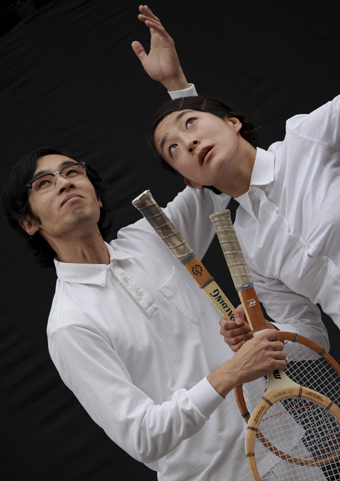
Sivouplait
courtesy WOMADelaide
Sivouplait
JAPANESE PERFORMERS, SIVOUPLAIT (NOZOMI HORIE AND TAKESHI SHIBASAKI), WILL ADD A DASH OF MAGICAL REALISM TO THE 2012 WOMADELAIDE IN THEIR OPEN AIR PERFORMANCES DIRECT FROM THE STREETS OF TOKYO AND A VARIETY OF INTERNATIONAL ARTS FESTIVALS. I RECENTLY SPOKE WITH NOZOMI THROUGH AN INTERPRETER—DOUBTLESS NOT A LITTLE WAS LOST IN TRANSLATION, BUT NOTHING IS LOST IN THE PAIR’S ELOQUENT MIME WORKS. ALSO IN THIS YEAR’S WOMAD IS SHANTALA SHIVALINGAPPA, A LEADING EXPONENT OF INDIAN CLASSICAL DANCE IN THE KUCHIPUDI TRADITION.
sivouplait
Sivouplait are mime artists presenting prepared pieces with a bit of room for improvisation depending, says Nizomi, on the nature and size of their audience. Each work starts out from a simple (or sometimes outrageous) premise: a couple decide to photograph each other but a fierce wind wreaks havoc on their efforts; two people transform into big-beaked birds that indulge in a comic courtship ritual; two players enact a larger than life tennis game; and the pair conjure an urban spaghetti western. Each performance is carefully paced, whimsical and sometimes laugh-out-loud funny. Titles of works and scenes are announced silently using large cards and the soundtrack is provided by a small portable record player. Above all Sivouplait are deft mimes with a finely tuned sense of their audience,
I ask Nozomi about the pair’s training. She says it came from a very good pantomime teacher and that the rest was learnt on the streets where the work was well received and the invitations to festivals began to flow in. As for influences, the press release for the show cites silent movies, manga, animation, dance and physical comedy which are evident in the work (although I’m not sure about the manga). Certainly, their work appears to be very much in the Western mime tradition (which is surprisingly popular in Asia as I witnessed at the Chuncheon International Mime Festival, Korea in May 2009).
Nozomi says that a key influence is the great Japanese filmmaker Yasjiro Ozu because of what his films say about couples whether in his comedies or his dramas. Sivouplait’s press release states, “This curious Japanese couple are always talking about love—yet they never use words.” When I watch Sivouplait in their immaculate tennis whites on video I can’t see many signs of love. But the press release asks insistently, “Is their perfect love dazzling and pristine, or do they encounter the same doubts, troubles and irritations that befall us all in relationships?”
Nozomi explains, “Sometimes in love Japanese don’t express themselves straightaway with, for example, kissing. This fits well with pantomime. Anything is possible—tennis, photography, birds—but love is always there.” So then I pose the question they’re always asked (much laughter), Are Nozomi and Takdeshi a couple? “It’s up to your imagination,” replies Nozomi. “So,” I say, “it is a love story.” More laughter.
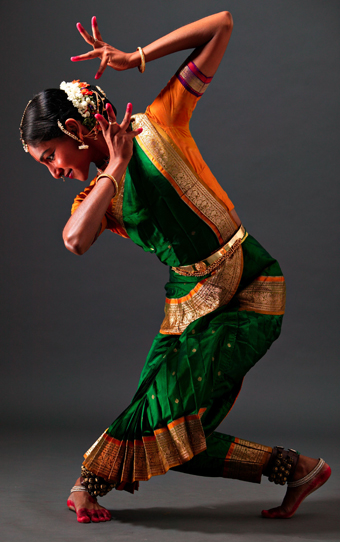
Shantala Shivalingappa
photo C P Satyajit
Shantala Shivalingappa
shantala shivalingappa
Also performing in WOMADelaide is Shantala Shivalingappa, a major Indian dance artist who also has a career in European performance, having worked with Maurice Bejart, Peter Brook in Hamlet (as Ophelia) and The Tempest (as Miranda), Pina Bausch (O Dido, Néfès, Bamboo Blues, Sacre du Printemps) and Ushio Amagatsu (Ibuki). Born in India, raised in Paris, introduced to Kichipudi traditional dance by her mother and then trained in it back in India, Shivalingappa has subsequently had works created for her by her Indian masters.
Kuchipudi is a classical dance from southern India, emerging in the 15th century and rooted in folk dance. The name is taken from the village where it was assumed to originate, Kuchipudi, in the state of Andhra Pradesh. The form is at once abstract and rhythmical while also overtly dramatic with the performer taking on divine roles. Shantala will, for example, evoke Ganga, the goddess of the Ganges River, as well as Shiva the male God of destruction and transformation, in the very same dance. Hand gestures and facial expressions are central to this dramatisation, while live accompanying music is a vital part of Kuchipudi dance.
Save for some YouTube glimpses I’ve not seen Shantala’s internationally praised dancing, but I have witnessed a Kuchipudi performance and been struck by the power, subtlety and sense of drama emanating from a single body. Shantala’s presence would be a coup for any international arts festival and no less so for WOMADdelaide.
The musicians in WOMADelaide invariably display a great deal of theatricality as an inherent part of their music-making, but for something different make sure you seek out Sivouplait and Shantala.
WOMADelaide 2012, March 9-12, www.womadelaide.com.au
RealTime issue #107 Feb-March 2012 pg. 11
© Keith Gallasch; for permission to reproduce apply to realtime@realtimearts.net
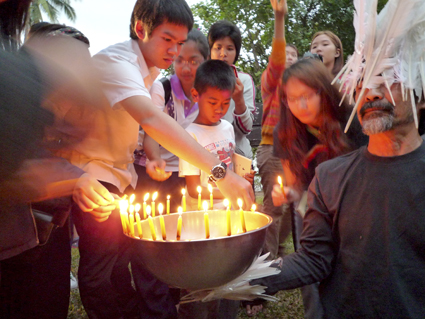
Chumpon Apisuk, Asiatopia 13
photo Yiorgos Zafiriou
Chumpon Apisuk, Asiatopia 13
AT DUSK, A CROWD GATHERS AROUND CHUMPON APISUK IN AN OPEN GRASSY AREA. HE HAS THE AUDIENCE PLACE LIT CANDLES ON THE RIM OF A LARGE STAINLESS STEEL BOWL. HE WRAPS HIS FOREHEAD AND HANDS IN A LONG BAND OF WHITE FEATHERS AND LEADS THE CROWD THROUGH THE PARK, BALANCING THE FIERY BOWL ON HIS FEATHERED RIGHT HAND.
This was a perfect way to lead a procession; a physical act of ritual where movement and transformation are key. Later when I ask about the symbolism of the feathers, he explains that some caged ducks, unable to escape, perished in the Bangkok floods. It heightened the meanings of flight and freedom I ascribed to the work. Apisuk is a leading international figure in performance art. His vision to bring it to Thailand created the impetus for the Asiatopia Festival, now in its 13th year and managed by the efforts of Concrete House Artists’ Collective. Asiatopia is a global event and has established itself as an important space for exchange amongst local and international artists.
Asiatopia 13 was a creative feast, realising the unpredictability often attached to performance art. There were strange happenings and subtle movement, there was blood and glitter and fire and it got very messy. Presented as an International Performance Art Festival, Asiatopia 13 was underpinned by its title Eartheffect [sic] giving artists space to explore and expose schisms on the earth, in the self, humanity, faith, politics, life and love.
Eartheffect was driven by serious events that shook the planet in 2011 in Japan, New Zealand, Chile and Haiti after which lives became irrevocably transformed. This solemn backdrop kept the fragility of life ever present throughout Asiatopia 13 with artists investing a genuine care and mindfulness in their works while still unpacking the complexities of personal and political upheavals.
Asiatopia 13 ran over three consecutive weekends during the flooding in greater Bangkok requiring the first weekend’s performances to be relocated from Bangkok’s Art and Culture Centre to the Fine Arts Department of Chiang Mai University. The following weekend was held in Suan Buak Haad Park (Chiang Mai) and the final performance, Artists’ Party, was a splinter event held on the rooftop auditorium of the Klang Plaza Shopping Mall in Nankorn Ratchassima (Korat City).
Communicating ideas and emotions through performance can be complicated. Asiatopia 13 was saturated with a breadth of imagery, abstract, ephemeral and personal in nature—sometimes exhausting to take in. I viewed the work through the prism and problematics of critique. For the artists, I imagine their critiques are of ideas, the self, the law and bureaucracy. In some cultures it is difficult or impossible to question authority let alone one’s own autonomy. However, performance allows a retreat into the poetics of a symbolic language which transcends both words and borders. This can reveal an artist’s inner anxieties communicated as performance, albeit in only one direction, from the artist to the audience. The artist can also seek to unravel their own performance language.
Nopawan Sirivejkul throws marbles at the start of her piece signifying that she’s playing with her life. She’s surprised when I later explain that in English “losing your marbles” is akin to becoming mentally unhinged. This highlighted the idea of performance as culturally coded and always at risk of being lost in translation.
Suan Buak Haad Park was brimming with a vibrant life of its own, people enjoying Chiang Mai’s temperate climate: running, walking dogs and doing other parky things. Having the festival in a park made it a public event capturing a diverse audience who at times were unaware of what was actually happening, though the artists and the details of the event were announced in Thai and English. The public were truly engaged by the works presented in a country where, as elsewhere, sound financial support is scarce for performance art while traditional art forms are favoured. Artists in Asiatopia 13 largely self-funded their participation with some having additional support from their respective countries.
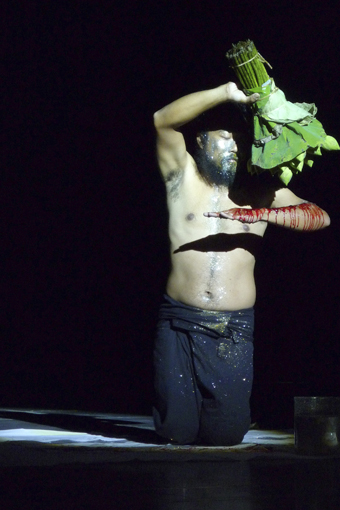
Boonsong Rodthab, Asiatopia 13
photo Yiorgos Zafiriou
Boonsong Rodthab, Asiatopia 13
It was inspiring to see the involvement of younger artists. Sitthikan O Techadilok handed out ceramic animals to the audience, especially to children who constituted a significant part of the audience in the park. He then sat cross-legged and after some playful gestures with his menagerie on a small checked tablecloth, he folded the animals into the cloth and reached for an enormous metal wrench. The result was carnage, one brutal act echoing the human relationship with nature: interventionist, controlling and sometimes ultimately destructive.
It’s a rare occasion when performance ceases to be a cerebral experience for me, becoming something far more elusive. Boonsong Rodthab’s performance had me gasp in awestruck fascination. In the cavernous space of the top floor of a shopping mall, a handful of glitter is abruptly sprayed onto the artist’s face and a beautifully clustered bunch of lotus buds, when overturned, literally bleed onto his hands, arms, over his body and then onto a white cloth. The work was serious and serene. It was Oriental and Occidental; it’s blood that binds us all.
Perpetua Rodriguez actions a more intimate work. She strips bare and circles herself with earth. Then using a 10m rope she connects herself to a randomly selected member of the audience, leading him on a path through the dimly lit auditorium to a space under the stage with the rope firmly tied around his waist. There was an elusive type of vulnerability in the slow walk through the space with her nakedness in marked contrast to the clothed stranger and the audience following in slow procession. The piece pivots on an historicising of performance art, referencing Rope Piece (1983/84) by Linda Montano and Tehching Hsieh in which the two were tied together for one year. Rodriguez’s piece acted as a reminder of the important role Asian artists have played in developing performance art.
Asiatopia firmly places itself as a centre for performance art and demonstrates a maturity that extends beyond any seemingly fleeting fascination with the form found in the region through the 90s.
Asiatopia 13 was a phenomenally interesting experience, at times exhausting to watch and a challenge to unravel meanings in the works of so many artists. It was bold and brazen, expressing a fresh freedom for artists to explore performance art. As writer and critic Thomas Berghuis has proposed, performance art is an unsung yet critically developed medium in the Asia Pacific.
Asiatopia 13, Bangkok and Chiang Mai, Thailand, Nov 23-Dec 11, 2011
RealTime issue #107 Feb-March 2012 pg. 14
© Yiorgos Zafiriou; for permission to reproduce apply to realtime@realtimearts.net
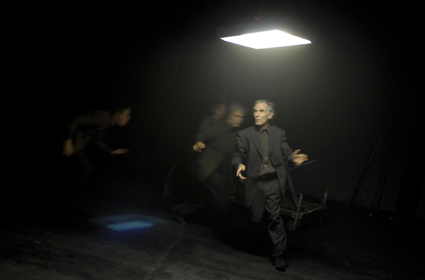
Katia Molino, Ari Ehrlich, The Babel Project (2007), Alan Schacher, Gravity Research Institute
photo Heidrun Löhr
Katia Molino, Ari Ehrlich, The Babel Project (2007), Alan Schacher, Gravity Research Institute
THE STRONG PICTORIAL CONTENT OF EACH EDITION OF REALTIME ATTESTS TO THE EXPERTISE OF A NUMBER OF SPECIALIST PHOTOGRAPHERS. FOR THE EVOCATIVE IMAGES REGULARLY FEATURED ON OUR PAGES, WE’RE GRATEFUL TO ARTISTS SUCH AS JEFF BUSBY, CHRIS HERZFELD, PONCH HAWKES, LISA TOMASETTI, PRUDENCE UPTON AND OTHERS.
When you’re reading about performance in Sydney, the photographer whose pictures you’ll see most often is Heidrun Löhr, a dedicated and gifted artist who has documented the performance scene in this city for 25 years.
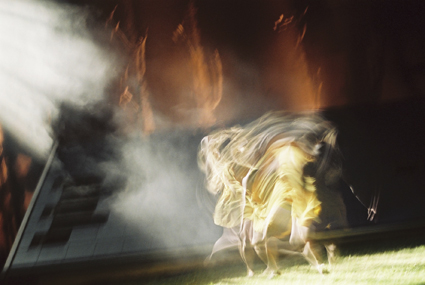
Sarah Jayne Howard, Already Elsewhere (2005), Force Majeure
photo Heidrun Löhr
Sarah Jayne Howard, Already Elsewhere (2005), Force Majeure
In 2007 Heidrun Löhr received an Australia Council Fellowship to create an archive from her thousands of still images. A selection of these were featured in a moving exhibition entitled Projections: The Archive Project at Critical Path (RT92, p20). Löhr’s work is now to be introduced to a wider public in an exhibition at the Australian Centre of Photography entitled Parallax: The Performance Paradigm in Photography. “Parallax is a simple enough problem for photography: the image you make depends on your viewing angle. But when you add the variable of the moving body in performance, the parallax factor multiplies to a point when the camera captures something no human eye will ever see in any other way…This respected photographer of live performance is famous for her active use of the camera around the stage, tracking across the various viewing positions (possible and impossible) of the spectators. Her photographs are more than documents of a vanishing work, they are collaborative works, images built out of the action of the photographer as much as the gestures of the moving body on the stage.” (ACP media release)
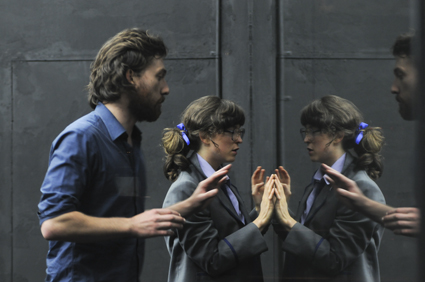
Simon Stone, Eloise Mignon, The Wild Duck (2011), Belvoir
photo Heidrun Löhr
Simon Stone, Eloise Mignon, The Wild Duck (2011), Belvoir
The exhibition has allowed Löhr to transfer some of her most striking dance theatre and performance slides to large format prints. There are also colour images, photo sequences—some echoing Eadweard Muybridge—and an animated sequence involving some 3000 still images produced for the SEAM2010 conference at Critical Path with performer/choreographer Nikki Heywood. On what she calls “the multitude wall” a range of work is documented—from 1986 (Judy Best performing in a disused building in Kings Cross—a performance we agree would probably not be possible with contemporary OH+S legislation) through to Martin del Amo’s 2012 work for dancer Paul White, Anatomy of an Afternoon. As well there are two vitrines displaying more archival material and a number of Löhr’s limited edition artist books.
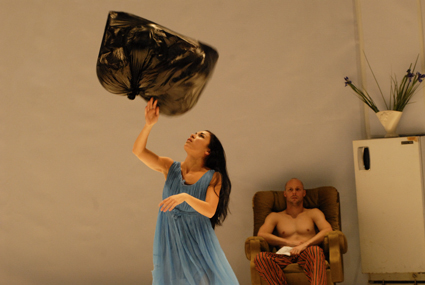
Marnie Palomares, Rowan Machingo, Back from Front (2008), Dean Walsh, Performance Space
photo Heidrun Löhr
Marnie Palomares, Rowan Machingo, Back from Front (2008), Dean Walsh, Performance Space
In her choice of most of the works in this exhibition, Löhr says she has favoured photographic interest over historical/documentary function. Considering so many possibilities, it’s “iconic images, ones that compress time or that still take me by surprise after all this time” that rise to the surface. Some images capture directors like Benedict Andrews and Simon Stone working behind the scenes while the majority convey dramatically, poignantly and playfully the world of contemporary performance from the vantage point accorded to Heidrun Löhr as a highly respected member of that community.
Heidrun Löhr, Parallax: The Performance Paradigm in Photography, Australian Centre for Photography, Sydney; March 3- April 15, artist talk March 3, 11 am; http://www.acp.org.au/
RealTime issue #107 Feb-March 2012 pg. 15
© Virginia Baxter; for permission to reproduce apply to realtime@realtimearts.net
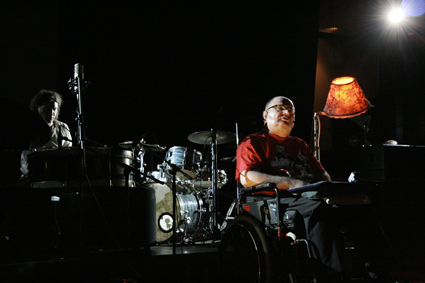
Robbie Aveniam, John Blades, Slices of My Life, the NOW Now Festival 2007
photo Tom Bannigan
Robbie Aveniam, John Blades, Slices of My Life, the NOW Now Festival 2007
THE BROADCASTER, MUSICIAN AND PERFORMER JOHN THOMAS BLADES DIED 25 NOVEMBER 2011. HE WAS BORN IN DECEMBER 1959.
John was an inspirational member of Sydney’s music community for many years, approaching life with breathtaking passion, never allowing Multiple Sclerosis, with which he was diagnosed in 1982, to arrest his activities. He said in his 2010 radio documentary The Too Hard Basket, “It has been very important to me throughout my MS to never regard myself as sick. The word ‘sick’ is a straitjacket” (360 documentaries ABC-RN).
One of John’s many passions was The Loop Orchestra, and it remains Australia’s most enduring experimental music project—29 years of broadcasts, recordings and performances. MS over time reduced his motor functions and he was eventually wheelchair-bound and had to give up his job as an engineer at the RTA. He continued with The Loop Orchestra, his radio program Background Noise (with collaborator Richard Fielding) and his interests in culture and communication.
On 17 July 2006 the gig series If you like improvised music we like you at PELT gallery presented “a unique collaboration between Robbie Avenaim (percussion and electronics) and John Blades who will be presenting a spoken word piece entitled ‘a slice of my life’.” John performed an expanded version titled Slices of My Life in January 2007 with Avenaim (percussion) and Chris Abrahams (piano) at the NOW now Festival in Sydney. It remains one of the most touching pieces of music theatre I’ve seen.
As in all aspects of his life his preparation was meticulous—perhaps a legacy of his engineering training. John had a script on his wheelchair tray, but during the performance he didn’t refer to it—he’d memorised the 45-minute text. The script was autobiographical—he talked about MS, his work as an engineer, his love of music, film and Art Brut, his involvement in radio, The Loop Orchestra, his interest in serial killers, his relationships with specialist cab drivers and his revelatory introduction to computers.
This public self-dissection of his privacy was presented with humour, generosity, honesty, intelligence and courage—there was no hint of self-pity. He shared his heroic tale, not to self-aggrandise, but because this story is engaging and needed to be told for the sake of others who live with a disability, whose stories usually go unreported. But it was only a script, it had to be contextualised musically, it had to be performed by a body.
When you see interviews on YouTube of John from 1990, you realise how fluent his speech had been as a young man, but MS robbed him of muscle control—you could see and hear the effort it took him to speak. In Slices of My Life his ‘song’ created deeper meanings which would have been lost in written form. His voice after 30 minutes tired and the audience became acutely aware of the effort. But he remained articulate as the voice gradually got slower and less powerful.
There is little else with which to compare Slices of My Life. The fragile song was defined by John’s body’s capabilities in a way that made me think of Stelarc’s body interacting with technology. It also made me think of Ian Curtis’ wavering strength in Joy Division (one of John’s favourite bands). The performance of Slices became a metaphor for his life.
It was appropriate that he chose music to tell his tale: he loved and understood music so much. And despite the powerful content of his text it remained the work of a trio. Abrahams and Avenaim, sensitive to the content of the text and the fragility of the song, were equal players, creating parallel structures that were as engaging as the unfolding story. As in all his endeavours, John was comfortable with collective authorship.
In 2010 John went on to communicate another untold story of sex and disability in the documentary The Too Hard Basket for ABC Radio National. It won the Walkley Award for Social Equity Journalism—All Media, and the Radio Documentary of the Year Award from the Asia-Pacific Broadcasting Union. In this work John communicated with humour, generosity, intelligence, honesty, courage and great dignity. That’s how we’ll remember him.
Jim Denley
John Blades also appeared in the documentary film Scarlet Road (director Catherine Scott, 2008). Eds
RealTime issue #107 Feb-March 2012 pg. 41
© Jim Denley; for permission to reproduce apply to realtime@realtimearts.net
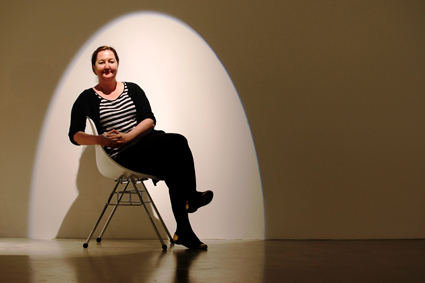
Lisa Havilah
photo Luke Fuda
Lisa Havilah
LISA HAVILAH, DIRECTOR OF CARRIAGEWORKS, RECENTLY LAUNCHED HER FIRST PROGRAM, A STRATEGICALLY CURATED YEAR OF MULTIDISCIPLINARY WORKS WITH WHICH SHE WILL BEGIN TO REALISE HER VISION FOR THE ARTS CENTRE. HER SUCCESSFUL DIRECTION OF THE CAMPBELLTOWN ARTS CENTRE PROVED THAT HAVILAH HAS THE ENERGY, COMMITMENT AND AMIABLE DETERMINATION TO REALISE HER CARRIAGEWORKS VISION. I ASKED HER HOW SHE HAS GONE ABOUT ‘CONSTRUCTING’ A CONTEMPORARY ARTS CENTRE. WHAT WILL MAKE CARRIAGEWORKS A PARTICULAR PRESENCE—PROGRAMMING, PARTNERSHIPS, COLLABORATIONS, NETWORKS, USER-FRIENDLINESS?
locally
Havilah is emphatic that programming is central to her vision—programming that is consistently multidisciplinary, representative of local culture (very immediately that of Aboriginal Redfern), of established innovative Sydney companies (Carriageworks residents Performance Space, version 1.0, Force Majeure, Stalker, Playwriting Australia, Erth) as well as emerging talent. Carriageworks also acts as a co-producer to ensure that companies with limited resources have the support they need.
Havilah says: “We’re working to make Carriageworks an integral part of the greater Sydney contemporary art and cultural landscape. This is partly being achieved through collaborations with other respected arts organisations such as the Sydney Festival, NIDA and the Biennale of Sydney.” Carriageworks’ 2012 program also includes productions presented in association with Belvoir, ATYP and, through Performance Space, with Mobile States.
At the same time Havilah is deeply conscious that Carriageworks is not part of Sydney’s harbour culture, hence a need to establish it as a unique arts centre in a distinctive urban demographic. She comments: “Carriageworks is a remarkable space but we feel it’s yet to be shown consistently operating at its best. The introduction of the first annual artistic program is set to change that.
“We are working to expand the amount of presentation space: the two Tracks, previously used for rehearsal, workshopping and Performance Space’s Clubhouse, now have consent to be used for the public presentation of works that will increase the volume and scale of programming and opportunities for resident companies and other events.” Havilah is also keen to address the potentially longer lives of works in her program.
Her commitment to Aboriginal art, especially that with its roots in Redfern, is evident in her collaboration with Sydney Festival director Lindy Hume to co-present Black Capital (see Sydney Festival review and interview with Wesley Enoch) which included the exhibition 181 Regent St: Addressing Black Theatre, about the emergence of Black Theatre in Redfern in the 1970s. As well Carriageworks’ foyer is currently populated with the caravans of Brook Andrew’s installation, Travelling Colony. You step up into them, pull up a chair and witness local Aborginal community members talking about their experience of living in and transforming Redfern (on show until March 4). Havilah says, “Travelling Colony is perfect for Carriageworks, filling the vast foyer, in fact making it more than a mere foyer. We’d like to see the foyer become a space in its own right.” In recent years, performance installations by De Quincey Co (see RT82), Joey Ruigrok (see RT81) and collaborators and Performance Space have demonstrated the space’s performative possibilities. Havilah will now address the potential of the space on an ongoing basis through a commissioning program of large scale works..
The performance I Am Eora, directed by Wesley Enoch as part of Black Capital staged in Carriageworks’ huge main theatre, Bay 17, was a reminder, as Havilah says, of how little that space has been put to consistent use for ambitious works, whether for Australian artists or visiting internationals. I Am Eora exploited the space admirably at times and got lost in it at others, but the challenge was well worth addressing.
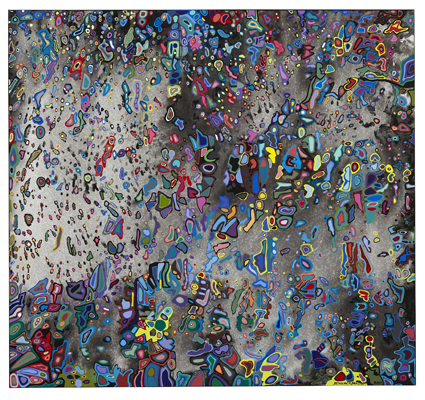
Bronwyn Bancroft. Paradox Of Inequality
courtesy the artist and Carriageworks
Bronwyn Bancroft. Paradox Of Inequality
In February-March, Carriageworks presents a Bronwyn Bancroft exhibition, Passion Power Politics, in which the Aboriginal artist addresses personal and cultural identity in contemporary Aboriginal life. Later in the year, Indigenous contemporary music will feature in Redfern Station, headlined by The Medics and Microwave Jenny and including Sydney-based Gadigal Music artists Marcus Corowa and Jess Beck.
Given Havilah’s commitment to Asian-Pacific Art, so evident in her three-year Campbelltown Arts Centre project, The Edge of Elsewhere (in collaboration with Gallery4A), with its intensive engagement between visiting artists and local communities, doubtless art of the region will figure in her programming. That’s for the future, she says. In the meantime she’s co-presented, with Creative Asia and the City of Sydney, Sound Kapital for the Chinese New Year Festival. It featured a one-night stand by three cult bands from the Beijing underground: AV Okubo, Xiao He and PK14 plus Matthew Nierderhauser’s video projections of the Chinese punk scene.
Havilah thinks it vital that resident companies at Carriageworks are firmly identified with it in the public mind. In March, Carriageworks is presenting the riveting and bitterly funny The Table of Knowledge by version 1.0 (a co-production with Wollongong’s Merrigong Theatre Company; RT104 and RT105). In August, version 1.0 and ATYP [Australian Theatre for Young People] are collaborating on The Tender Age, an exploration of the interplay of shifting sexual mores, the mass media and social technologies. Performance Space will stage Dimension Crossing in April-May with performance works by Sydney’s Victoria Hunt and Melbourne’s Yumi Umiumare plus installations by Robyn Backen and Michaela Gleave.
Havilah has her on eye on emerging local talent, taking on Strings Attached, a promising physical theatre company, in A Return to Trees, “an interdisciplinary future of complex aerial systems, sound and light” in May this year. Another group that has impressed Havilah is Milk Crate Theatre, a company that works with homeless communities, bringing them together in September in Fearless with professional artists, in this case singer Christa Hughes, composer Daryl Wallis and playwright Mira Todd, to explore that moment when people leap into the unknown. Hip-hop has an ongoing association with Carriageworks which will present Platform Hip-Hop in October, a two-day celebration of the form with workshops, forums and performances
Performance Space’s second season (October-December) titled Sexes featuring works addressing “the sexed identity.” Curated by Bec Dean, Deborah Kelly and Jeff Kahn, the impressive line-up of artists from around the country includes Eric Bridgeman, Philip Brophy, Bindi Cole, Marley Dawson, The Kingpins, Paul Knight, Pilar Marta Dupont & Tarryn Gill (See RT105), and Christian Thompson.
nationally
On the national front, Thyestes (see p4) from Melbourne’s Hayloft in the 2012 Belvoir program was seen as part of the Sydney Festival. Performance Space will show Mobile States’ Show On, featuring Geelong’s Back to Back Theatre’s film The Democratic Set; Brisbane’s Christine Johnson, Lisa O’Neill and Peter Nelson in Rramp, “an electronic dance metal rock set reflecting on…collections, animal love, social commentary, childhood imaginings and human fraility;” from Melbourne, Thrashing Without Looking, a show created with and for an audience wearing video goggles; and, also from Melbourne, Tamara Saulwick’s Pin Drop—an “audio-sensory” work exploring fear in the everyday.
Havilah is deeply impressed with Adelaide’s Restless Dance Theatre’s dance film triptych, Necessary Games which Carriageworks will present in November. It will be accompanied by a public forum and a live performance by Lorcan Hooper and Lachlan Tetlow-Stuart who feature in Moth, the Reeldance award-winning short film in the trilogy.
Other activities in Carriageworks’ 2012 program include master classes conducted by resident companies: Erth (on puppetry), version 1.0 (devising performance), Stalker (devising physical and dance theatre) and Force Majeure (devising physical theatre). New work will be developed by Erth, inspired by Nick Cave’s Murder Ballads; Optimism by Max Lyandvert and Anna Tregloan will explore the relationship between fiction and history for an audience to enter “through individual pathways”; Force Majeure will extend their 2011 emerging directors, choreographers and dancers gathering into a public performance; Stalker will explore relationships between movement, space and technology in Encoded; and emerging Aboriginal theatre group, Moogahlin Performing Arts, looks at the return of three women in aged care in Redfern to country.
internationally
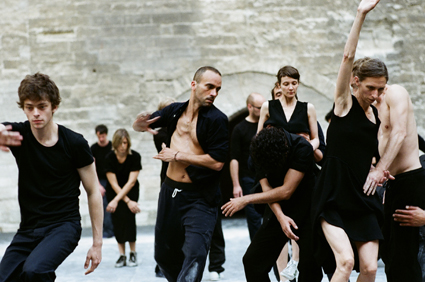
Rosas
courtesy the artist and Carriageworks
Rosas
On the international front, Sydney’s wickedly droll The Fondue Set join New York choreographer Miguel Gutierrez to present three new solo works in April for one night only.
In September, in collaboration with the Biennale of Sydney, Carriageworks will present the only Australian appearance from Belgium of Anne Teresa de Keersmaeker’s dance ensemble Rosas in two works, En Attendant and Cesna. Each work explores the relationship between music, dance and ephemerality with design by Ann Veronica Janssens, a leading Belgian artist whose works reputedly challenge the senses with her use of light, artificial fog, projections and sound. Janssens will also exhibit an installation in the Carriageworks foyer and another on Cockatoo Island as part of the Biennale.
Indian artist, Mumbai-based Nikhill Chopra, will also occupy the Carriageworks foyer with his large-scale drawings which are a component of the artist’s endurance performances in which he creates characters from Indian colonial history and his own life. Chopra’s visit is part of the Australia India Exchange Program which will take Australian artist Justene Williams to India to create a new work.
At the end of our conversation I ask Lisa Havilah if she sees Carriageworks becoming part of the growing number of networks that take performance around Australia. She replies in the long-term yes, but first Carriageworks has to firmly establish its identity, producing its own program, above all declaring itself not a venue for hire, but a site for curation, development and for the consistent presentation of multidisciplinary contemporary art.
in the house
At the same time as constructing the program that is the key to her vision, Lisa Havilah has ventured into making Carriageworks more attractive and user-friendly. The cafe area has been transformed into the JohnandPeter Canteen, granting that space a life of its own, while the issue of the foyer bar is being addressed so that it can reliably become somewhere for audiences to snack and drink pre- and post-show (always a challenge for venues but one that has to be met). The once opaque, long front window is now transparent making the building feel more welcoming at first sight and the interior signage in the foyer is more intelligible and coherent. It’s relatively early days in the Havilah regime but a cogent multidisciplinary program and support for local artists and culture in a national and international context suggest promise is on the way to realisation.
You can read the Carriageworks 2012 program at www.carriageworks.com.au
RealTime issue #107 Feb-March 2012 pg. 17
© Keith Gallasch; for permission to reproduce apply to realtime@realtimearts.net
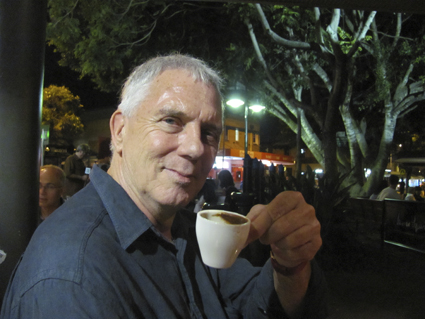
Douglas Leonard at Cha Cha
photo Jenny Pineapple
Douglas Leonard at Cha Cha
I WAS SHOCKED AND SADDENED TO HEAR OF THE SUDDEN DEATH OF OUR LONG-TIME BRISBANE CORRESPONDENT DOUGLAS LEONARD ON FRIDAY DECEMBER 9, 2011. I WASN’T A CLOSE FRIEND, RATHER A FOND ACQUAINTANCE OF A MAN WHOSE THEATRE DIRECTING I’D ADMIRED IN ADELAIDE IN THE 1980S AND WHOSE WRITING THIS CENTURY FOR REALTIME WE ALL TREASURED.
Douglas wore his considerable learning lightly and wrote elegantly and generously about live art, contemporary performance, circus and adventurous theatre, whether mainstream or independent, if with a preference for work that was raw and courageous. Finding writers with Doug’s breadth of appreciation of form and ideas is no easy task. A few months ago we asked him to provide material for a writer profile, but he preferred not to, shyly declaring himself “a raver rather than a writer.”
Keith Gallasch
* * * *
“All theatre is about death,” pronounces Douglas Leonard in a filmed interview (Thanatonauts—Navigators of Death, by Igneous) recently screened at his own funeral. “Let’s think about the social value of death. Let’s bring back existential terror to this life which would be perhaps a grace to those who claim to be artists in this world rather than consumers.”
As a Glaswegian migrant growing up in working class Sydney and Mt Gambier, a scholarship placement at St Peters College Adelaide offered Douglas both a nurturing ground for his intellect and a close-up view of social disparity cutting the more deeply when impecunity prevented him taking up an Oxford scholarship. But in 1967 he took a one-way boat trip to London. His first theatre involvement was with agit-prop and political theatre whilst employed as a youth worker in projects such as the Hoxton Cafe and Centreprise. He trained with Cicely Berry, Jerzy Grotowski, Jacques Le Coq and the Netherlands-based International Theatre Research Laboratory known as KISS.
After returning to Australia in 1974, turbulent years were spent preparing for the anticipated revolution. For Doug and his coterie this meant intellectual preparation, deep soul searching and bracing self-criticism, traits he has been known for ever since, in his effort to live ethically in the public realm. The underside to this was an abiding anger both personal and socially inspired that he strove hard to reserve for private catharsis and as a tool for the greater good.
When he moved to develop a community theatre it was, he would later attest, “as an arena for social action” with vanguard inclusive policies toward women’s initiatives, Asian content, ethnic diversity and the homeless—always one or two sleeping under the stage! The invitation of a friend to direct her WEA drama students in their final show at the Sheridan Theatre set in train his infamous four-year run of provocative theatre with the Adelaide Theatre Group. From A Midsummer Nights Dream—“extraordinary theatre […] flawed all over but outrageous enough to get away with it” (The Advertiser, 1980)—to Wheelchair Willie, Douglas Leonard was pronounced “one of the most ingenious directors working in alternative and community theatre,” making the ATG Adelaide’s “unchallenged centre of exciting, experimental, innovative theatre” (The Advertiser, 1984).
After a prolific output in 1982 (when three of the five shows were named in The Advertiser’s ‘top 10’) Douglas initiated an intensive training laboratory refining his unique approach to voice work and the body in performance. He regularly achieved remarkable results both for stage and for life, from novice and untrained actors, high school students and even young offenders. His effect was transformative, frightening, intoxicating, changing the way people thought about theatre and themselves, opening the door to European performance aesthetics.
When the theatre’s continuity was contested, Douglas struggled on independently with no base or core troupe, nevertheless earning high critical praise for The Kid and Salvador La Libertad in the late 80s. Directing The Contortionists in 1990, he found his life partner in the show’s lighting and production manager, Anna Fairley. They took the opportunity of an invitation from Bill Rough to devise a show in Brisbane to break with Adelaide. Songs from the Hut created ripples in Brisbane theatre circles.
Moving into West End’s complex community of Aborigines, migrants, students, artists and leftists flush with the fervour of new political freedoms post-Joh Bjelke-Petersen, Douglas found he could combine his passion for high art, low life and broad political activism. He engaged in grass roots theatre (including a long association with Street Arts, later Arterial) nurtured fellow artists, initiated community actions and maintained a discourse contextualising local art and politics in a column, Artifacts, in the West End Neighbourhood News (1997-2000) before taking up an invitation to review for RealTime.
Aside from notable main-house works Ionalympus, Shadowboxing, Requiem for a Miner and the massive international collaboration Elektro-Sonic Interference at the Brisbane Powerhouse (RT45, p29, 2001) Doug moved increasingly towards creating a poetic theatre of ideas, experimental moments and performed enquiries (Uncivilised, The Modern Phytotherapist, Shooting the Sun) or festival installations that gave a voice to the marginalised.
He completed a degree majoring in theatre and philosophy late in life but never stopped studying, researching, reading widely, deeply and methodically and always discussing. A “bold critic and peculiarly astute commentator, his turn of phrase and critical capacity lay in his acute ability to interlock, cross-connect and disassemble within almost one thought or sentence,” observes media artist Keith Armstrong, who collaborated with Doug on Elektro-Sonic.
But “like many great but humble artists, he worked in the ‘shade’ even while contributing richly to the fabric of his community” points out curator and performance artist Rebecca Clunn. He hated smug certainty, loathed self-promotion and was never interested in the artifice of the arts industries—only in the work and the people doing it. And for their part it was a courageous few who were not afraid he might take them over a political edge that they didn’t want to cross. For those that were willing “He brought us back to the origins of what was important… the ‘why’ of the work, to enunciate those ideas clearly” (intermedia artist Suzon Fuks).
“A man of beginnings, openings and ideas, already in foment as they became released…he thrived on any chance to experiment with the limits—both physically and mentally” (Armstrong). “Let go” he would say. “Take yourself beyond safety. Just do it!” recalls long-time friend, Dave Erskine. He had always taken risks himself. He was once awarded “minus 4 stars” for a dark post-modern cabaret. Another morphed into a ‘whoosh’ exercise with fragments of text. But Doug was always prepared to ravage surface form in search of an authentic impulse. And mostly this was done with a shattering brilliance of dramatic judgement.
He took seriously the forum RealTime provided to generate a constructive feedback loop that might as deeply inform theatre makers about their own work as open a window on the work of others. “As a performance maker in Brisbane,” notes performer and creator Lisa O’Neill, “there have been very few people who have followed one’s arts practice so sincerely and thoroughly as Doug has with his writing and support. When we heard of Doug’s passing…it felt like we had lost an integral part of our practice…Typically he came each night, taking it all in; talking to the artists before, after and between acts in a continued effort to understand, document and discuss one’s work year after year.”
“In his writing as in life Doug was inclusive and without pretension” writes poet and artist Dusan Bojic, his consideration and clarity quietly obliging us to question and examine, to recognise his “unending recoil against any appearance of creative apoliticality and [to understand] his consistent railing against the monotheisms of a bland, brokered status quo” (Armstrong). Hugh Watson described him as “a one man Prague Spring, a gentle ongoing seminar reminding us of the importance of art in life and politics in theatre, whose major intellectual interest was seeking a praxis between post-modernist insights and a left social activism—a project that was unfinishable and was interrupted by his death.”
“Many treated him as a genius, a confronter, a rebel, a man with a huge plan in the innovation of theatre. But Doug Leonard was a man with a dark side that doubted himself. And the closest friend you could ever wish for” (Glenn Rafferty who assisted Douglas throughout the 1980s). While others flung themselves at the world, Douglas progressively cultivated a certain timelessness.
Up at 5am, tai chi on the deck, a book or two devoured before breakfast, a game with the cat, a meeting or call to old friends or young artists—for he cherished the rich exchange of ideas they afforded. And thence to the coalface—be it agonising over the right tone for a review or helping out in community gardens.
For, in Anna’s words, this “man of bright warmth, sharp humour and a sublime and restless intelligence loved, above all, spaces. Spaces between people, created by gatherings, words, images and as a place (aka the theatre) into which he could pour his mind and soul, just to see where the edges were. He also knew in a profound way that the real work of creativity in any field of endeavour was done both in the still of the heart and the night, and equally in the company of friends.”
Indija Mahjoeddin
“The end is sort of finis without titles…but existential terror, fear, trembling, anguish, despair, a pint of vodka in the morning is the wonderful life of death!” Douglas Leonard, born Glasgow July 21,1945, died Brisbane December 9, 2011.
Indija Mahjoeddin thanks Anna Fairley, Keith Armstrong, Hugh Watson, Dusan Bojic, Suzon Fuks, Rebecca Clunn, Lisa O’Neill, David Erskine, Glenn Rafferty and many others for the information and reflections they provided. See Douglas Leonard talk about death: www.youtube.com/watch?v=YHgF3FidQtY
RealTime issue #107 Feb-March 2012 pg. 18
© Indija Mahjoeddin; for permission to reproduce apply to realtime@realtimearts.net
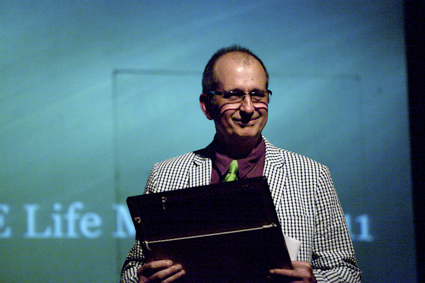
Henry Dangar is made a Life Member of the Australian Screen Editors Guild
photo courtesy ASE
Henry Dangar is made a Life Member of the Australian Screen Editors Guild
FILM EDITING HAS BEEN CALLED THE INVISIBLE ART, AND ITS ROLE IN THE PRODUCTION PROCESS IS OFTEN OVERLOOKED OR UNDERVALUED. I’VE BEEN GOING TO FILMS ALL MY LIFE, AND I THINK I KNOW WHEN A FILM REALLY WORKS, AND I KNOW THAT THIS HAS TO DO WITH BOTH THE DIRECTOR AND THE EDITOR, BUT THE WORK OF THE EDITOR, IN PARTICULAR, IS STILL MUCH OF A MYSTERY TO ME.
Bobbie O’Steen, author of a highly respected book, The Invisible Cut (2009), says that “editors decide what you see on the screen, and for how long you see it,” while legendary Hollywood editor Walter Murch says, “film editing is now something almost everyone can do at a simple level and enjoy it, but to take it to a higher level requires the same dedication and persistence that any art form does.” He also says that “Good editing makes a director look good. Great editing makes a film look like it wasn’t directed at all.”
Like most of the production process, editing has changed dramatically with digital technology. When renowned cinematographer Don McAlpine received the Raymond Longford Award at the Australian Academy of Cinema and Television Arts (AACTA) Awards last month, he said that award had often marked the end of people’s careers, but he wasn’t going to let it mark the end of his; as the new electronic cameras are precise tools, and that computers “now allow us to tell stories that were once locked in our imagination—do you think I’m going to quit now?” he asked, rhetorically.
henry dangar: life member screen editors guild
Henry Dangar has worked as an editor in the Australian film industry for almost as long as Don McAlpine has been a cinematographer. He’s worked on Australian feature films from Stir in 1981 to Lucky Miles in 2008 and on iconic local TV drama from The Cowra Breakout in 1984 to Spirited in 2011. He was the initiating president of the Australian Screen Editors Guild and late last year was made a life member at the ASE Awards. Interviewing him after he’d received this honour, I asked him if digital editing had had a similar importance for him. He said that a whole world of possibilities had arrived with the change from physically editing the work print to editing using the computer. “Editing in the digital world is like opening a Pandora’s Box, which allows the `imagined’ to appear on the screen in a reasonably refined way. The possibilities are vast. It does take money, hard work and perseverance, but all is now possible, and very exciting.”
In many ways, he believes, “the creative work of the editor has become even more essential to the successful realisation of a script to the screen. Excellent crafting is to be treasured. However, it is a mistake to think that just by using the computer, good editing can happen quickly. I find the best work is done through reflection, consideration and review,” he says.
The Australian Screen Editors Guild is a very active organisation, with a lot of involvement from its 450 members nationwide. While NSW and Victoria are the two strongest branches, the guild has recently formed branches in WA and SA; ASE president Jason Ballantine says that “the guild is starting to hold events and to address issues that affect those local communities.” There’s a strong program of activities in the eastern states, including seminars, a free Avid course for members and screenings with Q&As. The new ASE website will be launched early in the year, and the guild offers a mentorship program and free membership to students to help develop their careers.
a fading future for apprentice editors
While most editors enjoy the changes digital technology has brought to the craft and to its role in the industry, the Guild is concerned that some changes have diminished the opportunities available to properly cultivate the next generation of editors. There are fears that the opportunity for junior editors to assist, collaborate with and learn from senior editors on the job has become very limited; while technical tasks can be learnt, editors believe that real skill comes through creative collaboration and the communication of the editor’s thought processes.
Henry Dangar agrees. “I do think it’s a shame that aspiring editors can no longer learn through an apprenticeship system—it’s just not in our vernacular anymore. Learning how to be an editor is really about the craft, about understanding just what it takes to realise a story and bring it to the screen. It’s something that is being lost in the rush to production, in the changes in budgets and schedules.”
However, he does believe that there are many media courses now that aim to fill that gap. “They offer a good foundation, but it’s practising the craft that’s crucial; and that’s where the apprenticeship system was so important, because craft can only be built up by practising, by making mistakes and learning from them. I used to have three Steenbeck editing tables—courtesy of Hans Pomeranz—and on one of those, several apprentices could be practising, but now budgets are structured so that it’s just the director and the editor and there’s no room for anyone else. I hope it’s not something we’ll be paying for in the future—if we’re not paying for it already. We don’t seem to have that culture of apprenticeship, of learning the craft, anymore—we’re just getting the films made.”
That said, Dangar believes that there are some good young editors coming through, and of course the thing about digital editing is that they can practice and learn on their own. “I’ve had students at an editing course that I’ve seen a year later, and they’ve made great strides working on their own,” he says.
increased shooting ratios: reduced editing time
There are other downsides to digital technology’s relationship to the editing process, especially in the incredible growth of shooting ratios, which can often be up to 100:1, compared to the more manageable 12:1 of the pre-digital age. The ease of shooting on digital has resulted in much more work for the editor, while tighter budgets and production schedules mean the same or less time to do the job. While the ease of working on the computer does alleviate this somewhat, tighter budgets are increasingly restricting the editor’s time on the film, preventing that collaboration through the whole production process (including the grade and the sound mix); it’s a significant loss, given that the editor is the only person who knows the picture frame by frame.
an editor’s life
Henry Dangar grew up in Armidale, coming from a family of farmers, but he couldn’t wait to get away after high school. He came to Sydney not knowing what he wanted to do (“I had no idea there was something called film editing,” he says), but through a friend got a job at ABC Radio in Forbes Street as a mail boy, before moving to ABC TV in Gore Hill, where he worked as an assistant editor for about four years. “The ABC, and life generally at the time, was very liberal and free, and for me it was very enlightening. Everything was done internally by different departments—drama, documentary, news—but it was possible to circulate between them, and work in music, light entertainment, on Countdown, on Aunty Jack—you were exposed to so much and became really resourceful. There was a freedom to make suggestions without it being frowned upon, and there were so many interesting people moving through the ABC, you were exposed to so many ideas. And people were so interested in film, rushing off to see new films, and to the film festival—even taking two weeks off to attend the whole festival. I met lifelong friends at the ABC—Geoff Burton, Nick Torrens…”
After four years there he left and went travelling in Europe for a year. “When I returned I just presented myself as an editor and worked freelance—some TV drama, some sound editing for Grundy’s and Robert Bruning. Then I met Stephen Wallace, who gave me my first real opportunity, editing his long short film, Love Letters from Teralba Road (1977) and then his first feature, Stir (1980). And from then on I was really working in film and that was what I had wanted to do. Meeting Stephen really started that for me.”
It’s been a long career, working on an amazing list of film and television work. Dangar has a good opinion of many of the films he worked on: Kiss or Kill (1997; he’s had a long and creative working relationship with Bill Bennett), Winter of Our Dreams (1981), Travelling North (1987); but of Stir in particular he has very fond memories. And having seen the restored print, he believes “the film holds up fantastically well, and that’s due to really good storytelling on Stephen Wallace’s part.”
For Dangar, it’s the pacing and the rigour of the storytelling that make a film work. “Films that I respond to most are ones that tell a human story, have a strong point of view—and lately I’m finding that TV series like Rake, My Place and Spirited do that. From my experience, when those things are in place, when the script is confident and the director is confident, then the whole thing is elevated, and for me it’s much more interesting, but you don’t get that all the time.”
I asked him what it is like working with directors, and he answered thoughtfully that “One has to speak honestly, but you have to find the right time. It’s truly a collaborative process, and it’s quite intimate. It’s part of the role of the editor to make the director feel confident, but you have to judge the right time to speak. You have to allow the director, especially when they’re also the writer, time to trust you as the editor. In many ways the editing room is a very private place—you develop a relationship in there that involves trust and responsibility, and that takes time. But it’s through that relationship that you can deliver something new and exquisite—those who are more prescriptive actually deny themselves the opportunity to do that. But even in those situations where the creative relationship isn’t as good as it could be, I try and find an aspect of the project that is worth exploring, and that helps me through. You need to really understand the world that’s being created, the story that’s being told, the milieu, the tone.”
A film that he particularly admires is The Social Network (2010). “I don’t know whether many people know that the editor of that film is an Australian, Kirk Baxter, and that he won the Oscar for editing it last year…I don’t think people realise how wonderfully crafted that film is, how it uses all the tricks it can to tell a story at a higher level.” In fact, Kirk Baxter has been working with the film’s director, David Fincher, and with another editor, Angus Wall, for some time. He was nominated for an Academy Award for his work on The Curious Case of Benjamin Button (2008) and is nominated again this year for The Girl with the Dragon Tattoo (2011). He now lives in New York and mainly edits commercials, but says that he “feels very very blessed to have a partnership with Angus Wall and David Fincher.” He was disappointed that Fincher was not nominated for best director in this year’s Academy Awards.
Jean-Luc Godard says that “editing is the transformation of chance into destiny.” I don’t really understand that at all, but after talking to Henry Dangar, I think I understand just a little more about what it means to be an editor.
2011 australian screen editors awards
Award winners at the 2011 Australian Screen Editors Awards, held late last year, were: Avid Award for Best Editing in a Feature Film—Dany Cooper ASE for Oranges and Sunshine; Blue Post Award for Best Editing in a Documentary—Antoinette Ford for Girls’ Own War Stories; Digital Pictures Award for Best Editing in Television Drama— Martin Connor for Spirited, Series 1, Episode 2; Omnilab Media Award for Best Editing in Television Non-Drama—Denise Haslem ASE for On Trial, Episode 1; EFILM Award for Best Editing in a Commercial—Bernard Garry ASE for NAB 3 Year Olds; AFTRS Awards for Best Editing in a Short Film—Melanie Annan for Something Fishy; and the Level Two Music Award for Best Editing in a Music Video went to Matt Osborne for WA band Schvendes’ Lay the Noose.
RealTime issue #107 Feb-March 2012 pg. 19
© Tina Kaufman; for permission to reproduce apply to realtime@realtimearts.net

Jonathan LaPaglia (Hector), Sophie Lowe (Connie), The Slap
IT’S INTERESTING HOW YOU REWRITE A BOOK AFTER YOU HAVE READ IT. AS I WATCHED THE SLAP UNFOLD SLOWLY OVER EIGHT WEEKS ON ABCTV, I BELIEVED CERTAIN THINGS HAD BEEN CHANGED—CHARACTERS SHIFTED ABOUT, EXTRA PLOT POINTS ADDED—BUT WHEN I REVISITED THE BOOK IT WAS MY MEMORY THAT HAD MADE OMISSIONS, HAD CHOSEN CERTAIN BITS TO ELEVATE OR TO FORGET (WHERE IT SUITED ME).
Christos Tsiolkas’ fiction (on which the series is based) has been a stunning success for an Australian novel (and they say Australians don’t read local contemporary literature) and has also sold well in the UK (it was on the long-list for the Man Booker Prize). It’s been critically acclaimed but has also appealed to or enraged the punters, depending on who you talk to. The translation to screen has engaged considerable film and writing talent—Tony Ayres, Brendan Cowell, Robert Connolly, Cate Shortland, Matthew Saville, Emily Ballou— and the series is a bitter-twisted snapshot of Australian culture: where we came from; what we’re doing; where we’re going.
I’ve never had so many arguments about a book/TV show. Everywhere I went— parties, book launches, meetings—people were talking about it. Most hated the characters, seeing them as self-absorbed, selfish, self-loathing, all those ‘self’ words it’s best to avoid, but they were still tuning in. “I can’t relate to them,” said a friend. But I could (oh the shame of it). I knew people like that; perhaps it was better to keep it quiet. And besides, as Charlotte Wood has recently pointed out (in Newswrite magazine), do you really need to relate to characters in order to love a fiction? Tsiolkas has been accused of misogyny because of the way his characters behave. As Tsiolkas retorted, “I think they are confusing the writer with the character. I think there’s a laziness now in how we read [or view]. We read for confirmation of who we are, rather than for a challenge of who we are.’
One of the reasons The Slap has struck a chord is because it’s a highly effective and distilled concept. It’s easy to break down into a synopsis: someone you barely know slaps your kid in the face at a barbie. Is this acceptable behaviour? Discuss. Thrown into the mix are the kid’s parents who offer the boy no boundaries; his mother, Rosie (Melissa George), in a monumental push-me-pull-you struggle, still breastfeeds him at four years. I suspect this may be more offensive to many viewers than the violent Harry (Alex Dimitriades) beating his wife. Why does breastfeeding older children draw such ire? It makes people angry, uncomfortable, deeply suspicious. Is it because the act is suddenly sexualised when the suck is no longer from a baby? Is it because it forces the men at the table to have to look away? While these days many are reluctant to make judgements aloud, parenting is something everyone has strong opinions on and, as a mother, you feel constantly on show. In the end, the series becomes more about the reactions to the slap than the slap itself—about the need to be perceived as doing the right thing, even if you’re falling miserably short.
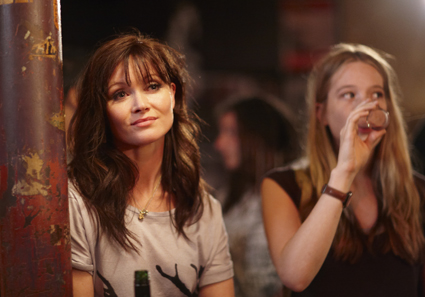
Essie Davis (Anouk), Sophie Lowe (Connie), The Slap
The TV series does the book justice by taking its time to draw out characters (eight episodes, each focusing on one person), the director-writer teams capturing the essence with mood, dialogue and a changing soundtrack, while the central plots interweave throughout. Tsiolkas may have been accused of misogyny but in the series the episodes focusing on women—such as Anouk (Essie Davis) and Connie (Sophie Lowe)—are particularly strong. Anouk is caught between her desire to write and societal pressures to have children; there’s a sense that she is running out of time. She is always ahead of herself, checking her iPhone when she’s having sex, a woman distracted (just like her mother). Teenaged Connie, maturing quickly without her parents, is caught between a need for stability and wanting to rush at the adult world, swallowing it whole. As she vamps it up in her mother’s dress, longing for grown-up pleasures (jazz, cigarettes, red wine), she is too youthful to know that it is her naturalness, her youth, that Hector truly desires. Both actresses seethe and smoulder on screen. And the Manolis (Lex Marinos) episode is magnificent, the ageing Greek father-figure, so full of pathos as he rages against growing old, weeping for himself at a long lost friend’s funeral, at the constrictions of a lifetime spent under obligation.
The cross-cultural connections, collaborations, conflicts, bring the series to life. The opening episode, where English and Greek fly across the table, where translations are made, lied about or obscured, reveals underlying racial tensions. An Aboriginal man, now a Muslim, refuses alcohol while his wife wears a headscarf; they battle against a wave of distrust. Tolerance exists only on the surface. Tsiolkas is a master of dialogue and it flows effortlessly on screen. We hear snippets of conversation as we would at a party. Secret women’s business shows them huddled, one word enough to dissolve friendships, or to make them laugh, or to suggest sexual conquests. Shared cultural references bring people together: “Adam used to play with himself in front of Play School.” “You can’t blame him, that Jemima’s a sexy minx.”
Tsiolkas is also fond of wankers (perhaps too much so). In his novel The Jesus Man I had to eventually stop reading, before I reached the climax, because I was afraid I might go blind. In The Slap he goes soft on his masturbatory syntax: Connie, Hector, Harry, all experience wankus interruptus—Connie in the fear of the size and shape of things to come; the men constantly frustrated in their desires by the sound of their mothers’ voices, entreating and intruding through the bathroom walls, down the phone lines. It seems there is no escape from a mother’s control.
The series is let down by a couple of weak elements, most notably the laconic voiceover (that has annoyed many critics). William McInnes’ ironic narration jars at every turn, as it intrudes on the characters’ intimate spaces. He has a terrific voice, you know it like the back of your hand, but that’s the problem; it’s not the voice for this series. He pops up in Connie’s bedroom, when she’s reading a letter from her dead father. He’s in Rosie’s bathroom as she faces the mirror. You expect him to jump up from behind the couch and tickle you (like some creepy uncle) at any moment. The voiceover suggests last minute wrangling from producers anxious ‘the viewers won’t get it.’ It shows lack of respect for an intelligent audience, many already familiar with the book. Like the slap itself, it oversteps the mark, a cricket bat to belt us over the heads with. I’d love to see the series again with the narration removed; it would make it a knockout.
Charlotte Woods argues that “Giving life and voice to repellent or taboo feelings and ideas…not only recognises the complexity of human existence, but surely allows the freedom to bring into the light and examine the shameful, repellent parts of ourselves.” The Slap offers large slabs of shame, laid out for all to see, but ultimately it’s the multilayered perspectives, the intergenerational views—on character, on Oz culture, on gender, on race—that make the series exciting contemporary viewing.
RealTime issue #107 Feb-March 2012 pg. 20
© Kirsten Krauth; for permission to reproduce apply to realtime@realtimearts.net
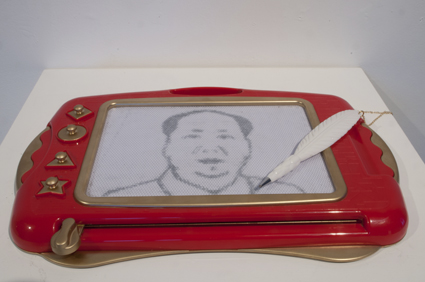
Eric Siu, Made in China #3 – Magna Doodle, 2011 One World Exhibition at Osage Kwun Tong
TIME IS VARIABLE IN HONG KONG. EVERY-THING SEEMS TO HAPPEN FAST— THE MTR (SUBWAY) TRAINS ARRIVE EVERY THREE MINUTES AND YOU CAN PRINT A SUBSTANTIAL EXHIBITION CATALOGUE THE EVENING BEFORE THE SHOW OPENS. EXCEPT, SOMETIMES EVERYTHING HAPPENS SLOWLY…LIKE PEAK HOUR TRAFFIC IN ONE OF THE THREE UNDER HARBOUR TUNNELS WHICH CONNECT HONG KONG ISLAND AND KOWLOON, OR THE LEISURELY PACE OF THE BACK STREETS WHERE RECYCLING HAPPENS BY HAND AND MANY LIVES ARE BICYCLE POWERED.
In another sense Hong Kong is indistinguishable from any other global hub of capital—it’s a gateway city of multiple cultural, financial and social perspectives. While cinephiles are sitting in the Kubrick Café at the arthouse Broadway Cinematheque sipping lattes, a handful of activists are still camped out underneath the HBSC building in the ongoing Occupy Central protest. Meanwhile thousands flock to the stages of Clockenflap—the two-day free multimedia arts music festival in West Kowloon.
alchemy
This notion of global culture was reinforced by the assembly of media art laboratories at Alchemy, the 15th edition of the Microwave International New Media Arts Festival. Art Science is an increasingly important player in both the art world and academia, with The Run Run Shaw Creative Media Centre at City University of Hong Kong, headed up by Australian Jeffrey Shaw, being a major partner in this year’s festival. Alchemy trod a fine line, as noted in Winnie Fu’s catalogue introduction, between recklessly embracing the novel and a considered engagement with process.
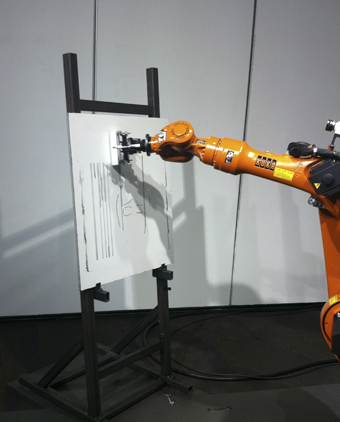
Autoportraite from RobotLab at Alchemy, Microwave Festival, 2011
The Hong Kong public, like any other, were simultaneously entranced and confused by the diversity of this evolving art form. Crowds lined up to have their portrait drawn by an autonomous robotic arm from Robotlab in Germany, while others wanted to buy the exhibition’s custom-made DIY Kitchen Bio Lab benches. Modes of exhibition varied from the highly formalised outcomes of nine-month art and science residencies at AIL Swiss artists-in-labs program, to the simple intimacy of the Time’s Up Kitchen, where cooking and eating together provided the basis for art project collaboration.
Hothouse groups like Lighthouse (UK) reject the idea of the genius artist, operating in teams to produce complex and interesting works, whereas etoy.CORPORATION, a privately held company in Switzerland, plays a twisting game between the corporate world and sharing culture. All these projects present models where engagement is aesthetic and metaphoric, existential, curious and poetic, as artists themselves often become the subjects of scientific experiments in an attempt to re-think and re-make the world.
diversity and change
Hong Kong being the most densely populated area on earth, it was not surprising to discover a correspondingly rich calendar of art and cultural events. During my three-month Asialink Residency I was immersed in a diversity of events from the biennial Architecture is Art Festival to the hilarious PitchYrCulture evening presented by my host Videotage. Founded in 1986 by self-taught video artist Ellen Pau, Videotage is Hong Kong’s leading network of media art and culture, and a platform to facilitate international exchange. By producing cross-disciplinary events like PitchYrCulture (a variant of Pecha Kucha) diverse cultural groups are brought together in fun participatory ways.
But dramatic changes are afoot in Hong Kong’s culture-scape, with major new arts precincts and a creative industries hub under development. With its first phase scheduled to open in 2016, the $2.8 billion West Kowloon Cultural District will house the 40,000 square metre M+ contemporary museum. M+ will display international contemporary culture: 20th and 21st century visual art, design, popular culture and the moving image. With a proposed staff of 400 the collection will be built from scratch, opening up a multitude of possibilities for commissions and acquisitions of media arts in the Asian arena.
On a more human scale the city is enlivened by rapidly changing commercial and non-commercial exhibitions at sites such as Hanart Square, Spring Workshop, Asia Art Archive, Para/Site and Fotan Open Studios. Osage Art Foundation platforms international and Asian contemporary visual arts, with each of their three exhibition spaces in Hong Kong focusing on a different aspect of contemporary and experimental practice. Smaller spaces such Input/Output and Robin Peckham’s Saamlung focus heavily on cutting edge media and critique of contemporary artwork.
Another side of Hong Kong’s media arts culture can be accessed at ACO Books (Art and Culture Outreach) in Wan Chai which houses several playful cats, bilingual, well-curated and eclectic art and activist works. ACO is the public interface of the Foo Tak Building, a vertical artists’ village with a Rooftop Farm growing organic food for consumption in its SLOW Experience restaurant. It’s also the event space where Dutch theorist Katrien Jacobs launched her latest book, Wandering Dolls: Cosplay Journey Across East Asia, which explores, amongst other things, Asian video games culture, cross-dressing and transsexualism.
one world exposition
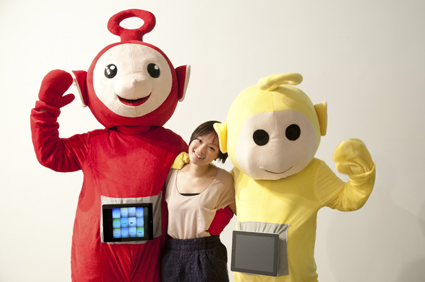
One World Exposition 2011: Li Zhenhua (left) and Ellen Pau (right) dressed as Teletubbies for the opening performance at Hanart Square, with Enrica Ho (middle)
Perhaps the most significant event during my residency was One World Exposition (OWE), an ambitious series of collaborations symposia, exhibitions, artist talks, performances and screenings of media art from Mainland China and Hong Kong. Gaining leverage from Hong Kong’s strategic position as both part of, and outside, the culture of greater China, OWE sought to reappraise the multiple concepts of Chinese contemporary art, reaching toward a self-defined artistic history and cultural identity rather than one constructed from an amalgam of foreign perspectives.
OWE could be seen as a counterpoint to the Shanghai Mingsheng Art Museum’s retrospective dedicated to video art in China: Moving Image in China:1988-2011. That survey of over 50 artists at Shanghai’s Redtown Arts Precinct was generally agreed to have curatorial restrictions and notable exclusion of artists. With international critical attention on contemporary Chinese art growing since the Beijing Olympics and the Shanghai World Exposition in 2010, OWE’s more critically engaged survey of technological art forms was timely.
Curated by Isaac Leung (Hong Kong) and Li Zhenhua (Shanghai/Zurich), and produced by Videotage, the works, performances and screenings were not so much about technological advances as smart use of technology and socio-political contextualisation. With a stellar cast of exhibitors and speakers too long to mention here, OWE presented an abundant schedule of events over its five-day opening festival.
Works ranged from the ephemeral splendour of Yang Fudong’s multi-screen narratives to the materiality of aaajiiao’s data tapes spewing from a black monolith. Ou Ning and Cao Fei’s highly stylised portrait of San Yuan Li, a traditional village besieged by China’s urban sprawl and Eric Siu’s illusionary products, such as an always lit cigarette lighter and a doodle pad poised to wipe out iconic imagery, intelligently engaged with the new culture of China.
Video game and martial art enthusiast Feng Mengbo presented his ongoing BLVP (Bruce Lee VJ Project), investigating Lee’s iconic stature. The raw appeal of classic street fighting footage with music from Beijing-based band New Pants melded seamlessly with the eclectic and glamorous surrounds of the “members only” Kee Club. Grooving along next to me was David Elliot, former Biennale of Sydney Director and current Artistic Advisor to the Hong Kong Jockey Club Charitable Trust’s new arts precinct development, who gave OWE the thumbs up on the dance floor.
With its exhibitions and screenings across multiple commercial and not-for-profit venues, OWE was driven by collaborations and juxtapositions rather than competition, showcasing not just the artworks but the diverse and strong media and contemporary arts community in Hong Kong. These small to medium organisations have a splendid vision, and nurture an upcoming generation of energetic curators who are producing more critically engaged, sharply focused media art events.
My sustaining sense of Hong Kong is that of swimming in the alternating accelerations and decelerations of cultural currents. By looking back to tradition, opening outwards to new trends, and self-reflexively peering inwards, the contemporary media arts movement assumes a zen-like spiritual and intellectual intelligence in the uniquely energised landscape of Hong Kong.
RealTime issue #107 Feb-March 2012 pg. 21
© Melinda Rackham; for permission to reproduce apply to realtime@realtimearts.net
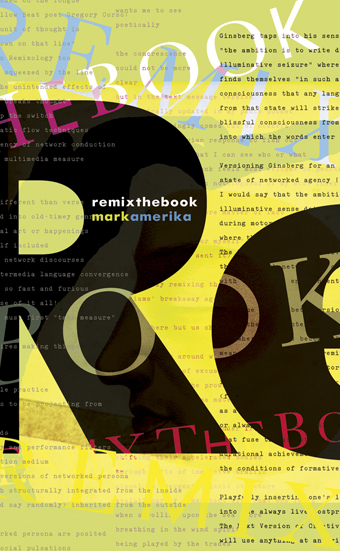
remixthebook, Mark Amerika
THERE IS SOMETHING ALMOST COUNTERINTUITIVE ABOUT TRYING TO REVIEW A PERFORMANCE LIKE REMIXTHEBOOK BY MARK AMERIKA. FOR A START, IT PRESUMES THAT YOU, THE READER, THE AUDIENCE, IS OUTSIDE OF THE WORK, ABLE TO VIEW IT FROM SOME IMPOSSIBLE PLACE WHERE YOU ARE NOT THE WORK BUT A MERE OBSERVER OF THE WORK.
For, of course, you don’t merely read the work, as if it is just there, taking up space until you turn your attention to it. You inhabit the work or it inhabits you, it almost doesn’t matter which because either way it is a symbiotic relationship—an interrelationship—which is the ground of all remixology—and so what you do is you play along, trying to keep up, feeling sometimes like a jazz musician learning to improvise over Coltrane changes.
“I didn’t know you had to learn to play…I thought you had to play to play.”
Ornette Coleman via Mark Amerika
remixthebook (and its accompanying and equally important online portal of the same name, of which I will write later) is too lyrical, too poetic, too inclusive and at times too joyous to really be described as a manifesto. In a sense that’s what it is because it makes manifest Amerika’s thinking about the places, practices and (yes) politics of art, creativity and the artist medium in networked digital culture. But it also enacts (performs) Amerika’s practice by doing what it says. That is, rather than being an extended didactic panel that describes (de-scribes, un-writes) his artistic practices, it is inscribed by the practices of which he writes. It is an extended theoretical, creative work whose subject matter is the work itself.
Drawing on the writings of whoever seems to suit his needs at any given time, Amerika is a “postproduction medium” who demonstrates in remixthebook his “aesthetic fitness” and understands
“what it means to be an artist-medium
one who transforms into an instrument
that acts on what ever ground is available”
“Sometimes you have to play a long time to be able to play like yourself.”
Miles Davis via Mark Amerika.
remixthebook is the product of more than 20 years of experimentation and play by Amerika in the fields of literature, online publishing, network art, video and academic scholarship. It is marked by the same generosity of spirit and collaborative compulsion that is discernible in so much of his work. Despite some misgivings about whether the writing of such a work takes away from “an economy of motion…that wastes no time-movement” necessary to be an artist
“(I ask this because sometimes writing out
an artist poetics itself feels like wasted motion
as it takes away from the primary bursts of
creativity immersed in its own potential)”
Amerika is also conscious that his work also constitutes an intervention into an ongoing debate (here as elsewhere) about the status of creative, practice-based research. In the foreword he notes:
“[M]y hope is that the remixthebook project will indicate to emerging artists and scholars, particularly those engaged in advanced forms of digitally processed, practice-based research, an alternative model of multimedia writing they can invest themselves in as part of a professional course of action.”
He repeated this at a workshop that we both attended in December, 2011 at the Centre for Creative Arts at LaTrobe University hosted by Norie Neumark and Maria Miranda arguing that it is up to established artists (particularly those already securely tenured to universities) to lead the way in experimenting with creative scholarship, running the risks for our younger colleagues by stepping outside of the (sometimes arbitrary) line that demarcates acceptable ‘outputs’ from unacceptable ‘outputs’ in the audit-culture crazed bureaucracies that our universities have become.
“To be clear
it’s not an attempt to overacademicize one’s practice
or to generate extra brownie points
for some abstract reporting system
that supposedly benefits the workaholic professor
Hardly”
That remixthebook is more than a book of/about remix, in its currently hollowed out, piracy/plagiarism-obsessed media guise, is clear from the source material it finds everywhere. Alfred North Whitehead rubs up against Kathy Acker while Ginsberg looks on asking, “Yes, but can you make it come?” William S Burroughs cuts it up on the dancefloor to the sounds of Vilém Flusser’s The Gesture of Writing (out now). Bruce Lee mimes Nam June Paik’s Experimental Television while insisting that “the most productive, creative person is a person who has NO CHARACTER.”
It’s easy to see why Amerika aligns himself with Paik’s assertion that “[t]he culture that’s going to survive in the future is the culture that you can carry around in your head.” His head is so full of such riotous energy that it must be a fun place to be.
“our ultimate aim as postproduction mediums
is to see the mind at work
to see the mind in the work”
Visit www.remixthebook.com and you can see the results of Amerika’s willingness to collaborate in the form of remixes made from both the book and audio-visual material of the artist reading from the book. Along with co-curator and artist Rick Silva, Amerika has invited over 25 international artists, poets and critical theorists, all of them interdisciplinary in their own practice-based research, to sample from remixthebook and manipulate the selected source material through their own artistic and theoretical filters. Yoshi Sodeoka’s An Artist Yapping about Some Art Stuff X4 features a Rushmore of Amerikas, sped up and slowed down for comedic effect. Performance artist Michelle Ellesworth takes Amerika’s ideas to her local supermarket to see if she can apply them to grocery selection and food preparation in Food Remix. Maria Miranda and Norie Neumark form The Art of Walking from Agnès Varda’s Vagabond, their own online project Museum of Rumour and Mark Amerika’s Sentences on Remixology 1.0. Darren Tofts’ And we shall play a game of chess (also performed by Tofts and Amerika at Ctrl-Z Writing in the Age of New Media, Fremantle Arts Centre in November, 2011, see review page 25) plays off the dialogic nature of Amerika’s writing to imagine a chess match played between Marcel Duchamp and one of Amerika’s alters, Professor VJ.
As well as the remixes, remixthebook.com hosts a series of guest blogged responses from an army of well-known artists and writers and a gift, for anyone interested in either learning about or teaching remixology, in the form of online course notes. While one might, in others perhaps, dismiss these gestures as the artistic equivalent of a “free set of steak knives with every purchase,” one senses that Amerika, the artist and the person, is more interested in getting his audience/collaborators to play along with him, to form an ensemble with the kind of creative verve one associates with jazz or blues. I’ll see your riff and I’ll raise you a new melody. Which is not the same as saying that he thinks we need to give it all away for free (unless you understand that it is “free” as in “free speech,” not as in “free beer”). How art gets made and where the next pay cheque/meal/experience is coming from in the “world of turbocharged technocapitalism” is never that far from his (or any other artist’s) mind. But what Mark Amerika’s words and deeds make clear is that it isn’t going to get made alone, unconnected, in some lonely studio, standing still.
“Find a way to make art
while simultaneously innovating your practice
while simultaneously spiritualizing your practice
while simultaneously marketing your practice
while simultaneously enflaming your practice”
Mark Ameika, remixthebook, University of Minnesota Press, Minneapolis, 2011. The companion website for the books resides at www.remixthebook.com
RealTime issue #107 Feb-March 2012 pg. 22
© Lisa Gye; for permission to reproduce apply to realtime@realtimearts.net
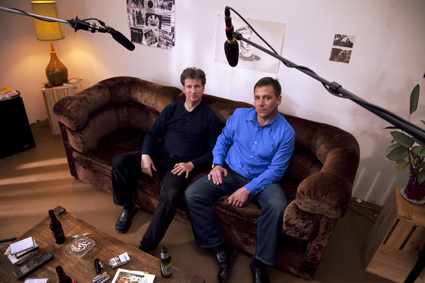
Eddie Guerriero, Mitchell Deprey, Shut Up Little Man!,
photo Nick Matthews
Eddie Guerriero, Mitchell Deprey, Shut Up Little Man!,
IN THE MID-1980S, TWO YOUNG MEN FROM WISCONSIN, ‘EDDIE LEE SAUSAGE’ AND ‘MITCHELL D,’ ARRIVED IN SAN FRANCISCO, FRESH-FACED AND EAGER TO EXPERIENCE BIG CITY LIFE.
Moving into a block of flats “made out of snot and cardboard” (dubbed the “Pepto Bismol Palace,” its sickly pink colour resembling that of the antacid medication), their enthusiasm was soon shattered as they encountered the pair of old men living in the apartment immediately adjacent, Raymond Huffman and Peter Haskett, whose expletive-laden exchanges provoked terror and sleeplessness for the callow Eddie and Mitch.
Spending their days guzzling cheap vodka and unleashing foul-mouthed vitriol upon one another, Huffman and Haskett provided the youngsters’ first experience of life for the long-term unemployed, their fear spurring them to begin recording the abusive sparring reverberating through the walls. The young guys’ motivations shifted however as it became apparent that the torrents of abuse from Peter (a floridly camp gay man) and Ray (a caustically belligerent homophobe) resembled more the mundane squabbling of an old married couple than the precursor to any real violence. They became obsessed, making cassette tapes and distributing them amongst friends who soon disseminated them across the United States where they rapidly developed a cult following.
South Australian Matthew Bate’s documentary Shut Up Little Man! (named for Peter’s trademark dismissal of his roommate) explores the resulting influence that Eddie and Mitch’s recordings have had in American pop culture as well the ethical dilemmas that arise from such use of furtively obtained material. Bate has assembled a slickly produced combination of interviews with primary participants (including Mitch and Eddie, as well as Peter and Ray’s occasional third housemate Tony Newton), interviews with artists who subsequently created work inspired by the recordings, archival footage, re-enactments of Peter and Ray’s antics, as well as excerpts from the recordings themselves.
Whether or not one finds the material humorous—and the appeal is pretty juvenile—the fact remains that many have, the recordings receiving an extended life as a pre-internet example of the ‘viral’ pop-culture phenomenon. Copied and passed on individually through the pre-digital American Tape Traders Network, they were released commercially by the underground magazine Bananafish in 1992. Ray and Peter’s rambling cries of “If you wanna talk to me then shut your fucking mouth!” and “I am the human race you fucking queer!” have been subsequently incorporated into the work of artists as diverse as Daniel Clowes, creator of the Ghost World graphic novel, film director Mike Mitchell, who made Jim Henson-style puppets with which to dramatise the recordings, and surrealist post-punk icons Devo’s side-project The Wipeouters who wrote a song incorporating snippets of the pair’s ranting, a strategy also utilised by New York avant-garde composer John Zorn.
Although the idea is not raised by Bate, in this way the recordings amount to a cultural ‘meme,’ a term coined by Richard Dawkins in The Selfish Gene that “conveys the idea of a unit of cultural transmission, or a unit of imitation.” However, such a conception is somewhat complicated by Mitch and Eddie’s decision to copyright the material after the success of playwright Gregg Gibbs’ 1993 comic drama Shut Up! Little Man, leading to acrimony during the mid-90s as three separate film projects vied for exclusive use of the recordings. Putting aside the question of whether it is even possible to copyright audio verité (defined by the filmmakers during the title sequence as “a term used to describe real-life recordings made surreptitiously: found sounds and phone pranks”), there remains the problem of Ray and Peter’s invaded privacy and whether the artistic use to which their lives have been put amounts to an acceptable tradeoff.
Though certainly diverting, it’s difficult to escape the sense that Bate has paid the subject matter far more attention than it really warrants—something aimed at a television slot might have been more appropriate. Nor do the filmmakers ever adequately address the issue of class that lurks uncomfortably in the background. Have Mitch, now a life insurance salesman, and Eddie, a rare and used book dealer, been merely middle-class voyeurs, able to return to a comfortable suburban existence while Huffman and Haskell succumb to diseases stemming from their chronic alcoholism in the mid 90s? Bates leaves this unexamined, instead focusing on a universalising ‘human element’ that elides the broader economic and social forces that have led to the pair’s degradation. Are the recordings exploitative? Almost certainly. But as Eddie comments in the additional interview material, “If there’s exploitation, then the filmmakers are complicit in that.” And, so by extension, is the audience.
Shut Up Little Man!, An Audio Misadventure premiered at the 2011 Sundance Film Festival and was officially selected for the Edinburgh, Adelaide, Melbourne and other international film festivals.
Shut Up Little Man!, An Audio Misadventure, director Matthew Bate, producers Sophie Hyde, Matthew Bate, cinematography Bryan Mason, music Jonny Elk Walsh, Closer Productions. 87 minutes. The DVD is produced by Madman Entertainment.
RealTime issue #107 Feb-March 2012 pg. 23
© Oliver Downes; for permission to reproduce apply to realtime@realtimearts.net
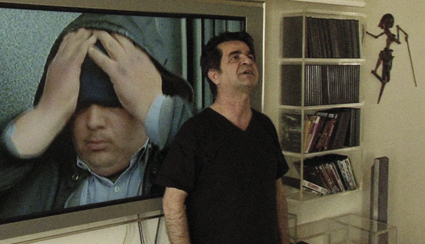
Jafar Panahi, This is Not a Film
IF MANY AUSTRALIANS WRITE OFF CINEMA AS MERE ENTERTAINMENT, DICTATORIAL REGIMES ARE MORE CONVERSANT WITH THE POWER OF FILMS TO MAKE US THINK, FEEL AND SOMETIMES ACT. WHICH IS WHY SUCH REGIMES PLACE SPECIAL EMPHASIS ON CONTROLLING THEIR FILMMAKERS—AN INCREASINGLY TOUGH TASK IN THE DIGITAL AGE, AS IRANIAN DIRECTOR JAFAR PANAHI SHOWS WITH THIS IS NOT A FILM.
Panahi is one of Iran’s best-known directors, whose neorealist-inspired portraits of contemporary Iranian life have garnered numerous awards globally, including the Golden Lion at Venice for The Circle in 2000. In July 2009 he was arrested for his support of protesters killed following Iran’s disputed presidential election earlier that year, and eventually sentenced to six years in prison. More crushingly for an artist of Panahi’s standing, he was also banned from making films or leaving Iran for two decades.
While under house arrest pending the outcome of his appeal in March this year, the frustrated director began filming his daily routine with a video camera. Quickly concluding these self-conscious observations of his own confinement were “a lie,” Panahi invited his friend and fellow filmmaker Mojtaba Mirtahmasb to his apartment to help out, and began describing the film he was making at the time of his arrest. Ironically the aborted project was a tale of frustrated ambitions, about a young girl locked up by her family. Determined to leave some record of this unfinished work, Panahi lays out a set on his living room floor using gaffer tape and takes Mirtahmasb through the opening scenes of the script.
Until he suddenly stops and lowers his head.
“What’s wrong?” Mirtahmasb asks from behind the camera.
“Wait a moment,” Panahi replies. After a pause he starts talking again, but gives up after a few words, muttering “If we could tell a film, then why make a film?” Overcome, he quietly swears and disappears into the other room.
Panahi’s description of his unmade drama is punctuated by tales of other forcibly abandoned projects. This sad litany of unrealised dreams reminds us that the inhumanity of dictatorial regimes lies not only in the cruelties they inflict, but also in the possibilities they forestall. For all Panahi’s frustrations, however, there is a kind of victory in the fact that we can watch these scenes in a cinema far from Iran. As Mirtahmasb comments at one point, in the present situation the most important thing is to keep the cameras rolling and create a record of what’s happening—even if it’s a document of enforced inactivity. As they talk, Mirtahmasb urges Panahi to pull out his iPhone and start shooting his act of filming. “It’ll be a record of me if I get arrested,” Mirtahmasb says with a nervous laugh.
Then, unexpectedly, a small drama intrudes from the outside. As Mirtahmasb departs, a young man calls in to collect the garbage, and Panahi decides to follow him on his rounds. For viewers, even a move to the elevator feels like a kind of freedom after more than an hour in the apartment.
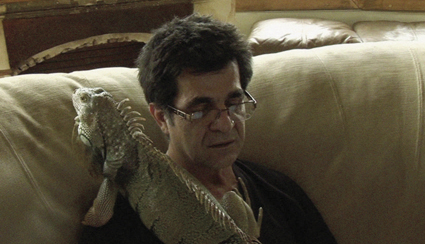
Jafar Panahi, This is Not a Film
As they go from floor to floor, Panahi chats with the good-natured garbage man, who recalls being present the night the director was arrested. “What happened?” Panahi asks, but the man’s memories are comically interrupted every few seconds as he darts out to collect the rubbish on each landing. In the end he never gets past the opening lines of his story.
The moment of light-hearted flight is brief. When the elevator reaches the basement car park, the young man heads out to the street with his wheelie bin, warning Panahi not to follow: “They’ll see you with the camera.” The director is left to frame the obscured view of a bonfire burning outside the gate. We know from earlier conversations this is a New Year celebration, but the flickering light fed by gasoline is eerily reminiscent of scenes from the civil unrest that led to Panahi’s current situation.
It hardly matters whether everything we see in This is Not a Film is a setup or the spontaneous interaction with reality we’re led to believe. Panahi is, after all, a master at searing his dramas with the spark of reality. This may not be the project Panahi would choose to make, but it’s an emotional and engaging act of cinematic defiance from an imagination confined. In May the film was smuggled out of Iran on a USB stick and unveiled at Cannes. Yet even as his images have taken flight Panahi remains in detention, and This is Not a Film probably feels like a pyrrhic victory for the director. In September his collaborator Mojtaba Mirtahmasb was arrested, and the following month Panahi lost his appeal. If it’s true thst films can help shape the world, it’s equally true that images alone cannot stop a determined regime, even in the age of digital protest.
–
This is Not a Film, directors Jafar Panahi & Mojtaba Mirtahmasb, Iran, 2011
RealTime issue #107 Feb-March 2012 pg. 24
© Dan Edwards; for permission to reproduce apply to realtime@realtimearts.net


















































































